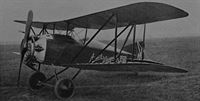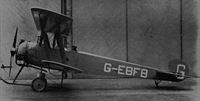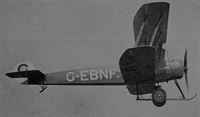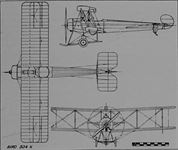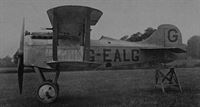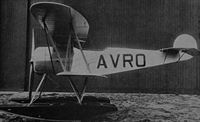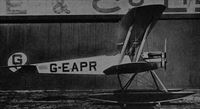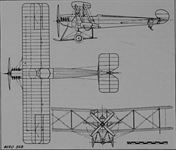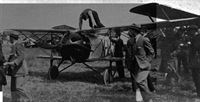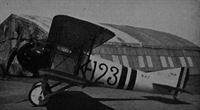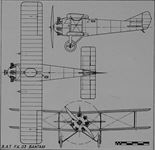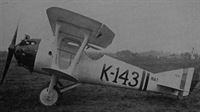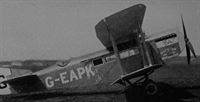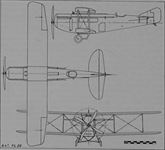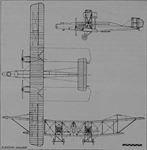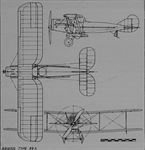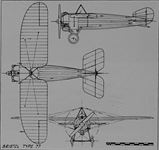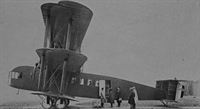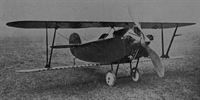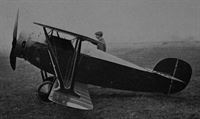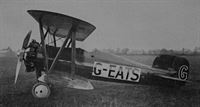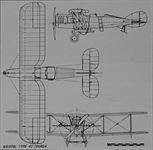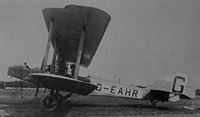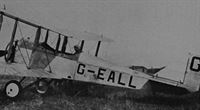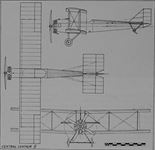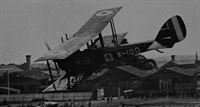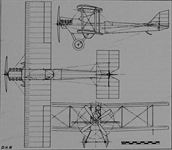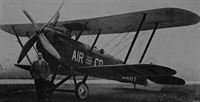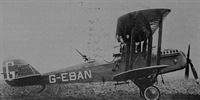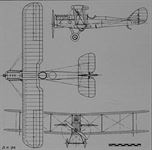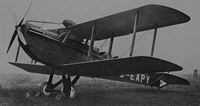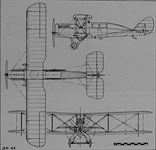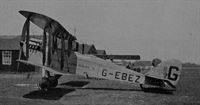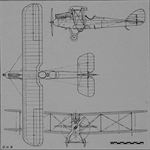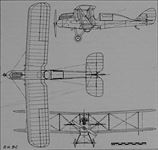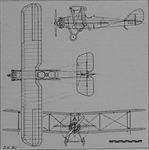Книги
Putnam
A.Jackson
British Civil Aircraft since 1919 vol.1
95
A.Jackson - British Civil Aircraft since 1919 vol.1 /Putnam/
ALLIANCE P.1
Two-seat training biplane of wood and fabric construction built at Hendon 1918 as the Ruffy-Baumann R.A.B. 15, powered by one 80-h.p. Renault. After the removal of the undercarriage skids and the fitting of a horn-balanced rudder it was renamed the Alliance P.1, following the absorption of the Ruflfy, Arnell and Baumann Aviation Company into the Alliance Aeroplane Co. Ltd. One aircraft only: K-159/G-EAGK, c/n P. 1, registered 9.7.19, scrapped 11.20.
Two-seat training biplane of wood and fabric construction built at Hendon 1918 as the Ruffy-Baumann R.A.B. 15, powered by one 80-h.p. Renault. After the removal of the undercarriage skids and the fitting of a horn-balanced rudder it was renamed the Alliance P.1, following the absorption of the Ruflfy, Arnell and Baumann Aviation Company into the Alliance Aeroplane Co. Ltd. One aircraft only: K-159/G-EAGK, c/n P. 1, registered 9.7.19, scrapped 11.20.
ALLIANCE P.2 SEABIRD
Two-seater with 21-hour range, powered by one 450-h.p. Napier Lion, built 1919 by the Alliance Aeroplane Co. Ltd., Acton, for the Atlantic Flight competition. Two aircraft only: K-160/G-EAGL, used instead to make the first Acton to Madrid non-stop flight 31.7.19; G-EAOX, C. of A. issued 27.10.19, left Hounslow to compete for the Australian Government's £10,000 prize 13.11.19, but crashed at Surbiton a few minutes later, Lt. R. Douglas and Lt. J. S. Ross killed. Span, 53 ft. Length, 33 ft. 6 in. Tare wt., 2,600 lb. A.U.W., 7,400 lb. Max. speed, 140 m.p.h.
Two-seater with 21-hour range, powered by one 450-h.p. Napier Lion, built 1919 by the Alliance Aeroplane Co. Ltd., Acton, for the Atlantic Flight competition. Two aircraft only: K-160/G-EAGL, used instead to make the first Acton to Madrid non-stop flight 31.7.19; G-EAOX, C. of A. issued 27.10.19, left Hounslow to compete for the Australian Government's £10,000 prize 13.11.19, but crashed at Surbiton a few minutes later, Lt. R. Douglas and Lt. J. S. Ross killed. Span, 53 ft. Length, 33 ft. 6 in. Tare wt., 2,600 lb. A.U.W., 7,400 lb. Max. speed, 140 m.p.h.
ARMSTRONG WHITWORTH F.K.3
Two-seat trainer designed by Frederick Koolhoven in 1915 and powered by one 90-h.p. R.A.F.1A. Four civil conversions only from F.K.3s built under licence by Hewlett and Blondeau Ltd., Luton: B9629/G-EABY illustrated, and B9518/G-EABZ, E. D. G. Herne, Porthcawl, Cs. of A. issued 14.5.19; B9612/G-EAEU, Kingsbury Av. Co., C. of A. issued 10.7.19, crashed 12.19; Bgbog/G-EALK, L. G. Lowe, scrapped 1920. Span, 40 ft. Length, 29 ft. Tare wt., 1,386 lb. A.U.W., 2,056 lb. Max. speed, 87 m.p.h.
Two-seat trainer designed by Frederick Koolhoven in 1915 and powered by one 90-h.p. R.A.F.1A. Four civil conversions only from F.K.3s built under licence by Hewlett and Blondeau Ltd., Luton: B9629/G-EABY illustrated, and B9518/G-EABZ, E. D. G. Herne, Porthcawl, Cs. of A. issued 14.5.19; B9612/G-EAEU, Kingsbury Av. Co., C. of A. issued 10.7.19, crashed 12.19; Bgbog/G-EALK, L. G. Lowe, scrapped 1920. Span, 40 ft. Length, 29 ft. Tare wt., 1,386 lb. A.U.W., 2,056 lb. Max. speed, 87 m.p.h.
AUSTIN WHIPPET
Single-seat light plane powered by one 45-h.p. Anzani, built 1919 by the Austin Motor Co. Ltd. Three aircraft only: K-158/G-EAGS, c/n AU.1, C. of A. issued 4.12.19; G-EAPF, c/n AU.2, C. of A. issued 7.10.24, last of six owners H. M. Pearson, Hamble, 4.29, sold in New Zealand 1931 as ZK-ACR; G-EAUZ, c/n AU.3, taken to the Argentine by A. J. Greenshields 1920 and flew till 1928. Span, 21 ft. 6 in. Length, 16 ft. 3 in. Tare wt., 500 lb. A.U.W., 730 lb. Max. speed, 85 m.p.h.
Single-seat light plane powered by one 45-h.p. Anzani, built 1919 by the Austin Motor Co. Ltd. Three aircraft only: K-158/G-EAGS, c/n AU.1, C. of A. issued 4.12.19; G-EAPF, c/n AU.2, C. of A. issued 7.10.24, last of six owners H. M. Pearson, Hamble, 4.29, sold in New Zealand 1931 as ZK-ACR; G-EAUZ, c/n AU.3, taken to the Argentine by A. J. Greenshields 1920 and flew till 1928. Span, 21 ft. 6 in. Length, 16 ft. 3 in. Tare wt., 500 lb. A.U.W., 730 lb. Max. speed, 85 m.p.h.
Avro 504K
By the end of the First World War, A. V. Roe’s immortal 504 design of 1913 had emerged as the Avro 504K, most famous wooden trainer of all time. Its cheapness of operation and ease of maintenance made it the only surplus military aircraft of 1919 to find lasting favour as a civil type. Although used in small numbers for tuition, as at the Beardmore School at Renfrew, which had four, the Avro 504K as a civil machine is synonymous with itinerant joy-riding, and up to the advent of the Moth in 1926 was the most common British aeroplane. No less than 319 were converted for civil use by removing the dual controls and cutting away the decking to accommodate a third seat, although this number included several ferried in sheep’s clothing to foreign air forces in 1919-20.
When civil flying was officially sanctioned at Easter 1919, the Avro firm was first in the field with a small fleet of 504Ks which carried 30,000 passengers from the beaches of Southport, Blackpool, Weston-super-Mare and elsewhere during the summer. A regular and well-patronized service was also flown between Alexandra Park Aerodrome, Manchester, Birkdale Sands, Southport and Blackpool. In the north-east the North Sea Aerial Navigation Co. Ltd. (a Blackburn subsidiary) ran a similar service during the season from Scarborough to Harrogate, via Hull, with G-EAGV. Airframes, engines and spares existed in vast quantities, and an ‘Avro’ could be purchased at very low cost from the Aircraft Disposal Board at Croydon by any ex R.A.F. pilot bent on trying to earn a living in the air. Records show that over 50 such enterprises were launched, passengers being carried at a guinea a head from little fields all over the country, but the slump of 1921 put an end to easy money and to most of these ‘mushroom’ concerns. The notable exception was the Berkshire Aviation Co., founded by F. J. V. and J. D. V. Holmes with Le Rhone-engined G-EACL, formerly D9298. In 1920 they were joined by A. J. Cobham and O. P. Jones, two little-known pilots, who brought with them G-EAKX and ’SF, destined to be the longest-lived of all ‘old Avros’. Joy-riding took place all over the Midlands and the Home Counties, and the machines were overhauled in a barn at East Hanney, near Wantage, during the winter. Another typical joy-riding firm was the Cornwall Aviation Co. Ltd., founded at St. Austell in 1924 by Capt. Percival Phillips, who also serviced his 504Ks in a barn during the winter, and carried out passenger flying at Margate and other resorts every summer. By 1930 the fleet consisted of G-EBIZ, ’NR, ’SE, G-AAAF and ’YI. A similar firm, the North British Aviation Co. Ltd., founded at Hooton in 1929 by E. E. Fresson and L. J. Rimmer, covered Lancashire, Cheshire and the Lake District. When, however, Sir Alan Cobham’s National Aviation Day displays went on tour in 1932, the red Cornwall Avros went with it, and in the following year the North British fleet, consisting of G-EASF, ’KX, G-EBGZ, ’HE, ’KX, ’SJ, G-AAEZ, G-ABHJ, ’HK. and ’LL, was also enlisted, and the heyday of the lone Avro in a field was over.
During its civil career a number of major variants of the Avro 504K appeared. First came the float-equipped 504L, 10 of which augmented the Avro fleet at seaside resorts and on Lake Windermere. Howard Pixton, manager of the Windermere floatplanes, flew a regular and successful newspaper service to the Isle of Man during the summer of 1919. Five others were flown on the south coast that season by the Eastbourne Aviation Go. Ltd. The Avro Company persuaded four passengers into the rear cockpit of some land machines by increasing the width of the fuselage by 9 in. to create a variant known as the Avro 536. A prototype, K-104, and 20 ‘production’ conversions were made at Woodford in 1919, while four others - G-EBOF, ’OY, ’RB and ’TF - were converted by Surrey Flying Services Ltd. in 1926-27. This firm, founded at Croydon by A. F. Muir and W. J. Grant with two Avro 504Ks, G-EAWI and ’WJ, in 1919, carried thousands of passengers in its famous blue machines until the last of the large fleet, G-AAGB, was written off in 1934. The manufacturers also produced two cabin versions, the first of which was fitted with a 100-h.p. Gnome and designated 504M. This aircraft, K-134, later G-EACX, seated two behind the pilot in a cabin provided with portholes above the top longerons and did a great deal of pleasure-flying from Hounslow Heath in 1919-20. Taking off from a grass strip outside Chorley Wood Church in June 1919, it took a newly married couple to Fowey, Cornwall, on what was probably the first post-war British internal charter. The other cabin version, the Avro 546, was a three-seater converted from an Avro 536 G-EAOM in October 1919. The Triplex windows were below the top longeron on this variant, and a 150-h.p. Bentley B.R.1 was fitted. Only one Avro 546 was produced, and only two other variants are worthy of note. First was the Avro Company’s experimental machine G-EAPR, which in October 1919 had 504K wings and a 90-h.p. Curtiss OX-5 engine. In this form it was designated the Avro 545. The other was an Avro 504K G-EAGI, locally modified at Northolt with a long-legged V strut, skidless undercarriage for use with seven other standard machines at the Central Aircraft Company’s flying-school.
The final rotary-engined variant of the 504 family was the Avro 504R Gosport, a cleaned-up two-seat version with tapered ailerons, powered by a 100-h.p. Gnome. The prototype, G-EBNE, received its C. of A. on 15 June 1926, and five others - G-EBNF, ’OX, ’PH, ’UY and G-AACT - were built. G-EBPH was experimentally fitted with a 100-h.p. Avro Alpha five-cylinder radial, and used in December 1926 for a landing on the summit of Helvellyn by Messrs. Hinkler and Leeming. The prototype was used for instruction by the Lancashire Aero Club until it crashed near Woodford on 21 October 1928, and G-EBUY was fitted with a 150-h.p. Armstrong Siddeley Mongoose radial to become a 504N/504R hybrid.
SPECIFICATION
Manufacturers: A. V. Roe and Co. Ltd., Newton Heath, Manchester. Widely sub-contracted.
Power Plants:
One 100-h.p. Gnome.
One 110-h.p. Le Rhone.
One 130-h.p. Clerget.
One 150-h.p. Bentley B.R.1.
Dimensions: Length, 29 ft. 5 in. Height, 10 ft. 5 in.
Avro 504K and 504M Avro 504L Avro 536 and 546
Span 36 ft. 36 ft. 36 ft. 9 in.
Wing area 330 sq. ft. 330 sq. ft. 335 sq. ft.
Tare weight 1,231 lb. 1,408 lb. 1,431 lb.
All-up weight 1,829 lb. 2,006 lb. 2,226 lb.
Maximum speed 95 m.p.h. 80 m.p.h. 90 m.p.h.
Cruising speed 75 m.p.h. 65 m.p.h. 70 m.p.h.
Initial climb 700 ft./min. 600 ft./min. 550 ft./min.
Ceiling 16,000 ft. 15,000 ft. 12,000 ft.
Range 225 miles 160 miles 200 miles
By the end of the First World War, A. V. Roe’s immortal 504 design of 1913 had emerged as the Avro 504K, most famous wooden trainer of all time. Its cheapness of operation and ease of maintenance made it the only surplus military aircraft of 1919 to find lasting favour as a civil type. Although used in small numbers for tuition, as at the Beardmore School at Renfrew, which had four, the Avro 504K as a civil machine is synonymous with itinerant joy-riding, and up to the advent of the Moth in 1926 was the most common British aeroplane. No less than 319 were converted for civil use by removing the dual controls and cutting away the decking to accommodate a third seat, although this number included several ferried in sheep’s clothing to foreign air forces in 1919-20.
When civil flying was officially sanctioned at Easter 1919, the Avro firm was first in the field with a small fleet of 504Ks which carried 30,000 passengers from the beaches of Southport, Blackpool, Weston-super-Mare and elsewhere during the summer. A regular and well-patronized service was also flown between Alexandra Park Aerodrome, Manchester, Birkdale Sands, Southport and Blackpool. In the north-east the North Sea Aerial Navigation Co. Ltd. (a Blackburn subsidiary) ran a similar service during the season from Scarborough to Harrogate, via Hull, with G-EAGV. Airframes, engines and spares existed in vast quantities, and an ‘Avro’ could be purchased at very low cost from the Aircraft Disposal Board at Croydon by any ex R.A.F. pilot bent on trying to earn a living in the air. Records show that over 50 such enterprises were launched, passengers being carried at a guinea a head from little fields all over the country, but the slump of 1921 put an end to easy money and to most of these ‘mushroom’ concerns. The notable exception was the Berkshire Aviation Co., founded by F. J. V. and J. D. V. Holmes with Le Rhone-engined G-EACL, formerly D9298. In 1920 they were joined by A. J. Cobham and O. P. Jones, two little-known pilots, who brought with them G-EAKX and ’SF, destined to be the longest-lived of all ‘old Avros’. Joy-riding took place all over the Midlands and the Home Counties, and the machines were overhauled in a barn at East Hanney, near Wantage, during the winter. Another typical joy-riding firm was the Cornwall Aviation Co. Ltd., founded at St. Austell in 1924 by Capt. Percival Phillips, who also serviced his 504Ks in a barn during the winter, and carried out passenger flying at Margate and other resorts every summer. By 1930 the fleet consisted of G-EBIZ, ’NR, ’SE, G-AAAF and ’YI. A similar firm, the North British Aviation Co. Ltd., founded at Hooton in 1929 by E. E. Fresson and L. J. Rimmer, covered Lancashire, Cheshire and the Lake District. When, however, Sir Alan Cobham’s National Aviation Day displays went on tour in 1932, the red Cornwall Avros went with it, and in the following year the North British fleet, consisting of G-EASF, ’KX, G-EBGZ, ’HE, ’KX, ’SJ, G-AAEZ, G-ABHJ, ’HK. and ’LL, was also enlisted, and the heyday of the lone Avro in a field was over.
During its civil career a number of major variants of the Avro 504K appeared. First came the float-equipped 504L, 10 of which augmented the Avro fleet at seaside resorts and on Lake Windermere. Howard Pixton, manager of the Windermere floatplanes, flew a regular and successful newspaper service to the Isle of Man during the summer of 1919. Five others were flown on the south coast that season by the Eastbourne Aviation Go. Ltd. The Avro Company persuaded four passengers into the rear cockpit of some land machines by increasing the width of the fuselage by 9 in. to create a variant known as the Avro 536. A prototype, K-104, and 20 ‘production’ conversions were made at Woodford in 1919, while four others - G-EBOF, ’OY, ’RB and ’TF - were converted by Surrey Flying Services Ltd. in 1926-27. This firm, founded at Croydon by A. F. Muir and W. J. Grant with two Avro 504Ks, G-EAWI and ’WJ, in 1919, carried thousands of passengers in its famous blue machines until the last of the large fleet, G-AAGB, was written off in 1934. The manufacturers also produced two cabin versions, the first of which was fitted with a 100-h.p. Gnome and designated 504M. This aircraft, K-134, later G-EACX, seated two behind the pilot in a cabin provided with portholes above the top longerons and did a great deal of pleasure-flying from Hounslow Heath in 1919-20. Taking off from a grass strip outside Chorley Wood Church in June 1919, it took a newly married couple to Fowey, Cornwall, on what was probably the first post-war British internal charter. The other cabin version, the Avro 546, was a three-seater converted from an Avro 536 G-EAOM in October 1919. The Triplex windows were below the top longeron on this variant, and a 150-h.p. Bentley B.R.1 was fitted. Only one Avro 546 was produced, and only two other variants are worthy of note. First was the Avro Company’s experimental machine G-EAPR, which in October 1919 had 504K wings and a 90-h.p. Curtiss OX-5 engine. In this form it was designated the Avro 545. The other was an Avro 504K G-EAGI, locally modified at Northolt with a long-legged V strut, skidless undercarriage for use with seven other standard machines at the Central Aircraft Company’s flying-school.
The final rotary-engined variant of the 504 family was the Avro 504R Gosport, a cleaned-up two-seat version with tapered ailerons, powered by a 100-h.p. Gnome. The prototype, G-EBNE, received its C. of A. on 15 June 1926, and five others - G-EBNF, ’OX, ’PH, ’UY and G-AACT - were built. G-EBPH was experimentally fitted with a 100-h.p. Avro Alpha five-cylinder radial, and used in December 1926 for a landing on the summit of Helvellyn by Messrs. Hinkler and Leeming. The prototype was used for instruction by the Lancashire Aero Club until it crashed near Woodford on 21 October 1928, and G-EBUY was fitted with a 150-h.p. Armstrong Siddeley Mongoose radial to become a 504N/504R hybrid.
SPECIFICATION
Manufacturers: A. V. Roe and Co. Ltd., Newton Heath, Manchester. Widely sub-contracted.
Power Plants:
One 100-h.p. Gnome.
One 110-h.p. Le Rhone.
One 130-h.p. Clerget.
One 150-h.p. Bentley B.R.1.
Dimensions: Length, 29 ft. 5 in. Height, 10 ft. 5 in.
Avro 504K and 504M Avro 504L Avro 536 and 546
Span 36 ft. 36 ft. 36 ft. 9 in.
Wing area 330 sq. ft. 330 sq. ft. 335 sq. ft.
Tare weight 1,231 lb. 1,408 lb. 1,431 lb.
All-up weight 1,829 lb. 2,006 lb. 2,226 lb.
Maximum speed 95 m.p.h. 80 m.p.h. 90 m.p.h.
Cruising speed 75 m.p.h. 65 m.p.h. 70 m.p.h.
Initial climb 700 ft./min. 600 ft./min. 550 ft./min.
Ceiling 16,000 ft. 15,000 ft. 12,000 ft.
Range 225 miles 160 miles 200 miles
Avro Gosport G-EBNF with tapered ailerons. The full stop after the registration was common to all newly built Avro aircraft of the period.
Northern Air Transport’s Avro 504K G-ABLL, formerly an R.A.F. trainer 58333, flying over Liverpool in 1933.
An Avro 504L G-EADK, formerly H2582, giving passenger flights from Folkestone beach with the Avro Transport Company in 1919.
AVRO 538
Single-seater powered by one 150-h.p. Bentley B.R.1, constructed from Avro 504K components by A. V. Roe and Co. Ltd., Manchester 1919. One aircraft only: K-132/G-EACR, c/n 538/1. Used as communications aircraft by J. C. C. Taylor, ground engineer i/c the Avro Transport Company’s nation-wide fleet of joy-riding Avro 504Ks. Scrapped 9.20. Span, 28 ft. Length, 20 ft. 6 in. Tare wt., 975 lb. A.U.W., 1,400 lb. Max. speed, 125 m.p.h. Cruise, 108 m.p.h.
Single-seater powered by one 150-h.p. Bentley B.R.1, constructed from Avro 504K components by A. V. Roe and Co. Ltd., Manchester 1919. One aircraft only: K-132/G-EACR, c/n 538/1. Used as communications aircraft by J. C. C. Taylor, ground engineer i/c the Avro Transport Company’s nation-wide fleet of joy-riding Avro 504Ks. Scrapped 9.20. Span, 28 ft. Length, 20 ft. 6 in. Tare wt., 975 lb. A.U.W., 1,400 lb. Max. speed, 125 m.p.h. Cruise, 108 m.p.h.
Avro 504K
<...>
During its civil career a number of major variants of the Avro 504K appeared. First came the float-equipped 504L, 10 of which augmented the Avro fleet at seaside resorts and on Lake Windermere. Howard Pixton, manager of the Windermere floatplanes, flew a regular and successful newspaper service to the Isle of Man during the summer of 1919. Five others were flown on the south coast that season by the Eastbourne Aviation Go. Ltd. The Avro Company persuaded four passengers into the rear cockpit of some land machines by increasing the width of the fuselage by 9 in. to create a variant known as the Avro 536. A prototype, K-104, and 20 ‘production’ conversions were made at Woodford in 1919, while four others - G-EBOF, ’OY, ’RB and ’TF - were converted by Surrey Flying Services Ltd. in 1926-27. This firm, founded at Croydon by A. F. Muir and W. J. Grant with two Avro 504Ks, G-EAWI and ’WJ, in 1919, carried thousands of passengers in its famous blue machines until the last of the large fleet, G-AAGB, was written off in 1934. The manufacturers also produced two cabin versions, the first of which was fitted with a 100-h.p. Gnome and designated 504M. This aircraft, K-134, later G-EACX, seated two behind the pilot in a cabin provided with portholes above the top longerons and did a great deal of pleasure-flying from Hounslow Heath in 1919-20. Taking off from a grass strip outside Chorley Wood Church in June 1919, it took a newly married couple to Fowey, Cornwall, on what was probably the first post-war British internal charter. The other cabin version, the Avro 546, was a three-seater converted from an Avro 536 G-EAOM in October 1919. The Triplex windows were below the top longeron on this variant, and a 150-h.p. Bentley B.R.1 was fitted. Only one Avro 546 was produced, and only two other variants are worthy of note. First was the Avro Company’s experimental machine G-EAPR, which in October 1919 had 504K wings and a 90-h.p. Curtiss OX-5 engine. In this form it was designated the Avro 545. The other was an Avro 504K G-EAGI, locally modified at Northolt with a long-legged V strut, skidless undercarriage for use with seven other standard machines at the Central Aircraft Company’s flying-school.
<...>
SPECIFICATION
<...>
Dimensions: Length, 29 ft. 5 in. Height, 10 ft. 5 in.
Avro 504K and 504M Avro 504L Avro 536 and 546
Span 36 ft. 36 ft. 36 ft. 9 in.
Wing area 330 sq. ft. 330 sq. ft. 335 sq. ft.
Tare weight 1,231 lb. 1,408 lb. 1,431 lb.
All-up weight 1,829 lb. 2,006 lb. 2,226 lb.
Maximum speed 95 m.p.h. 80 m.p.h. 90 m.p.h.
Cruising speed 75 m.p.h. 65 m.p.h. 70 m.p.h.
Initial climb 700 ft./min. 600 ft./min. 550 ft./min.
Ceiling 16,000 ft. 15,000 ft. 12,000 ft.
Range 225 miles 160 miles 200 miles
<...>
During its civil career a number of major variants of the Avro 504K appeared. First came the float-equipped 504L, 10 of which augmented the Avro fleet at seaside resorts and on Lake Windermere. Howard Pixton, manager of the Windermere floatplanes, flew a regular and successful newspaper service to the Isle of Man during the summer of 1919. Five others were flown on the south coast that season by the Eastbourne Aviation Go. Ltd. The Avro Company persuaded four passengers into the rear cockpit of some land machines by increasing the width of the fuselage by 9 in. to create a variant known as the Avro 536. A prototype, K-104, and 20 ‘production’ conversions were made at Woodford in 1919, while four others - G-EBOF, ’OY, ’RB and ’TF - were converted by Surrey Flying Services Ltd. in 1926-27. This firm, founded at Croydon by A. F. Muir and W. J. Grant with two Avro 504Ks, G-EAWI and ’WJ, in 1919, carried thousands of passengers in its famous blue machines until the last of the large fleet, G-AAGB, was written off in 1934. The manufacturers also produced two cabin versions, the first of which was fitted with a 100-h.p. Gnome and designated 504M. This aircraft, K-134, later G-EACX, seated two behind the pilot in a cabin provided with portholes above the top longerons and did a great deal of pleasure-flying from Hounslow Heath in 1919-20. Taking off from a grass strip outside Chorley Wood Church in June 1919, it took a newly married couple to Fowey, Cornwall, on what was probably the first post-war British internal charter. The other cabin version, the Avro 546, was a three-seater converted from an Avro 536 G-EAOM in October 1919. The Triplex windows were below the top longeron on this variant, and a 150-h.p. Bentley B.R.1 was fitted. Only one Avro 546 was produced, and only two other variants are worthy of note. First was the Avro Company’s experimental machine G-EAPR, which in October 1919 had 504K wings and a 90-h.p. Curtiss OX-5 engine. In this form it was designated the Avro 545. The other was an Avro 504K G-EAGI, locally modified at Northolt with a long-legged V strut, skidless undercarriage for use with seven other standard machines at the Central Aircraft Company’s flying-school.
<...>
SPECIFICATION
<...>
Dimensions: Length, 29 ft. 5 in. Height, 10 ft. 5 in.
Avro 504K and 504M Avro 504L Avro 536 and 546
Span 36 ft. 36 ft. 36 ft. 9 in.
Wing area 330 sq. ft. 330 sq. ft. 335 sq. ft.
Tare weight 1,231 lb. 1,408 lb. 1,431 lb.
All-up weight 1,829 lb. 2,006 lb. 2,226 lb.
Maximum speed 95 m.p.h. 80 m.p.h. 90 m.p.h.
Cruising speed 75 m.p.h. 65 m.p.h. 70 m.p.h.
Initial climb 700 ft./min. 600 ft./min. 550 ft./min.
Ceiling 16,000 ft. 15,000 ft. 12,000 ft.
Range 225 miles 160 miles 200 miles
The Avro 536 K-137 joy-riding at Southsea in 1919 with four passengers in the enlarged rear cockpit. The extra fin was also fitted to the Avro 504L and M.
AVRO 539
Single-seat floatplane powered by one 240-h.p. Siddeley Puma, built for 1919 Schneider Trophy by A. V. Roe and Co. Ltd., Hamble. One aircraft only: G-EALG, c/n 539/1, first flown 29.8.19. Modified with balanced rudder and elongated fin prior to contest 10.9.19, from which it was eliminated. Pilot H. A. Hamersley. Span, 25 ft. 6 in. Length, 21 ft. 4 in. Tare wt., 1,670 lb. A.U.W., 2,119 lb.
AVRO 539A
Conversion of Avro 539 to landplane with revised fin for 1920 Aerial Derby, pilot D. G. Westgarth-Heslam. One aircraft only: G-EALG, c/n 539 A/1. Made a forced landing at Abridge, Essex.
AVRO 539B
Avro 539A rebuilt for the 1921 Aerial Derby with 450-h.p. Napier Lion, plywood rear fuselage and revised undercarriage. One aircraft only: G-EAXM, c/n 539 B/1. D. G. Westgarth-Heslam injured and aircraft destroyed in landing accident at Hamble on eve of race, July 1921. Span, 25 ft. 6 in. Length, 18 ft. 2 in.
Single-seat floatplane powered by one 240-h.p. Siddeley Puma, built for 1919 Schneider Trophy by A. V. Roe and Co. Ltd., Hamble. One aircraft only: G-EALG, c/n 539/1, first flown 29.8.19. Modified with balanced rudder and elongated fin prior to contest 10.9.19, from which it was eliminated. Pilot H. A. Hamersley. Span, 25 ft. 6 in. Length, 21 ft. 4 in. Tare wt., 1,670 lb. A.U.W., 2,119 lb.
AVRO 539A
Conversion of Avro 539 to landplane with revised fin for 1920 Aerial Derby, pilot D. G. Westgarth-Heslam. One aircraft only: G-EALG, c/n 539 A/1. Made a forced landing at Abridge, Essex.
AVRO 539B
Avro 539A rebuilt for the 1921 Aerial Derby with 450-h.p. Napier Lion, plywood rear fuselage and revised undercarriage. One aircraft only: G-EAXM, c/n 539 B/1. D. G. Westgarth-Heslam injured and aircraft destroyed in landing accident at Hamble on eve of race, July 1921. Span, 25 ft. 6 in. Length, 18 ft. 2 in.
The Avro 539A G-EALG with which Capt D. G. Westgarth-Heslam was forced to retire during the 1920 Aerial Derby.
The machine after reconstruction as the Avro 539B with Napier Lion engine, running up at Hamble on July 13, 1921.
Avro 534 Baby
The Baby, first practical light aeroplane produced in Great Britain after the First World War, was a conventional single-seat biplane featuring the traditional Avro circular rudder. Eight of these machines were built in the Avro works at Hamble, each and every one playing its part in laying sure foundations for the light-aeroplane movement which came in later years. The prototype K-131 was fitted with the identical 35-h.p. water-cooled Green engine that had been fitted in A. V. Roe’s famous 1910 Triplane and, despite its age, brought the Baby to victory in the handicap section of the Aerial Derby in June 1919, followed a month later by an outright win in the Victory Trophy Race. To emphasize that it was no low-powered freak, Avro test pilot H. A. Hamersley flew it non-stop from Hounslow Heath to Brussels in 2 hours 50 minutes in August 1919, afterwards going on to demonstrate it at the Amsterdam Exhibition. During a stunt-flying session with the Avro joy-riding campaign at seaside resorts later in the year, the markings were changed to G-EACQ, and on the last day of the following May, H. J. Hinkler flew it non-stop from Croydon, over the Alps, to Turin in g| hours. After exhibition at the 1920 Olympia Aero Show and participation in the Aerial Derby, Hinkler shipped it to Australia, and on 11 April 1931 flew 800 miles non-stop from Sydney to Bundaberg in 9 hours to set up an Australian long-distance record. A few weeks later, after a forced landing on a beach in tropical rain, it was towed 16 miles to Newcastle by a horse-team, and in 1936 was still flying as VH-UCQ.
The close proximity of Hamble to Southampton Water invited seaplane operations, and it is not therefore surprising that the second machine was a floatplane with extra fin area and orthodox rudder. This was the Avro 534A Water Baby, and, despite teething troubles with water soakage, flew quite successfully until it crashed on 7 September 1921. The third Baby, G-EAUG, built with plywood fuselage, also had tapered ailerons, and was termed the Avro 534B. It was flown by H. A. Hamersley in the 1920 Aerial Derby, the slight reduction in wing area making it a trifle faster than the prototype, and in the event they carried off first and second places. They were followed in July 1920 by the Avro 543 Baby G-EAUM, which carried two passengers in an enlarged single cockpit, but was otherwise a standard Baby with the fuselage lengthened by 2 ft. 6 in. Flown by Capt. T. Tulley, it lapped the 1921 Aerial Derby course at 73-67 m.p.h. until forced down at Brooklands, and the following year was raced with a fairing over the rear seat. In 1926 it lost its superannuated Green and attendant plumbing in favour of the more modern 60-h.p. Cirrus I, and in 1927 went to Shoreham, where it was jointly owned by L. E. R. Bellairs and F. G. Miles, in whom it inspired the idea of building the Martlet. After changing hands several times it ended its days with Roper Brown at Southend in 1934.
All the remaining Babies were equally remarkable; the Avro 534C G-EAXL had lower wings of reduced span for racing purposes, and after making its initial flight at Hamble in June 1921, was entered in the Aerial Derby of 16 July but Hinkler had trouble with it, and forced-landed at Sidcup. Then in September came G-EAYM, the Avro 534D Baby, which had steel engine bearers, a larger radiator and very ample cooling louvres in the cowlings. This machine was built for service in India to the order of E. Villiers. The next two Babies, however, went to vastly cooler climes, G-EBDA completing in May 1922 the first flight ever made between London and Moscow. The pilot was a Russian named Gwaiter, who had considerable difficulty in crossing Germany, where a Russian subject flying a British aeroplane caused international complications. Last of the breed was the Avro 554 Antarctic Baby built in 1921 as a photo reconnaissance aircraft for the late Sir Ernest Shackleton’s South Polar Expedition. Limited shipboard stowage space called for swift dismantling and erection by gloved hands and without rigging worries. Steel tube struts therefore replaced the flying wires, N-type interplane struts were fitted and all bolts were extra large. Low air temperatures precluded water-cooling and an 80-h.p. Le Rhone rotary was fitted. After trials on Southampton Water by its pilot, Major C. R. Carr, it was embarked in the Quest at Tower Bridge and left for the far south. It was apparently never used, and on its return in 1923 was purchased by the Aerial Survey Co., and as G-EBFE was shipped to Newfoundland. Here it was used for spotting seals during 1924-25, piloted by B. Grundy and C. S. Caldwell.
SPECIFICATION
Manufacturers: A. V. Roe and Co. Ltd., Hamble Aerodrome, near Southampton, Hants.
Power Plants:
(Avro 534 and 543) One 35-h.p. Green.
(Avro 543) One 60-h.p. A.D.C. Cirrus I.
(Avro 554) One 80-h.p. Le Rhone.
Avro 534 Avro 543 Avro 554
Span 25 ft. 25 ft. 26 ft. 3 in.
Length 17 ft. 6 in. 20 ft. 22 ft. 5 in.
Height 7 ft. 6 in. 7 ft. 6 in. —
Wing area 176 1/2 sq. ft. 176 1/2 sq. ft. 184 1/2 sq. ft.
Tare weight . 607 lb. 630 lb. 1,000 lb.
All-up weight 860 lb. 970 lb. 1,600 lb.
Maximum speed 82 m.p.h. 82 m.p.h. 90 m.p.h.
Cruising speed 70 m.p.h. 70 m.p.h. 70 m.p.h.
Initial climb . 325 ft./min. 450 ft./min. 330 ft./min.
Ceiling 12,000 ft. 12,000 ft. -
Range 240 miles 225 miles -
The Baby, first practical light aeroplane produced in Great Britain after the First World War, was a conventional single-seat biplane featuring the traditional Avro circular rudder. Eight of these machines were built in the Avro works at Hamble, each and every one playing its part in laying sure foundations for the light-aeroplane movement which came in later years. The prototype K-131 was fitted with the identical 35-h.p. water-cooled Green engine that had been fitted in A. V. Roe’s famous 1910 Triplane and, despite its age, brought the Baby to victory in the handicap section of the Aerial Derby in June 1919, followed a month later by an outright win in the Victory Trophy Race. To emphasize that it was no low-powered freak, Avro test pilot H. A. Hamersley flew it non-stop from Hounslow Heath to Brussels in 2 hours 50 minutes in August 1919, afterwards going on to demonstrate it at the Amsterdam Exhibition. During a stunt-flying session with the Avro joy-riding campaign at seaside resorts later in the year, the markings were changed to G-EACQ, and on the last day of the following May, H. J. Hinkler flew it non-stop from Croydon, over the Alps, to Turin in g| hours. After exhibition at the 1920 Olympia Aero Show and participation in the Aerial Derby, Hinkler shipped it to Australia, and on 11 April 1931 flew 800 miles non-stop from Sydney to Bundaberg in 9 hours to set up an Australian long-distance record. A few weeks later, after a forced landing on a beach in tropical rain, it was towed 16 miles to Newcastle by a horse-team, and in 1936 was still flying as VH-UCQ.
The close proximity of Hamble to Southampton Water invited seaplane operations, and it is not therefore surprising that the second machine was a floatplane with extra fin area and orthodox rudder. This was the Avro 534A Water Baby, and, despite teething troubles with water soakage, flew quite successfully until it crashed on 7 September 1921. The third Baby, G-EAUG, built with plywood fuselage, also had tapered ailerons, and was termed the Avro 534B. It was flown by H. A. Hamersley in the 1920 Aerial Derby, the slight reduction in wing area making it a trifle faster than the prototype, and in the event they carried off first and second places. They were followed in July 1920 by the Avro 543 Baby G-EAUM, which carried two passengers in an enlarged single cockpit, but was otherwise a standard Baby with the fuselage lengthened by 2 ft. 6 in. Flown by Capt. T. Tulley, it lapped the 1921 Aerial Derby course at 73-67 m.p.h. until forced down at Brooklands, and the following year was raced with a fairing over the rear seat. In 1926 it lost its superannuated Green and attendant plumbing in favour of the more modern 60-h.p. Cirrus I, and in 1927 went to Shoreham, where it was jointly owned by L. E. R. Bellairs and F. G. Miles, in whom it inspired the idea of building the Martlet. After changing hands several times it ended its days with Roper Brown at Southend in 1934.
All the remaining Babies were equally remarkable; the Avro 534C G-EAXL had lower wings of reduced span for racing purposes, and after making its initial flight at Hamble in June 1921, was entered in the Aerial Derby of 16 July but Hinkler had trouble with it, and forced-landed at Sidcup. Then in September came G-EAYM, the Avro 534D Baby, which had steel engine bearers, a larger radiator and very ample cooling louvres in the cowlings. This machine was built for service in India to the order of E. Villiers. The next two Babies, however, went to vastly cooler climes, G-EBDA completing in May 1922 the first flight ever made between London and Moscow. The pilot was a Russian named Gwaiter, who had considerable difficulty in crossing Germany, where a Russian subject flying a British aeroplane caused international complications. Last of the breed was the Avro 554 Antarctic Baby built in 1921 as a photo reconnaissance aircraft for the late Sir Ernest Shackleton’s South Polar Expedition. Limited shipboard stowage space called for swift dismantling and erection by gloved hands and without rigging worries. Steel tube struts therefore replaced the flying wires, N-type interplane struts were fitted and all bolts were extra large. Low air temperatures precluded water-cooling and an 80-h.p. Le Rhone rotary was fitted. After trials on Southampton Water by its pilot, Major C. R. Carr, it was embarked in the Quest at Tower Bridge and left for the far south. It was apparently never used, and on its return in 1923 was purchased by the Aerial Survey Co., and as G-EBFE was shipped to Newfoundland. Here it was used for spotting seals during 1924-25, piloted by B. Grundy and C. S. Caldwell.
SPECIFICATION
Manufacturers: A. V. Roe and Co. Ltd., Hamble Aerodrome, near Southampton, Hants.
Power Plants:
(Avro 534 and 543) One 35-h.p. Green.
(Avro 543) One 60-h.p. A.D.C. Cirrus I.
(Avro 554) One 80-h.p. Le Rhone.
Avro 534 Avro 543 Avro 554
Span 25 ft. 25 ft. 26 ft. 3 in.
Length 17 ft. 6 in. 20 ft. 22 ft. 5 in.
Height 7 ft. 6 in. 7 ft. 6 in. —
Wing area 176 1/2 sq. ft. 176 1/2 sq. ft. 184 1/2 sq. ft.
Tare weight . 607 lb. 630 lb. 1,000 lb.
All-up weight 860 lb. 970 lb. 1,600 lb.
Maximum speed 82 m.p.h. 82 m.p.h. 90 m.p.h.
Cruising speed 70 m.p.h. 70 m.p.h. 70 m.p.h.
Initial climb . 325 ft./min. 450 ft./min. 330 ft./min.
Ceiling 12,000 ft. 12,000 ft. -
Range 240 miles 225 miles -
Avro 504K
<...>
Only one Avro 546 was produced, and only two other variants are worthy of note. First was the Avro Company’s experimental machine G-EAPR, which in October 1919 had 504K wings and a 90-h.p. Curtiss OX-5 engine. In this form it was designated the Avro 545.
<...>
Avro 548
By 1918 the successful development of the in-line and radial air-cooled engines heralded the approaching end of the faithful rotary, and in June 1919 an Avro 504K fitted with an A.B.C. Wasp radial, and bearing the early civil registration K-147, was wheeled out of the Hamble works of A. V. Roe and Co. Ltd. Within a few months the same aeroplane became G-EAFH, this time fitted with an 80-h.p. Renault eight-cylinder V engine, to become the prototype Avro 548. A total of 30 of these existed in this country during the following decade, of which only G-EBIT, ’IU and ’IV, built in 1924 to the order of the North Sea Aerial and General Transport Co. Ltd. for instructional work at Brough, were genuine factory-made 548s. The remainder were ex-R.A.F. Avro 504Ks converted by Avros, the Aircraft Disposal Co. Ltd., the de Havilland Aircraft Co. Ltd. and the Henderson School of Flying Ltd.
One of the first conversions was G-EAAL, formerly a 504K E4154, owned by Vickers in 1923, by the de Havilland Aircraft Co. Ltd. in 1925, and by Stag Lane private owner, T. H. Richardson, till it crashed in 1929. The type was mainly used for instructional work, the Newcastle Aero Club having G-EBPO ex E3387 in 1926, the Norfolk and Norwich Aero Club G-EBPJ ex E9337 for a few months in 1928, while Surrey Flying Services usually earmarked one machine for this purpose, successively owning G-EBBC, TV and G-AABW. It was Brooklands, however, that became the traditional home of the 548, the variegated and fluctuating collection G-EAJB, G-EBAJ, ’FM, ’RD, ’SC, ’VE, ’WH, ’WJ and G-AADT being used by Col. G. L. P. Henderson for tuition and pleasure-flying from 1926 until ’RD and ’SC went joy-riding in South Africa and the survivors were taken over by the new Brooklands School of Flying in 1928. Most famous of all Avro 548s, however, was the prototype G-EAFH, which, piloted by F. G. M. Sparkes, won all three races at the Croydon Race Meeting on 17 September 1921, subsequently giving pleasure-flights with the Welsh Aviation Co. In 1922 it went to Bekesbourne and became the mount of pioneer private owner the late Dr. E. D. Whitehead Reid until 1927. It finished its days joy-riding on Southport Sands with the Giro Aviation Co. Ltd., finally crashing there on 31 May 1935 during a low altitude aerobatic display.
In 1925 the Aircraft Disposal Co. Ltd. produced its 120-h.p. Airdisco engine of similar layout and design to the Renault. This was fitted into an Avro 504K airframe E449 to become the first Avro 548A G-EBKN. This rather lively Avro was well-known along the South Coast in the early ’thirties, flown by Shoreham private owner A. G. Head, A.T.A. pilot of later days. The three factory-built 548s at Brough were also re-engined with Airdiscos, bringing the final total of Avro 548As to four.
The search for a rotary replacement also embraced the water-cooled engine, and another experimental Hamble-based 504K G-EAPR, which had been flying with the 90-h.p. Curtiss OX-5 air-cooled motor, was re-engined with a 180-h.p. Wolseley Viper to take part in the 1921 Hendon Aerial Derby. Flown by L. R. Tait-Cox, it came fifth at 102-5 m.p.h. In this guise it was designated the Avro 552, and was used as a test vehicle for the twin float and N type oleo undercarriages and the Frise type ailerons of the later Avro 504N. Subsequently it was converted into the Cierva Autogiro C.8V G-EBTX in 1927, and three years later emerged as a 552 once more, and as G-ABGO flew a great deal at Hanworth with the Inca Aviation Co. Three others also appeared, having been converted into 552s by C. B. Field at Kingswood Knoll, Surrey. These were G-ACAW, ’AX and ’RP, which in truly gaudy red and yellow colour schemes infested Hanworth on banner towing sorties until written off in 1936.
SPECIFICATION
Manufacturers: A. V. Roe and Co. Ltd., Newton Heath, Manchester. Conversions from existing Avro 504Ks by the firms stated.
Power Plant: One 80-h.p. Renault.
Dimensions: Span, 36 ft. Length, 29 ft. 5 in. Height, 10 ft. 5 in. Wing area, 330 sq. ft.
Weights: Tare weight, 1,338 lb. All-up weight, 1,943 lb.
Performance: Maximum speed, 80 m.p.h. Cruising speed, 65 m.p.h. Initial climb, 350 ft./min. Range, 175 miles.
<...>
Only one Avro 546 was produced, and only two other variants are worthy of note. First was the Avro Company’s experimental machine G-EAPR, which in October 1919 had 504K wings and a 90-h.p. Curtiss OX-5 engine. In this form it was designated the Avro 545.
<...>
Avro 548
By 1918 the successful development of the in-line and radial air-cooled engines heralded the approaching end of the faithful rotary, and in June 1919 an Avro 504K fitted with an A.B.C. Wasp radial, and bearing the early civil registration K-147, was wheeled out of the Hamble works of A. V. Roe and Co. Ltd. Within a few months the same aeroplane became G-EAFH, this time fitted with an 80-h.p. Renault eight-cylinder V engine, to become the prototype Avro 548. A total of 30 of these existed in this country during the following decade, of which only G-EBIT, ’IU and ’IV, built in 1924 to the order of the North Sea Aerial and General Transport Co. Ltd. for instructional work at Brough, were genuine factory-made 548s. The remainder were ex-R.A.F. Avro 504Ks converted by Avros, the Aircraft Disposal Co. Ltd., the de Havilland Aircraft Co. Ltd. and the Henderson School of Flying Ltd.
One of the first conversions was G-EAAL, formerly a 504K E4154, owned by Vickers in 1923, by the de Havilland Aircraft Co. Ltd. in 1925, and by Stag Lane private owner, T. H. Richardson, till it crashed in 1929. The type was mainly used for instructional work, the Newcastle Aero Club having G-EBPO ex E3387 in 1926, the Norfolk and Norwich Aero Club G-EBPJ ex E9337 for a few months in 1928, while Surrey Flying Services usually earmarked one machine for this purpose, successively owning G-EBBC, TV and G-AABW. It was Brooklands, however, that became the traditional home of the 548, the variegated and fluctuating collection G-EAJB, G-EBAJ, ’FM, ’RD, ’SC, ’VE, ’WH, ’WJ and G-AADT being used by Col. G. L. P. Henderson for tuition and pleasure-flying from 1926 until ’RD and ’SC went joy-riding in South Africa and the survivors were taken over by the new Brooklands School of Flying in 1928. Most famous of all Avro 548s, however, was the prototype G-EAFH, which, piloted by F. G. M. Sparkes, won all three races at the Croydon Race Meeting on 17 September 1921, subsequently giving pleasure-flights with the Welsh Aviation Co. In 1922 it went to Bekesbourne and became the mount of pioneer private owner the late Dr. E. D. Whitehead Reid until 1927. It finished its days joy-riding on Southport Sands with the Giro Aviation Co. Ltd., finally crashing there on 31 May 1935 during a low altitude aerobatic display.
In 1925 the Aircraft Disposal Co. Ltd. produced its 120-h.p. Airdisco engine of similar layout and design to the Renault. This was fitted into an Avro 504K airframe E449 to become the first Avro 548A G-EBKN. This rather lively Avro was well-known along the South Coast in the early ’thirties, flown by Shoreham private owner A. G. Head, A.T.A. pilot of later days. The three factory-built 548s at Brough were also re-engined with Airdiscos, bringing the final total of Avro 548As to four.
The search for a rotary replacement also embraced the water-cooled engine, and another experimental Hamble-based 504K G-EAPR, which had been flying with the 90-h.p. Curtiss OX-5 air-cooled motor, was re-engined with a 180-h.p. Wolseley Viper to take part in the 1921 Hendon Aerial Derby. Flown by L. R. Tait-Cox, it came fifth at 102-5 m.p.h. In this guise it was designated the Avro 552, and was used as a test vehicle for the twin float and N type oleo undercarriages and the Frise type ailerons of the later Avro 504N. Subsequently it was converted into the Cierva Autogiro C.8V G-EBTX in 1927, and three years later emerged as a 552 once more, and as G-ABGO flew a great deal at Hanworth with the Inca Aviation Co. Three others also appeared, having been converted into 552s by C. B. Field at Kingswood Knoll, Surrey. These were G-ACAW, ’AX and ’RP, which in truly gaudy red and yellow colour schemes infested Hanworth on banner towing sorties until written off in 1936.
SPECIFICATION
Manufacturers: A. V. Roe and Co. Ltd., Newton Heath, Manchester. Conversions from existing Avro 504Ks by the firms stated.
Power Plant: One 80-h.p. Renault.
Dimensions: Span, 36 ft. Length, 29 ft. 5 in. Height, 10 ft. 5 in. Wing area, 330 sq. ft.
Weights: Tare weight, 1,338 lb. All-up weight, 1,943 lb.
Performance: Maximum speed, 80 m.p.h. Cruising speed, 65 m.p.h. Initial climb, 350 ft./min. Range, 175 miles.
The Avro 548 was fitted with the V-8 Renault driving a four-bladed airscrew. G-EBVE illustrated here was used by the Henderson School of Flying Ltd. at Brooklands from 1927-29.
Avro’s slave aircraft G-EAPR in Avro 545 configuration at Hamble, October 1919, with 90 hp Curtiss OX-5 engine, awaiting the fitting of the rudder.
The Avro guinea pig G-EAPR as an Avro 552 floatplane in 1924, with Wolseley Viper engine, front radiator and tapered ailerons.
B.A.T. F.K.23 Bantam
The Bantam was a small single-seat fighter designed by Frederick Koolhoven and built at Willesden by the British Aerial Transport Co. Ltd. founded during the war by Samuel (later Lord) Waring. In its production form it was of mixed wood-and-metal construction with a monocoque plywood fuselage in which the pilot sat with his head through a hole in the upper mainplane. Only nine production Bantams F1653-F1661 were built, because the 170-h.p. A.B.C. Wasp I radial with which it was fitted paid the penalty of uncertain behaviour and went out of production.
Although the Bantam saw no war service, seven of the nine production machines were registered to the manufacturers for sporting purposes in 1919-21. None was granted a Certificate of Airworthiness, as these were not obligatory for single-seaters in those days, and the individual identity of only one is known. This was the last Bantam F1661, which had been built and first flown in September 1919 and exhibited in R.A.F. colours at the Olympia Aero Show in July 1920. It was repainted as the firm’s demonstrator G-EAYA in July 1921, but passed into the hands of C. P. B. Ogilvie at Willesden when B.A.T. closed down. In 1924 it was taken to Holland by its designer, who fitted it with a 200-h.p. Armstrong Siddeley Lynx engine.
Two others, K-154/G-EAFM and K-155/G-EAFN, built in April and May 1918 respectively, had the cumulative B.A.T. constructor’s numbers F.K. 23/16 and F.K. 23/18, but the remaining four are shrouded in anonymity. These were K-123/G-EACN, K-125/G-EACP, G-EAJW and G-EAMM, the first of which were built in April 1918. G-EAMM and the demonstrator ’YA had modified Wasp engines rated at 185-h.p. None achieved longevity, and they were mainly used for the Saturday afternoon and Bank Holiday pylon racing which drew the crowds at Hendon in 1919-20. The first Bantam K-123 was flown in the Aerial Derby at Hendon by Clifford Prodger on 21 June 1919 and at the First Air Traffic Exhibition in Amsterdam in the July by the well-known Major Christopher Draper. K-125 was a racing special with the lower mainplane clipped halfway along the outer bay and the resultant overhang of the upper mainplane braced with slanting struts. This frightening vehicle was flown in the Aerial Derby by Christopher Draper, who came second in the sealed handicap and fourth in the speed contest at 116-78 m.p.h.
Today the only surviving Bantam relic is the derelict fuselage of K-123, which, after a period in storage at Willesden and Watford with C. P. B. Ogilvie, is now with the Shuttleworth Trust at Old Warden Park, Biggleswade.
SPECIFICATION
Manufacturers: The British Aerial Transport Co. Ltd., Willesden, London, N.W.
Power Plant: One 170-h.p. A.B.C. Wasp I.
Dimensions: Span, 25 ft. Length, 18 ft. 5 in. Height, 6 ft. 9 in. Wing area, 185 sq. ft.
Weights: Tare weight, 833 lb. All-up weight, 1,618 lb.
Performance: Maximum speed, 128 m.p.h. Initial climb, 1,250 ft./min. Ceiling, 20,000 ft. Range, 250 miles.
The Bantam was a small single-seat fighter designed by Frederick Koolhoven and built at Willesden by the British Aerial Transport Co. Ltd. founded during the war by Samuel (later Lord) Waring. In its production form it was of mixed wood-and-metal construction with a monocoque plywood fuselage in which the pilot sat with his head through a hole in the upper mainplane. Only nine production Bantams F1653-F1661 were built, because the 170-h.p. A.B.C. Wasp I radial with which it was fitted paid the penalty of uncertain behaviour and went out of production.
Although the Bantam saw no war service, seven of the nine production machines were registered to the manufacturers for sporting purposes in 1919-21. None was granted a Certificate of Airworthiness, as these were not obligatory for single-seaters in those days, and the individual identity of only one is known. This was the last Bantam F1661, which had been built and first flown in September 1919 and exhibited in R.A.F. colours at the Olympia Aero Show in July 1920. It was repainted as the firm’s demonstrator G-EAYA in July 1921, but passed into the hands of C. P. B. Ogilvie at Willesden when B.A.T. closed down. In 1924 it was taken to Holland by its designer, who fitted it with a 200-h.p. Armstrong Siddeley Lynx engine.
Two others, K-154/G-EAFM and K-155/G-EAFN, built in April and May 1918 respectively, had the cumulative B.A.T. constructor’s numbers F.K. 23/16 and F.K. 23/18, but the remaining four are shrouded in anonymity. These were K-123/G-EACN, K-125/G-EACP, G-EAJW and G-EAMM, the first of which were built in April 1918. G-EAMM and the demonstrator ’YA had modified Wasp engines rated at 185-h.p. None achieved longevity, and they were mainly used for the Saturday afternoon and Bank Holiday pylon racing which drew the crowds at Hendon in 1919-20. The first Bantam K-123 was flown in the Aerial Derby at Hendon by Clifford Prodger on 21 June 1919 and at the First Air Traffic Exhibition in Amsterdam in the July by the well-known Major Christopher Draper. K-125 was a racing special with the lower mainplane clipped halfway along the outer bay and the resultant overhang of the upper mainplane braced with slanting struts. This frightening vehicle was flown in the Aerial Derby by Christopher Draper, who came second in the sealed handicap and fourth in the speed contest at 116-78 m.p.h.
Today the only surviving Bantam relic is the derelict fuselage of K-123, which, after a period in storage at Willesden and Watford with C. P. B. Ogilvie, is now with the Shuttleworth Trust at Old Warden Park, Biggleswade.
SPECIFICATION
Manufacturers: The British Aerial Transport Co. Ltd., Willesden, London, N.W.
Power Plant: One 170-h.p. A.B.C. Wasp I.
Dimensions: Span, 25 ft. Length, 18 ft. 5 in. Height, 6 ft. 9 in. Wing area, 185 sq. ft.
Weights: Tare weight, 833 lb. All-up weight, 1,618 lb.
Performance: Maximum speed, 128 m.p.h. Initial climb, 1,250 ft./min. Ceiling, 20,000 ft. Range, 250 miles.
The clipped-wing Bantam K-125 being prepared for the 1919 Aerial Derby.
No. 3. - The B.A.T. Bantam, 170 h.p. A.B.C. Wasp, flown by Maj. C. Draper. This machine is the standard Bantam, except that its bottom plane has been cut down in size.
No. 3. - The B.A.T. Bantam, 170 h.p. A.B.C. Wasp, flown by Maj. C. Draper. This machine is the standard Bantam, except that its bottom plane has been cut down in size.
The first of the civil Bantams at Hendon in 1919 bearing the now classic temporary registration K-123.
B.A.T. F.K.24 BABOON
Two-seat wooden trainer powered by one 170-h.p. A.B.C. Wasp I radial, built at Willesden in July 1918. One aircraft only: K-124/G-EACO, formerly R.A.F. D9731, registered to the British Aerial Transport Co. Ltd. 29.5.19. Raced at Hendon by Christopher Draper, winning the 20-mile cross-country event in July 1919. Span, 25 ft. Length, 22 ft. 8 in. Tare wt., 950 lb. A.U.W., 1,350 lb. Max. speed, 90 m.p.h.
Two-seat wooden trainer powered by one 170-h.p. A.B.C. Wasp I radial, built at Willesden in July 1918. One aircraft only: K-124/G-EACO, formerly R.A.F. D9731, registered to the British Aerial Transport Co. Ltd. 29.5.19. Raced at Hendon by Christopher Draper, winning the 20-mile cross-country event in July 1919. Span, 25 ft. Length, 22 ft. 8 in. Tare wt., 950 lb. A.U.W., 1,350 lb. Max. speed, 90 m.p.h.
B.A.T. F.K.27
Two-seat aerobatic and racing sesquiplane based on the B.A.T. Bantam, powered by one 200-h.p. A.B.C. Wasp II, built at Willesden 6.19. One aircraft only: K-143/G-EAFA, c/n F.K. 27/33, owner British Aerial Transport Co. Ltd. Span, 26 ft. Length, 20 ft. 7 in. Tare wt., 800 lb. A.U.W. 1,618 lb. Max. speed, 142 m.p.h.
Two-seat aerobatic and racing sesquiplane based on the B.A.T. Bantam, powered by one 200-h.p. A.B.C. Wasp II, built at Willesden 6.19. One aircraft only: K-143/G-EAFA, c/n F.K. 27/33, owner British Aerial Transport Co. Ltd. Span, 26 ft. Length, 20 ft. 7 in. Tare wt., 800 lb. A.U.W. 1,618 lb. Max. speed, 142 m.p.h.
B.A.T. F.K. 26
The unnamed F.K.26, designed by Frederick Koolhoven and built by the British Aerial Transport Co. Ltd., was the first purely civil transport aeroplane built after the First World War and the designs are said to have been put in hand on Armistice Day 1918. It was of orthodox appearance and construction, with a wooden, fabric covered airframe, two bay wings and a single Rolls-Royce Eagle VIII water-cooled engine. Four passengers were carried in a glazed cabin 8 ft. long and the pilot sat in an open cockpit in the rear fuselage. The prototype K-102/G-EAAI was built at Hythe Road, Willesden, flown at Hendon in April 1919 and later used experimentally on the Hounslow-Paris route. Probably the most discussed detail of the new aircraft was the placing of the pilot’s cockpit aft of the cabin, and Koolhoven’s intention was, it is said, to give the pilot a good chance of surviving a crash, as he was the only occupant likely to give an intelligent account of it. The second aircraft, K-167/G-EAHN, was flown to the First Air Traffic Exhibition at Amsterdam in July 1919 by Christopher Draper. A third, G-EANI, appeared in the October, was exhibited at the Olympia Aero Show as the 'B.A.T. Commercial Mk. I’ in July 1920, and during the rest of the summer was used for passenger flights at Hendon in place of ’HN, which had crashed. The reduction in Lord Waring’s aviation interests forced the closure of the B.A.T. concern, and G-EAPK, built in November 1919, was the firm’s last product. It was sold to S. Instone and Co. Ltd. in August 1920, and went to Croydon for continental charter work and scheduled services to Paris.
When the British Aerial Transport Co. Ltd. closed down, Koolhoven returned to Holland, and a number of machines, including the F.K.26S G-EAAI and ’NI, were sold to Ogilvie Aircraft. They were stored in the Company’s works at 437 High Road, Willesden, for many years, during which their markings were obliterated. In April 1937 Koolhoven purchased ’Al for £300 and shipped it to Holland, where it was erected and exhibited without markings at that year’s Netherlands Aero Show.
With the removal of Ogilvie Aircraft to Primrose Garages, Watford, the one remaining specimen found a new last resting-place. This irreplaceable historical aircraft was unfortunately demolished during the Second World War, when a contractor’s lorry backed into it, thereby depriving the nation of what would today have been a valuable museum piece.
SPECIFICATION
Manufacturers: The British Aerial Transport Co. Ltd., Willesden, London, N.W. Power Plant: One 350-h.p. Rolls-Royce Eagle VIII.
Dimensions: Span, 46 ft. Length, 34 ft. 8 in. Height, 11 ft. 3 in.
Weights: All-up weight, 4,500 lb.
Performance: Maximum speed, 122 m.p.h. Initial climb, 1,000 ft./min. Ceiling, 8,000 ft. Range, 600 miles.
The unnamed F.K.26, designed by Frederick Koolhoven and built by the British Aerial Transport Co. Ltd., was the first purely civil transport aeroplane built after the First World War and the designs are said to have been put in hand on Armistice Day 1918. It was of orthodox appearance and construction, with a wooden, fabric covered airframe, two bay wings and a single Rolls-Royce Eagle VIII water-cooled engine. Four passengers were carried in a glazed cabin 8 ft. long and the pilot sat in an open cockpit in the rear fuselage. The prototype K-102/G-EAAI was built at Hythe Road, Willesden, flown at Hendon in April 1919 and later used experimentally on the Hounslow-Paris route. Probably the most discussed detail of the new aircraft was the placing of the pilot’s cockpit aft of the cabin, and Koolhoven’s intention was, it is said, to give the pilot a good chance of surviving a crash, as he was the only occupant likely to give an intelligent account of it. The second aircraft, K-167/G-EAHN, was flown to the First Air Traffic Exhibition at Amsterdam in July 1919 by Christopher Draper. A third, G-EANI, appeared in the October, was exhibited at the Olympia Aero Show as the 'B.A.T. Commercial Mk. I’ in July 1920, and during the rest of the summer was used for passenger flights at Hendon in place of ’HN, which had crashed. The reduction in Lord Waring’s aviation interests forced the closure of the B.A.T. concern, and G-EAPK, built in November 1919, was the firm’s last product. It was sold to S. Instone and Co. Ltd. in August 1920, and went to Croydon for continental charter work and scheduled services to Paris.
When the British Aerial Transport Co. Ltd. closed down, Koolhoven returned to Holland, and a number of machines, including the F.K.26S G-EAAI and ’NI, were sold to Ogilvie Aircraft. They were stored in the Company’s works at 437 High Road, Willesden, for many years, during which their markings were obliterated. In April 1937 Koolhoven purchased ’Al for £300 and shipped it to Holland, where it was erected and exhibited without markings at that year’s Netherlands Aero Show.
With the removal of Ogilvie Aircraft to Primrose Garages, Watford, the one remaining specimen found a new last resting-place. This irreplaceable historical aircraft was unfortunately demolished during the Second World War, when a contractor’s lorry backed into it, thereby depriving the nation of what would today have been a valuable museum piece.
SPECIFICATION
Manufacturers: The British Aerial Transport Co. Ltd., Willesden, London, N.W. Power Plant: One 350-h.p. Rolls-Royce Eagle VIII.
Dimensions: Span, 46 ft. Length, 34 ft. 8 in. Height, 11 ft. 3 in.
Weights: All-up weight, 4,500 lb.
Performance: Maximum speed, 122 m.p.h. Initial climb, 1,000 ft./min. Ceiling, 8,000 ft. Range, 600 miles.
The prototype F.K.26 about to leave Hounslow with mails for Newcastle during the railway strike of October 1919.
THE RAILWAY HOLD-UP AND MAILS BY AEROPLANE: Post Office officials and the despatch and receipt of mails at Hounslow. 4 . A "B.A.T." arrived from Manchester in 1 1/2 hours, piloted by Turner. Another carried mails to Newcastle, piloted by Duke.
THE RAILWAY HOLD-UP AND MAILS BY AEROPLANE: Post Office officials and the despatch and receipt of mails at Hounslow. 4 . A "B.A.T." arrived from Manchester in 1 1/2 hours, piloted by Turner. Another carried mails to Newcastle, piloted by Duke.
BEARDMORE W.B.IIB
Two-seater powered by one 160-h.p. Beardmore, built by William Beardmore and Co. Ltd. at Dalmuir, Dumbartonshire, 1920. Two aircraft only: G-EARX, c/n 5441/1, crashed 1.21; G-EARY, c/n 5441/2, used on experimental Renfrew-Brough-Croydon service July-August 1920, C. of A. issued 21.2.22, withdrawn from use 1922. Span, 34 ft. 10 in. Length, 27 ft. 7 in. Tare wt., 1,650 lb. A.U.W., 2,516 lb. Max. speed, 125 m.p.h.
Two-seater powered by one 160-h.p. Beardmore, built by William Beardmore and Co. Ltd. at Dalmuir, Dumbartonshire, 1920. Two aircraft only: G-EARX, c/n 5441/1, crashed 1.21; G-EARY, c/n 5441/2, used on experimental Renfrew-Brough-Croydon service July-August 1920, C. of A. issued 21.2.22, withdrawn from use 1922. Span, 34 ft. 10 in. Length, 27 ft. 7 in. Tare wt., 1,650 lb. A.U.W., 2,516 lb. Max. speed, 125 m.p.h.
Blackburn Kangaroo
The Kangaroo was a long-range bomber designed towards the end of the First World War, 10 of the 20 or so produced being based at Seaton Carew on the North Yorkshire coast and flown with some success on anti-submarine patrols in 1918. It was a large biplane remarkable for its long, slender fuselage and the overhang of the upper mainplane, which amounted to 11 ft. at each wing-tip. Construction was orthodox with a rectangular-section fabric-covered fuselage of wire-braced spruce internal members, two spar fabric-covered wings and a large twin-ruddered biplane empennage. The R.A.F. serials allocated were B8837 to ’40 and B9970 to ’89, the first five at least having twin 250-h.p. Rolls-Royce Falcon II engines and the remainder 270-h.p. Falcon Ills. All but three of the existing Kangaroos were repurchased by the manufacturers in May 1919 and eventually 11 were used for civilian purposes.
Four types of conversion were devised, the most primitive being that of the three Kangaroos, G-EADE, ’DF and ’DG, bought direct from the Air Ministry by the Grahame White Aviation Co. Ltd. in June 1919 for joyriding at Hendon. They were merely stripped of their gun-mountings, and enough fabric removed from the top of the rear fuselage to accommodate seven passengers in two large cockpits, with an eighth in the extreme nose. No civil markings were displayed, and they retained their drab green camouflage and military serial numbers, and although the first one crashed within a month of delivery, the third carried hundreds of joyriders in its day. Meanwhile two much more ambitious conversions were undertaken by Blackburns at Brough. Two Kangaroos registered G-EAIT and ’MJ were each equipped with a large glazed cabin seating seven passengers, with the eighth man in an ugly enclosure in the nose; two others, G-EAIU and ’KQ, had the same nose compartment, but open rear fuselages for freighting or pleasure flying. On 8 August 1919 G-EAIT and the two open models flew to the First Air Traffic Exhibition at Amsterdam, where they carried more than 1,000 passengers, and it appears that ’KQ did not return and was sold abroad in the following year. After the Show the remaining three were used by a Blackburn subsidiary, the North Sea Aerial Navigation Co. Ltd., on a Leeds-Hounslow service at a single fare of £10. The Kangaroos were maintained at Brough and picked up passengers at the old Leeds flying-ground. Later this pioneer service was extended to Amsterdam, over 20,000 miles being flown before the service was wound up at the end of 1920.
One of the four aircraft competing for the Australian Government’s £10,000 prize offered in 1919 for the first flight from England to Australia was Kangaroo G-EAOW - the original performance trials machine B9970 - entered by the Blackburn Aeroplane Co. Ltd. It took off from Hounslow on 21 November 1919, nine days after the departure of Ross and Keith Smith in the victorious Vimy G-EAOU. It was flown by Lts. Vai Rendle and D. R. Williams with the explorer Sir Hubert Wilkins as navigator and Lt. G. H. Potts as engineer. After suspected sabotage en route, they finally developed a serious oil leak in the port motor when 80 miles out from Crete on 8 December. A successful return was made on one engine, and only slight damage resulted from a down-wind landing and burst tyre on the aerodrome at Suda Bay, but cables to England for a spare engine were so mutilated that no engine arrived and the flight was abandoned. The machine still lay at Suda Bay in July 1921.
The greatest day in the Kangaroo’s history was probably 8 September 1922, when the cabin model G-EAMJ and the standard conversion G-EAIU faced the starter’s flag in the King’s Cup Race at Croydon. The first, entered by the Rt. Hon. Winston Churchill, M.P., and flown by his kinsman, Lt. Col. Spenser Grey, got away 10 minutes ahead of its sleeker brother flown by Blackburn’s test pilot R. W. Kenworthy. Both ran out of daylight between Newcastle and Renfrew, returned to Newcastle and retired but not until Spenser Grey had landed ’MJ at Jarrow to inquire the way!
The Kangaroos finished their careers as twin-engined trainers at the R.A.F. Reserve School at Brough, where a pilot named Macdonald was killed in the crash of G-EAIT on 5 May 1925. Existing machines were supplemented by three of the first four Kangaroos built, taken out of storage and converted into tandem cockpit trainers G-EBMD, ’OM and ’PK. In this fourth and final form they were a common sight in the North of England until withdrawn from service and scrapped at the end of 1929.
SPECIFICATION
Manufacturers: The Blackburn Aeroplane and Motor Go. Ltd., Olympia, Leeds.
Power Plants: Two 250-h.p. Rolls-Royce Falcon II or two 270-h.p. Rolls-Royce Falcon III.
Dimensions: Span, 74 ft. 10 1/4 in. Length, 46 ft. Height, 16 ft. 10 in. Wing area, 880 sq. ft.
Tare weight (cabin model), 5,300 lb. All-up weight, 8,100 lb. Tare weight (freighter/trainer), 5,150 lb.
Performance: Maximum speed, 98 m.p.h. Initial climb, 500 ft./min. Ceiling, 10,500 ft. Range (cabin model), 410 miles; (freighter/trainer), 580 miles.
The Kangaroo was a long-range bomber designed towards the end of the First World War, 10 of the 20 or so produced being based at Seaton Carew on the North Yorkshire coast and flown with some success on anti-submarine patrols in 1918. It was a large biplane remarkable for its long, slender fuselage and the overhang of the upper mainplane, which amounted to 11 ft. at each wing-tip. Construction was orthodox with a rectangular-section fabric-covered fuselage of wire-braced spruce internal members, two spar fabric-covered wings and a large twin-ruddered biplane empennage. The R.A.F. serials allocated were B8837 to ’40 and B9970 to ’89, the first five at least having twin 250-h.p. Rolls-Royce Falcon II engines and the remainder 270-h.p. Falcon Ills. All but three of the existing Kangaroos were repurchased by the manufacturers in May 1919 and eventually 11 were used for civilian purposes.
Four types of conversion were devised, the most primitive being that of the three Kangaroos, G-EADE, ’DF and ’DG, bought direct from the Air Ministry by the Grahame White Aviation Co. Ltd. in June 1919 for joyriding at Hendon. They were merely stripped of their gun-mountings, and enough fabric removed from the top of the rear fuselage to accommodate seven passengers in two large cockpits, with an eighth in the extreme nose. No civil markings were displayed, and they retained their drab green camouflage and military serial numbers, and although the first one crashed within a month of delivery, the third carried hundreds of joyriders in its day. Meanwhile two much more ambitious conversions were undertaken by Blackburns at Brough. Two Kangaroos registered G-EAIT and ’MJ were each equipped with a large glazed cabin seating seven passengers, with the eighth man in an ugly enclosure in the nose; two others, G-EAIU and ’KQ, had the same nose compartment, but open rear fuselages for freighting or pleasure flying. On 8 August 1919 G-EAIT and the two open models flew to the First Air Traffic Exhibition at Amsterdam, where they carried more than 1,000 passengers, and it appears that ’KQ did not return and was sold abroad in the following year. After the Show the remaining three were used by a Blackburn subsidiary, the North Sea Aerial Navigation Co. Ltd., on a Leeds-Hounslow service at a single fare of £10. The Kangaroos were maintained at Brough and picked up passengers at the old Leeds flying-ground. Later this pioneer service was extended to Amsterdam, over 20,000 miles being flown before the service was wound up at the end of 1920.
One of the four aircraft competing for the Australian Government’s £10,000 prize offered in 1919 for the first flight from England to Australia was Kangaroo G-EAOW - the original performance trials machine B9970 - entered by the Blackburn Aeroplane Co. Ltd. It took off from Hounslow on 21 November 1919, nine days after the departure of Ross and Keith Smith in the victorious Vimy G-EAOU. It was flown by Lts. Vai Rendle and D. R. Williams with the explorer Sir Hubert Wilkins as navigator and Lt. G. H. Potts as engineer. After suspected sabotage en route, they finally developed a serious oil leak in the port motor when 80 miles out from Crete on 8 December. A successful return was made on one engine, and only slight damage resulted from a down-wind landing and burst tyre on the aerodrome at Suda Bay, but cables to England for a spare engine were so mutilated that no engine arrived and the flight was abandoned. The machine still lay at Suda Bay in July 1921.
The greatest day in the Kangaroo’s history was probably 8 September 1922, when the cabin model G-EAMJ and the standard conversion G-EAIU faced the starter’s flag in the King’s Cup Race at Croydon. The first, entered by the Rt. Hon. Winston Churchill, M.P., and flown by his kinsman, Lt. Col. Spenser Grey, got away 10 minutes ahead of its sleeker brother flown by Blackburn’s test pilot R. W. Kenworthy. Both ran out of daylight between Newcastle and Renfrew, returned to Newcastle and retired but not until Spenser Grey had landed ’MJ at Jarrow to inquire the way!
The Kangaroos finished their careers as twin-engined trainers at the R.A.F. Reserve School at Brough, where a pilot named Macdonald was killed in the crash of G-EAIT on 5 May 1925. Existing machines were supplemented by three of the first four Kangaroos built, taken out of storage and converted into tandem cockpit trainers G-EBMD, ’OM and ’PK. In this fourth and final form they were a common sight in the North of England until withdrawn from service and scrapped at the end of 1929.
SPECIFICATION
Manufacturers: The Blackburn Aeroplane and Motor Go. Ltd., Olympia, Leeds.
Power Plants: Two 250-h.p. Rolls-Royce Falcon II or two 270-h.p. Rolls-Royce Falcon III.
Dimensions: Span, 74 ft. 10 1/4 in. Length, 46 ft. Height, 16 ft. 10 in. Wing area, 880 sq. ft.
Tare weight (cabin model), 5,300 lb. All-up weight, 8,100 lb. Tare weight (freighter/trainer), 5,150 lb.
Performance: Maximum speed, 98 m.p.h. Initial climb, 500 ft./min. Ceiling, 10,500 ft. Range (cabin model), 410 miles; (freighter/trainer), 580 miles.
The cabin Kangaroo G-EAIT used on the scheduled service between Hounslow, Leeds and Amsterdam in 1919.
BRITISH MACHINES AT THE E.L.T.A.: 3. A Blackburn Kangaroo fitted with a cabin.
BRITISH MACHINES AT THE E.L.T.A.: 3. A Blackburn Kangaroo fitted with a cabin.
BLACKBURN SIDECAR
Side-by-side two-seat ultra light powered by one 40-h.p. A.B.C. Gnat, built by the Blackburn Aeroplane and Motor Co. Ltd. at Brough 1919. One aircraft only: G-EALN, owner K. M. Smith, exhibited at Harrods 3.19 and afterwards sold to Haydon-White; re-engined with 100-h.p. Anzani 1921. Span, 27 ft. 3 in. Length, 20 ft. 6 in. Tare wt., 123 lb. Max. speed, 83 m.p.h.
Side-by-side two-seat ultra light powered by one 40-h.p. A.B.C. Gnat, built by the Blackburn Aeroplane and Motor Co. Ltd. at Brough 1919. One aircraft only: G-EALN, owner K. M. Smith, exhibited at Harrods 3.19 and afterwards sold to Haydon-White; re-engined with 100-h.p. Anzani 1921. Span, 27 ft. 3 in. Length, 20 ft. 6 in. Tare wt., 123 lb. Max. speed, 83 m.p.h.
The Blackburn Sidecar from the starboard side, showing the wind-driven fuel pump. The exhaust port, which served both cylinders, is ahead of the wing leading edge.
BOULTON AND PAUL P.7 BOURGES IA
Highly-manoeuvrable two-seat day bomber powered by two 320-h.p. A.B.C. Dragonfly engines, built at Norwich 1918. The first prototype became civil in its final form, as F2903/K-129/G-EACE. Looped, rolled and spun by F. T. Courtney at the first public demonstration of twin-engined aerobatics at Hendon, 6.19, scrapped 5.20. Span, 57 ft. 4 in. Length, 37 ft. Tare wt., 3,020 lb. A.U.W., 6,326 lb. Max. speed, 123-5 m.p.h.
Highly-manoeuvrable two-seat day bomber powered by two 320-h.p. A.B.C. Dragonfly engines, built at Norwich 1918. The first prototype became civil in its final form, as F2903/K-129/G-EACE. Looped, rolled and spun by F. T. Courtney at the first public demonstration of twin-engined aerobatics at Hendon, 6.19, scrapped 5.20. Span, 57 ft. 4 in. Length, 37 ft. Tare wt., 3,020 lb. A.U.W., 6,326 lb. Max. speed, 123-5 m.p.h.
BOULTON AND PAUL P.6
Two-seater powered by one 90-h.p. R.A.F.IA, built at Norwich 1918 for full-scale aerodynamic research. One aircraft only: became civil 1919 as K-129/G-EACJ, c/n X25. Thereafter used as the firm’s executive aircraft. Span, 25 ft. Length, 19 ft. Tare wt., 1,100 lb. A.U.W., 1,725 lb. Max. speed, 103 m.p.h.
Two-seater powered by one 90-h.p. R.A.F.IA, built at Norwich 1918 for full-scale aerodynamic research. One aircraft only: became civil 1919 as K-129/G-EACJ, c/n X25. Thereafter used as the firm’s executive aircraft. Span, 25 ft. Length, 19 ft. Tare wt., 1,100 lb. A.U.W., 1,725 lb. Max. speed, 103 m.p.h.
BOULTON AND PAUL P.8
Fast twin-engined passenger and mailplane powered by two 450-h.p. Napier Lion engines, built at Norwich 1919. One civil aircraft only: G-EAPE, c/n P.8-2, first flown 10.5 .20, used only for experimental flying. Span, 61 ft. Length, 40 ft. Tare wt., 4,000 lb. A.U.W., 7,000 lb. Max. speed 149 m.p.h.
Fast twin-engined passenger and mailplane powered by two 450-h.p. Napier Lion engines, built at Norwich 1919. One civil aircraft only: G-EAPE, c/n P.8-2, first flown 10.5 .20, used only for experimental flying. Span, 61 ft. Length, 40 ft. Tare wt., 4,000 lb. A.U.W., 7,000 lb. Max. speed 149 m.p.h.
BOULTON AND PAUL P.9
Two-seat light plane powered by one 90-h.p. R.A.F.IA, produced at Norwich 1919-22. Four British aircraft only: G-EAPD, c/n 1, C. of A. issued 21.4.20, sold in Australia, where Lt. Long used it for the first air crossing of the Bass Strait 17.12.20; G-EASJ, c/n 2, C. of A. issued 15.7.20, sold in South Africa as G-UAAM by the Henderson School of Flying Ltd. 1928; G-EAWS, c/n 6, C. of A. issued 28.4.21, demonstrator, crashed 15.5.29; G-EBEQ, c/n 7, C. of A. issued 31.7.23, owner F. O. Soden 1926, H. Kennedy 1927, crashed 10.2.29. Span, 27 ft. 6 in. Length, 25 ft. Tare wt., 1,244 lb. A.U.W., 1,770 lb. Max. speed 104 m.p.h.
Two-seat light plane powered by one 90-h.p. R.A.F.IA, produced at Norwich 1919-22. Four British aircraft only: G-EAPD, c/n 1, C. of A. issued 21.4.20, sold in Australia, where Lt. Long used it for the first air crossing of the Bass Strait 17.12.20; G-EASJ, c/n 2, C. of A. issued 15.7.20, sold in South Africa as G-UAAM by the Henderson School of Flying Ltd. 1928; G-EAWS, c/n 6, C. of A. issued 28.4.21, demonstrator, crashed 15.5.29; G-EBEQ, c/n 7, C. of A. issued 31.7.23, owner F. O. Soden 1926, H. Kennedy 1927, crashed 10.2.29. Span, 27 ft. 6 in. Length, 25 ft. Tare wt., 1,244 lb. A.U.W., 1,770 lb. Max. speed 104 m.p.h.
BRISTOL TYPE I SCOUT C
Single-seat fighter built at Filton for the Royal Flying Corps during the First World War and retrospectively allotted Bristol type number I in 1923. One civil aircraft only: G-EAGR, powered by one 80-h.p. Le Rhone rotary; built with R.F.C. serial 5570 in March 1917; owned by Major J. A. McKelvie 7.19, Sqn. Ldr. H. V. Champion de Crespigny 3.26, F./Lt. A. M. Wray, Leuchars, 6.27, Smith at Hedon 9.30 and later to D. and J. Heaton and broken up in scrap yard at South Cave, East Yorks., 1933. Span, 24 ft. 7 in. Length, 20 ft. 8 in. Tare wt., 757 lb. A.U.W., 1,250 lb. Max. speed, 92-7 m.p.h.
Single-seat fighter built at Filton for the Royal Flying Corps during the First World War and retrospectively allotted Bristol type number I in 1923. One civil aircraft only: G-EAGR, powered by one 80-h.p. Le Rhone rotary; built with R.F.C. serial 5570 in March 1917; owned by Major J. A. McKelvie 7.19, Sqn. Ldr. H. V. Champion de Crespigny 3.26, F./Lt. A. M. Wray, Leuchars, 6.27, Smith at Hedon 9.30 and later to D. and J. Heaton and broken up in scrap yard at South Cave, East Yorks., 1933. Span, 24 ft. 7 in. Length, 20 ft. 8 in. Tare wt., 757 lb. A.U.W., 1,250 lb. Max. speed, 92-7 m.p.h.
Bristol Fighter
The Bristol F.2B Fighter was designed by the late Capt. F. S. Barnwell in 1916, and built in the standard manner of the period with rectangular section fabric-covered fuselage of wire-braced spruce longerons and cross struts. The mainplanes were of conventional two-spar, two-bay design with the lower wing clear of the fuselage, which was thus in a mid-gap position. Although some Fighters were retained as standard equipment for the peace-time R.A.F., large numbers were taken over, dismantled and stored by the Aircraft Disposal Co. Ltd. in 1919-20. Following complete overhauls to airframe and engines, they emerged in a steady trickle from the Croydon factory as virtually new aeroplanes to be sold all over the world for civil and military purposes. They were fitted with either the Falcon III or 300-h.p. Hispano-Suiza engines, and at the end of 1923 were retrospectively designated Type 14 and Type 17 respectively by the designer, by which time 22 had been registered as British civil aircraft. Handley Page Ltd. were the first to own ‘Brisfits’, G-EASH, ’SU and ’SV with Hispano engines, being registered in April 1920, and a fourth, G-EAWA, in the following November. They were in fact the demonstration aircraft of the H.P. controlled Aircraft Disposal Co. Ltd. and were up for sale at L800 each. Although the initial outlay was low, running costs were excessive, and none were sold on the home market, the majority of the British machines carrying civil marks purely for test flying and delivery flights to the Belgian Air Force. There were two Hispano-engined exceptions, the first of which, G-EBCN, a new aircraft, later styled Type 17A, was built by the Bristol Aeroplane Co. Ltd. in 1922 and fitted with a larger fin and a modified undercarriage using oleo legs instead of bungee rubber shock-absorbers. After demonstration in Norway and Belgium it was eventually sold to the Belgian firm SABCA, together with 15 other certificated but unregistered Fighters and a licence to build further aircraft of the type for the Belgian Government. The other exception was G-EBIO, an A.D.C. demonstration machine which appeared in 1923 and was a common sight at Croydon and in Europe for many years, until sold to F./Lt. D. V. Ivins in August 1931. He used it for week-end trips from Jersey, arriving at Heston late on Friday afternoons, and in May 1932 flew it in the Morning Post Race from Heston round the Eastern Counties. The veteran averaged 85 m.p.h., but proved no match for the light aircraft, and came tenth. At the opening of Speke Airport on 1 July 1933, however, honour was satisfied when Ivins flew it to victory at 114-25 m.p.h. in the race to Blackpool and back.
A new era in the history of the type began in 1922, when 60 Army Co-operation Mk.IIs were built at Filton for the R.A.F., and all wartime Mk.Is returning to the works for reconditioning were modified up to the same standard. In 1926-27, 80 Mk.III, or Type 96, were also built, of which 30 were dual-control trainers, and after March 1927 all Mk.IIs coming up for reconditioning were also converted into Mk.IIIs. The modification programme reached its final stage in July 1928, when a number were strengthened and fitted with Handley Page auto slots, long-travel undercarriages, cambered fins and horn balanced rudders for the R.A.F. overseas, while some were converted to dual control for the University Air Squadrons. These were designated Mk.IV, or Type 96A, and in 1931, when all marks were declared obsolete, they were offered for public sale, resulting in the appearance of a further 21 as British civil aircraft. The first of these, G-ABXA, was equipped as a tanker and refuelled the Saro Windhover in the air during Mrs. Victor Bruce’s unsuccessful attempt on the world’s endurance record in August 1932. A few were privately owned, notably G-ABXV by the Hon. John Grimston and G-ACAC by W. L. Handley, the others including G-ABYF, used for banner towing, and ’YT, in which Cinque Ports Club instructor K. K. Brown came second in the 1933 Folkestone Trophy Race. In 1933 Commercial Airways (Essex) Ltd. planned an all-Bristol Fighter flying school at Abridge, Essex, but although a quantity of major components was delivered by a local dealer, of the five registered, only the Hanworth-overhauled G-ABZG materialized.
C. P. B. Ogilvie, well-known collector of veteran aircraft, acquired two machines which were registered G-ADJR and G-AEPH. The former was made airworthy at Heston and sold in August 1935 to London Film Productions Ltd., for whom it was flown by Nigel Tangye as a camera ship. It was on this machine that he gave his memorable aerobatic display at the International Meeting at Lympne in 1935. With the machine in dark-green camouflage and numbered 4, he repeated his performance in the old crocks event at the 1936 Hendon R.A.F. Display. When the Ogilvie collection moved to Watford after the Second World War, the would-be G-AEPH went with it, and some years later was acquired by the Shuttleworth Trust, for which it was rebuilt and subsequently maintained by the makers. After restoration as nearly as possible to Mk.II standard, complete with Scarff ring and genuine R.A.F. serial D8096, it took the air again on 14 February 1951, flown by Bristol’s chief test pilot, A. J. Pegg. It thereafter made annual flying appearances at Royal Aeronautical Society Garden Parties and other functions. The old crocks event at the 1937 R.A.F. Display also boasted a Bristol Fighter, this time an all-silver Mk. IV F4587 flown by Sqn. Ldr. N. R. Buckle, who in 1938, with no more displays at which to fly it, registered it as a private machine G-AFHJ but unfortunately it was destroyed during the war.
SPECIFICATION
Manufacturers: The British and Colonial Aircraft Co. Ltd., Filton, Bristol.
Power Plant (Types 14, 96 and 96A): One 275-h.p. Rolls-Royce Falcon III.
Dimensions: Span, 39 ft. 3 in. Length, 25 ft. 10 in. Height, 9 ft. 4 in. Wing area, 405-6 sq. ft.
Weights: Tare weight, 1,934 lb. All-up weight, 2,800 lb.
Performance: Maximum speed, 123 m.p.h. Initial climb, 1,200 ft./min. Ceiling, 21,500 ft.
The Bristol F.2B Fighter was designed by the late Capt. F. S. Barnwell in 1916, and built in the standard manner of the period with rectangular section fabric-covered fuselage of wire-braced spruce longerons and cross struts. The mainplanes were of conventional two-spar, two-bay design with the lower wing clear of the fuselage, which was thus in a mid-gap position. Although some Fighters were retained as standard equipment for the peace-time R.A.F., large numbers were taken over, dismantled and stored by the Aircraft Disposal Co. Ltd. in 1919-20. Following complete overhauls to airframe and engines, they emerged in a steady trickle from the Croydon factory as virtually new aeroplanes to be sold all over the world for civil and military purposes. They were fitted with either the Falcon III or 300-h.p. Hispano-Suiza engines, and at the end of 1923 were retrospectively designated Type 14 and Type 17 respectively by the designer, by which time 22 had been registered as British civil aircraft. Handley Page Ltd. were the first to own ‘Brisfits’, G-EASH, ’SU and ’SV with Hispano engines, being registered in April 1920, and a fourth, G-EAWA, in the following November. They were in fact the demonstration aircraft of the H.P. controlled Aircraft Disposal Co. Ltd. and were up for sale at L800 each. Although the initial outlay was low, running costs were excessive, and none were sold on the home market, the majority of the British machines carrying civil marks purely for test flying and delivery flights to the Belgian Air Force. There were two Hispano-engined exceptions, the first of which, G-EBCN, a new aircraft, later styled Type 17A, was built by the Bristol Aeroplane Co. Ltd. in 1922 and fitted with a larger fin and a modified undercarriage using oleo legs instead of bungee rubber shock-absorbers. After demonstration in Norway and Belgium it was eventually sold to the Belgian firm SABCA, together with 15 other certificated but unregistered Fighters and a licence to build further aircraft of the type for the Belgian Government. The other exception was G-EBIO, an A.D.C. demonstration machine which appeared in 1923 and was a common sight at Croydon and in Europe for many years, until sold to F./Lt. D. V. Ivins in August 1931. He used it for week-end trips from Jersey, arriving at Heston late on Friday afternoons, and in May 1932 flew it in the Morning Post Race from Heston round the Eastern Counties. The veteran averaged 85 m.p.h., but proved no match for the light aircraft, and came tenth. At the opening of Speke Airport on 1 July 1933, however, honour was satisfied when Ivins flew it to victory at 114-25 m.p.h. in the race to Blackpool and back.
A new era in the history of the type began in 1922, when 60 Army Co-operation Mk.IIs were built at Filton for the R.A.F., and all wartime Mk.Is returning to the works for reconditioning were modified up to the same standard. In 1926-27, 80 Mk.III, or Type 96, were also built, of which 30 were dual-control trainers, and after March 1927 all Mk.IIs coming up for reconditioning were also converted into Mk.IIIs. The modification programme reached its final stage in July 1928, when a number were strengthened and fitted with Handley Page auto slots, long-travel undercarriages, cambered fins and horn balanced rudders for the R.A.F. overseas, while some were converted to dual control for the University Air Squadrons. These were designated Mk.IV, or Type 96A, and in 1931, when all marks were declared obsolete, they were offered for public sale, resulting in the appearance of a further 21 as British civil aircraft. The first of these, G-ABXA, was equipped as a tanker and refuelled the Saro Windhover in the air during Mrs. Victor Bruce’s unsuccessful attempt on the world’s endurance record in August 1932. A few were privately owned, notably G-ABXV by the Hon. John Grimston and G-ACAC by W. L. Handley, the others including G-ABYF, used for banner towing, and ’YT, in which Cinque Ports Club instructor K. K. Brown came second in the 1933 Folkestone Trophy Race. In 1933 Commercial Airways (Essex) Ltd. planned an all-Bristol Fighter flying school at Abridge, Essex, but although a quantity of major components was delivered by a local dealer, of the five registered, only the Hanworth-overhauled G-ABZG materialized.
C. P. B. Ogilvie, well-known collector of veteran aircraft, acquired two machines which were registered G-ADJR and G-AEPH. The former was made airworthy at Heston and sold in August 1935 to London Film Productions Ltd., for whom it was flown by Nigel Tangye as a camera ship. It was on this machine that he gave his memorable aerobatic display at the International Meeting at Lympne in 1935. With the machine in dark-green camouflage and numbered 4, he repeated his performance in the old crocks event at the 1936 Hendon R.A.F. Display. When the Ogilvie collection moved to Watford after the Second World War, the would-be G-AEPH went with it, and some years later was acquired by the Shuttleworth Trust, for which it was rebuilt and subsequently maintained by the makers. After restoration as nearly as possible to Mk.II standard, complete with Scarff ring and genuine R.A.F. serial D8096, it took the air again on 14 February 1951, flown by Bristol’s chief test pilot, A. J. Pegg. It thereafter made annual flying appearances at Royal Aeronautical Society Garden Parties and other functions. The old crocks event at the 1937 R.A.F. Display also boasted a Bristol Fighter, this time an all-silver Mk. IV F4587 flown by Sqn. Ldr. N. R. Buckle, who in 1938, with no more displays at which to fly it, registered it as a private machine G-AFHJ but unfortunately it was destroyed during the war.
SPECIFICATION
Manufacturers: The British and Colonial Aircraft Co. Ltd., Filton, Bristol.
Power Plant (Types 14, 96 and 96A): One 275-h.p. Rolls-Royce Falcon III.
Dimensions: Span, 39 ft. 3 in. Length, 25 ft. 10 in. Height, 9 ft. 4 in. Wing area, 405-6 sq. ft.
Weights: Tare weight, 1,934 lb. All-up weight, 2,800 lb.
Performance: Maximum speed, 123 m.p.h. Initial climb, 1,200 ft./min. Ceiling, 21,500 ft.
The Shuttleworth Trust’s Fighter Mk.II D8096, which in 1936 was earmarked for civil conversion to G-AEPH. Photograph taken at Filton on 5 April 1957.
G-ACFP, a Fighter Mk.IV conversion owned by Empire Air Services, after the day's passenger flights at Southend, August 1933.
Bristol Types 20 and 77
The Bristol M.1C single-seat fighter designed by Capt. F. S. Barnwell in 1916 was a complete breakaway from contemporary practice, not only by virtue of its wire-braced, shoulder-mounted and crescent-shaped monoplane wing, but also because it represented a serious attempt to produce an aerodynamically clean airframe. The fuselage, although internally of standard wooden construction, was faired to a circular section in order to streamline the 110-h.p. Le Rhone rotary engine. In spite of the low power, the result was a fast and highly manoeuvrable aircraft, but prejudice against the monoplane in those days was such that only 125 were ordered, the majority being shipped to the Near East in 1917-18.
Five war surplus machines were acquired for civil purposes in 1919, four by the Bristol Aeroplane Co. Ltd. and a fifth by Major H. C. Chichester Smith, who flew it in the first post-war Aerial Derby at Hendon on 21 June 1919 and again in the Hendon Trophy Race on 12 July 1919. It was never fully converted as a civil aeroplane and was sold to the Grahame White Company. A Bristol M.1C which may, in fact, have been Major Chichester Smith’s G-EAER was taken to Australia in 1920 by Capt. H. Butler, and was eventually acquired after his death by Mr. H. Miller, who fitted a Gipsy engine and raced it for several seasons under the registration VH-UQI. This M.1C has been restored lor permanent exhibition in South Australia. One of the four bought back by the manufacturers was sold in Spain as M-AFAA, and the other three became G-EASR, ’VO and ’VP respectively. I he first two ol these were used for general flying at Filton for several years, but ’VP had a more eventful, if brief, career. This one is believed originally to have been a prototype Bristol M.1B monoplane, and in 1922 was rebuilt with a 100-h.p. Bristol Lucifer three-cylinder radial for racing purposes. In this form it was known as the Bristol M.1D and won the Croydon Whitsun Handicap on 3 June 1922 piloted by Bristol s chief test pilot, C. F. Uwins. On 7 August of the same year the late L. L. Carter averaged 107-85 m.p.h. to bring it to victory in the Aerial Derby Handicap at Croydon, where a month later a Martlesham test pilot, the late Rollo de Haga Haig, flew it in the first King’s Cup Race. He got no farther than Aylesbury, where he made a forced landing. In the following year, when Bristol designs were retrospectively allotted type numbers, the M.1C machines became the Type 20 and the M.1D the Type 77.
G-EAVP made its final appearance in the Grosvenor Challenge Cup Race which started at Lympne on 23 June 1933, and in which it was flown by Major E. L. Foote. During the race he complained of petrol fumes, but carried on after a hurried repair to a leaking fuel-tank. Later in the race, while flying low over the Fox Hills Estate near Chertsey, Surrey, the aircraft made an unexplained dive into the ground and was burnt out, Major Foote being killed.
SPECIFICATION
Manufacturers: The British and Colonial Aeroplane Co. Ltd., Filton, Bristol.
Power Plants:
(Type 20) One 110-h.p. Le Rhone.
(Type 77) One 100-h.p. Bristol Lucifer.
Dimensions: Span, 30 ft. 9 in. Length, 20 ft. 5 1/2 in. Height, 7 ft. 9 1/2 in. Wing area, 145 sq. ft.
Weights:
(Type 20) Tare weight, 896 lb. All-up weight, 1,348 lb.
(Type 77) All-up weight, 1,300 lb.
Performance:
(Type 20) Maximum speed, 130 m.p.h. Initial climb, 1,500 ft./min. Ceiling, 20,000 ft. Duration, 1 3/4 hours.
(Type 77) Maximum speed, 125 m.p.h.
The Bristol M.1C single-seat fighter designed by Capt. F. S. Barnwell in 1916 was a complete breakaway from contemporary practice, not only by virtue of its wire-braced, shoulder-mounted and crescent-shaped monoplane wing, but also because it represented a serious attempt to produce an aerodynamically clean airframe. The fuselage, although internally of standard wooden construction, was faired to a circular section in order to streamline the 110-h.p. Le Rhone rotary engine. In spite of the low power, the result was a fast and highly manoeuvrable aircraft, but prejudice against the monoplane in those days was such that only 125 were ordered, the majority being shipped to the Near East in 1917-18.
Five war surplus machines were acquired for civil purposes in 1919, four by the Bristol Aeroplane Co. Ltd. and a fifth by Major H. C. Chichester Smith, who flew it in the first post-war Aerial Derby at Hendon on 21 June 1919 and again in the Hendon Trophy Race on 12 July 1919. It was never fully converted as a civil aeroplane and was sold to the Grahame White Company. A Bristol M.1C which may, in fact, have been Major Chichester Smith’s G-EAER was taken to Australia in 1920 by Capt. H. Butler, and was eventually acquired after his death by Mr. H. Miller, who fitted a Gipsy engine and raced it for several seasons under the registration VH-UQI. This M.1C has been restored lor permanent exhibition in South Australia. One of the four bought back by the manufacturers was sold in Spain as M-AFAA, and the other three became G-EASR, ’VO and ’VP respectively. I he first two ol these were used for general flying at Filton for several years, but ’VP had a more eventful, if brief, career. This one is believed originally to have been a prototype Bristol M.1B monoplane, and in 1922 was rebuilt with a 100-h.p. Bristol Lucifer three-cylinder radial for racing purposes. In this form it was known as the Bristol M.1D and won the Croydon Whitsun Handicap on 3 June 1922 piloted by Bristol s chief test pilot, C. F. Uwins. On 7 August of the same year the late L. L. Carter averaged 107-85 m.p.h. to bring it to victory in the Aerial Derby Handicap at Croydon, where a month later a Martlesham test pilot, the late Rollo de Haga Haig, flew it in the first King’s Cup Race. He got no farther than Aylesbury, where he made a forced landing. In the following year, when Bristol designs were retrospectively allotted type numbers, the M.1C machines became the Type 20 and the M.1D the Type 77.
G-EAVP made its final appearance in the Grosvenor Challenge Cup Race which started at Lympne on 23 June 1933, and in which it was flown by Major E. L. Foote. During the race he complained of petrol fumes, but carried on after a hurried repair to a leaking fuel-tank. Later in the race, while flying low over the Fox Hills Estate near Chertsey, Surrey, the aircraft made an unexplained dive into the ground and was burnt out, Major Foote being killed.
SPECIFICATION
Manufacturers: The British and Colonial Aeroplane Co. Ltd., Filton, Bristol.
Power Plants:
(Type 20) One 110-h.p. Le Rhone.
(Type 77) One 100-h.p. Bristol Lucifer.
Dimensions: Span, 30 ft. 9 in. Length, 20 ft. 5 1/2 in. Height, 7 ft. 9 1/2 in. Wing area, 145 sq. ft.
Weights:
(Type 20) Tare weight, 896 lb. All-up weight, 1,348 lb.
(Type 77) All-up weight, 1,300 lb.
Performance:
(Type 20) Maximum speed, 130 m.p.h. Initial climb, 1,500 ft./min. Ceiling, 20,000 ft. Duration, 1 3/4 hours.
(Type 77) Maximum speed, 125 m.p.h.
Major Chichester Smith’s Bristol M.1C C4964/G-EAER at Hendon in June 1919 with the R.A.F. markings hardly obliterated.
No. 12. - The Bristol Monoplane, 110 h.p. le Rhone, flown by Maj. C. H. C. Smith.
No. 12. - The Bristol Monoplane, 110 h.p. le Rhone, flown by Maj. C. H. C. Smith.
Winner of the 1922 Aerial Derby Handicap, the red, black and white Bristol M.1D G-EAVP flown at 107,85 mph by L. L. Carter.
The Lucifer engined Type 77 racing version G-EAVP.
The Lucifer engined Type 77 racing version G-EAVP.
BRISTOL TYPE 26 PULLMAN TRIPLANE
After the 1918 Armistice the unfinished airframe of the third Bristol Braemar four-engined heavy bomber was completed as the Pullman Triplane with cabin accommodation for two crew and 14 passengers. One aircraft only: C4298, c/n 3753, powered by four 400-h.p. Liberty engines, allotted the civil registration G-EASP for one month from 14.4.20. Type number 26 allotted in 1923. Span, 81 ft. 8 in. Length, 52 ft. Tare wt., 11,000 lb. A.U.W., 17,750 lb. Max. speed, 135 m.p.h. Cruise, 100 m.p.h.
After the 1918 Armistice the unfinished airframe of the third Bristol Braemar four-engined heavy bomber was completed as the Pullman Triplane with cabin accommodation for two crew and 14 passengers. One aircraft only: C4298, c/n 3753, powered by four 400-h.p. Liberty engines, allotted the civil registration G-EASP for one month from 14.4.20. Type number 26 allotted in 1923. Span, 81 ft. 8 in. Length, 52 ft. Tare wt., 11,000 lb. A.U.W., 17,750 lb. Max. speed, 135 m.p.h. Cruise, 100 m.p.h.
BRISTOL TYPE 30 BABE
Single-seat light plane built at Filton 1919-20. Two aircraft only: G-EASQ, c/n 5865, powered by one 40-h.p. two-cylinder Siddeley Ounce, exhibited at the 1919 Paris Salon; G-EAQD, c/n 5866, illustrated, first flown 28.11.19 powered by one 35-h.p. Viale radial. G-EASQ never flew with the Ounce engine but eventually flew with a 60-h.p. Le Rhone as Bristol Type 46 in 1921. Span, 19 ft. 8 in. Length, 14 ft. 11 in. Tare wt., 460 lb. A.U.W., 683 lb. Max. speed, 85 m.p.h.
BRISTOL TYPE 46 BABE
Single-seat light plane originally built at Filton 1920. One aircraft only: the second prototype Type 30 Babe G-EASQ, c/n 5865, modified with a 60-h.p. Le Rhone rotary and flown in 1921. Span, 19 ft. 8 in. Length, 14 ft. 6 in. A.U.W., 840 lb. Max. speed, 85 m.p.h.
Single-seat light plane built at Filton 1919-20. Two aircraft only: G-EASQ, c/n 5865, powered by one 40-h.p. two-cylinder Siddeley Ounce, exhibited at the 1919 Paris Salon; G-EAQD, c/n 5866, illustrated, first flown 28.11.19 powered by one 35-h.p. Viale radial. G-EASQ never flew with the Ounce engine but eventually flew with a 60-h.p. Le Rhone as Bristol Type 46 in 1921. Span, 19 ft. 8 in. Length, 14 ft. 11 in. Tare wt., 460 lb. A.U.W., 683 lb. Max. speed, 85 m.p.h.
BRISTOL TYPE 46 BABE
Single-seat light plane originally built at Filton 1920. One aircraft only: the second prototype Type 30 Babe G-EASQ, c/n 5865, modified with a 60-h.p. Le Rhone rotary and flown in 1921. Span, 19 ft. 8 in. Length, 14 ft. 6 in. A.U.W., 840 lb. Max. speed, 85 m.p.h.
BRISTOL TYPE 32 BULLET
Single-seater built at Filton 1920 as a development vehicle for the 450-h.p. Bristol Jupiter radial engine. One aircraft only: G-EATS, c/n 5869, averaged 129 m.p.h. in the 1920 Aerial Derby piloted by C. F. Uwins. Span, 31 ft. 2 1/2 in. Length, 24 ft. 1 in. A.U.W., 2,300 lb. Max. speed, 155 m.p.h.
BRISTOL TYPE 32A BULLET
The original Bullet rebuilt 1920-21 with entirely new fuselage and fitted with a large hemispherical spinner. The front fuselage was metal clad and increased in diameter to provide more adequate streamlining for the Jupiter.
BRISTOL TYPE 32B BULLET
Same aircraft as above further rebuilt with short span tapered mainplanes with the ailerons on the lower instead of the upper wing. Flown in the 1921 Aerial Derby by C. F. Uwins, coming fourth at an average speed of 141-38 m.p.h. With the spinner removed it was flown in the 1922 Aerial Derby by the late Rollo de Haga Haig, who came second at 145 m.p.h. Scrapped in 1924. Span, 27 ft. 6 in. Length, 24 ft. 1 in. A.U.W., 2,300 lb. Max. speed, 170 m.p.h.
Single-seater built at Filton 1920 as a development vehicle for the 450-h.p. Bristol Jupiter radial engine. One aircraft only: G-EATS, c/n 5869, averaged 129 m.p.h. in the 1920 Aerial Derby piloted by C. F. Uwins. Span, 31 ft. 2 1/2 in. Length, 24 ft. 1 in. A.U.W., 2,300 lb. Max. speed, 155 m.p.h.
BRISTOL TYPE 32A BULLET
The original Bullet rebuilt 1920-21 with entirely new fuselage and fitted with a large hemispherical spinner. The front fuselage was metal clad and increased in diameter to provide more adequate streamlining for the Jupiter.
BRISTOL TYPE 32B BULLET
Same aircraft as above further rebuilt with short span tapered mainplanes with the ailerons on the lower instead of the upper wing. Flown in the 1921 Aerial Derby by C. F. Uwins, coming fourth at an average speed of 141-38 m.p.h. With the spinner removed it was flown in the 1922 Aerial Derby by the late Rollo de Haga Haig, who came second at 145 m.p.h. Scrapped in 1924. Span, 27 ft. 6 in. Length, 24 ft. 1 in. A.U.W., 2,300 lb. Max. speed, 170 m.p.h.
BRISTOL BADGER X
The Badger X (pronounced Exe, not Ten) was also known as ‘Captain Barnwell’s Weekender’. One aircraft only: powered by one 240-h.p. Siddeley Puma, built at Filton 1919 with the wings and tail unit of the Badger Mk. 1 fighter F3497, and a flat sided plywood single-seat fuselage. This machine, K-110/G-EABU, c/n 5658, flew only a few times, first on 13.5.19. Believed crashed 5.20.
The Badger X (pronounced Exe, not Ten) was also known as ‘Captain Barnwell’s Weekender’. One aircraft only: powered by one 240-h.p. Siddeley Puma, built at Filton 1919 with the wings and tail unit of the Badger Mk. 1 fighter F3497, and a flat sided plywood single-seat fuselage. This machine, K-110/G-EABU, c/n 5658, flew only a few times, first on 13.5.19. Believed crashed 5.20.
Bristol Tourers, Seely and Puma Trainers
The Bristol Tourer was a brave attempt at producing a commercial aeroplane at low cost during the financially difficult period which followed the First World War. It was essentially a cheap, war surplus Fighter F.2B fitted with lower-powered engines in order to reduce running costs. Four distinct types were built, all flown from the front seat, but permitting a choice of enclosed cabin or open cockpit for one passenger, or in a widened rear fuselage, a similar choice for two passengers side by side. For convenience these will be referred to by the retrospective Bristol type numbers 27, 29, 28 and 47 posthumously allotted to them in 1923.
The first Tourer was G-EAIZ, a Type 29 converted at Filton in August 1919, which was followed by a similar machine, G-EANR, for exhibition at the Paris Aero Show in the December. In the following September ’NR was sold abroad, and is believed to have gone to Newfoundland with F. S. Cotton’s Aerial Survey Co. Very few orders were received from the infant air transport industry, and of the mere 11 registered for use in the United Kingdom, none was Type 27 and only three fulfilled their designed role. First came the blue-and-silver Type 47 G-EART acquired by the pioneer Croydon airline operated by S. Instone and Co. Ltd. in March 1920. For a period of about a year it was used on charter work, probably its most notable assignment being on 3 May 1920, when the late Capt. F. L. Barnard flew it from Croydon to Cramlington, Newcastle, in four hours, carrying the Controller General of Civil Aviation, Maj.-Gen. Sir Frederick Sykes, and his bride on their honeymoon. The first private owner to use an aeroplane for extensive touring was Mr. A. S. Butler, who bought the Type 29 G-EAWB in November 1920, one of his first trips being to the French Riviera via Le Bourget, Lyon and Aix on 2-3 April 1921. With fairings closing the gap between the fuselage and the lower mainplane, he raced it in the Aerial Derby at Hendon on 16 July 1922, coming second at 107-12 m.p.h. Thereafter it was based at Croydon, and became a familiar sight in the London area until its C. of A. expired in the following year.
Much more use was made of the Tourer in Australia, where a fleet of eight Type 28s formed the equipment of Western Australian Airways, whose inaugural service between Geraldton and Derby was flown on 4 December 1921. As shown in Appendix D, one of this fleet was formerly a British-registered aircraft for which no market existed at home, although a few had found individual customers in Belgium and Spain.
Competing aircraft in the Air Ministry’s development competition for small commercial aeroplanes which opened at Martlesham on 3 August 1920 were required to reach certain standards of design, performance and economy of operation. Consequently the Bristol entry, known as the Seely Puma, although resembling a Tourer superficially, was specially designed to meet these requirements and was, in fact, a different aeroplane known as the Type 36. It used many Fighter F.2B detail parts and retained the Puma engine, but the fuselage was deepened with the bottom longerons attached directly to the lower wing. The main structural members of the front fuselage were of steel tube instead of wood, to protect the pilot in a crash, and the three bay wings were of 7 ft. 10 in. greater span to improve take-off and slow flying characteristics. The ailerons were wheel operated, and a steel skid was fitted to the undercarriage to prevent nosing over when the multi-disc Ferodo brakes were applied. On 7 August 1920 it reached a speed of 108-3 in.p.h. and a week later achieved a slow speed run of 49-07 m.p.h., and although it did well in the remaining trials, failed to carry off any of the prize money. It was used in later years for Bristol Jupiter radial engine development at Filton, and in 1928 was fitted with an experimental exhaust turbo-blown Jupiter III and handed over to the R.A.E. as J7004 with the new designation Type 85.
In 1922 a two-seat Tourer G-EAXA, built as a Type 29 in May 1921, was fitted with dual controls and evaluated as a trainer. Experience with ’XA resulted in the construction of four more dual-control Tourers in 1923-24 for advanced flying instruction at the newly formed Reserve Flying School at Filton. These gave several years’ service and were designated Type 81; they were also known as Puma Trainers, and the last two had oleo undercarriages, as on the export Fighter Type 17A. A further seven with Frise ailerons and larger, horn-balanced rudders, built in 1924, were known as the Type 81 A, one being G-EBIH and the other six being exported to Greece in the following year.
SPECIFICATION
Manufacturers: The Bristol Aeroplane Co. Ltd., Filton, Bristol.
Power Plant: One 240-h.p. Siddeley Puma.
Type 28 Type 29 Type 36 Type 47
Span 39 ft. 5 in. 39 ft. 5 in. 47 ft. 1 in. 39 ft. 5 in.
Length 26 ft. 1 in. 26 ft. 1 in. 29 ft. 6 in. 26 ft. 1 in.
Height 10 ft. 1 in. 10 ft. 1 in. 12 ft. 10 ft. 1 in.
Wing area 407 sq. ft. 407 sq. ft. 560 sq. ft. 407 sq. ft.
Tare weight 1,900 lb. 1,700 lb. - 1,900 lb.
All-up weight 3,000 lb. 2,800 lb. 3,000 lb. 3,000 lb.
Maximum speed. 120 m.p.h. 120 m.p.h. 128 m.p.h. 120 m.p.h.
Initial climb - - 900 ft./min. -
Ceiling 20,000 ft. 22,000 ft. - 20,000 ft.
Range 400 miles 400 miles - 400 miles
The Bristol Tourer was a brave attempt at producing a commercial aeroplane at low cost during the financially difficult period which followed the First World War. It was essentially a cheap, war surplus Fighter F.2B fitted with lower-powered engines in order to reduce running costs. Four distinct types were built, all flown from the front seat, but permitting a choice of enclosed cabin or open cockpit for one passenger, or in a widened rear fuselage, a similar choice for two passengers side by side. For convenience these will be referred to by the retrospective Bristol type numbers 27, 29, 28 and 47 posthumously allotted to them in 1923.
The first Tourer was G-EAIZ, a Type 29 converted at Filton in August 1919, which was followed by a similar machine, G-EANR, for exhibition at the Paris Aero Show in the December. In the following September ’NR was sold abroad, and is believed to have gone to Newfoundland with F. S. Cotton’s Aerial Survey Co. Very few orders were received from the infant air transport industry, and of the mere 11 registered for use in the United Kingdom, none was Type 27 and only three fulfilled their designed role. First came the blue-and-silver Type 47 G-EART acquired by the pioneer Croydon airline operated by S. Instone and Co. Ltd. in March 1920. For a period of about a year it was used on charter work, probably its most notable assignment being on 3 May 1920, when the late Capt. F. L. Barnard flew it from Croydon to Cramlington, Newcastle, in four hours, carrying the Controller General of Civil Aviation, Maj.-Gen. Sir Frederick Sykes, and his bride on their honeymoon. The first private owner to use an aeroplane for extensive touring was Mr. A. S. Butler, who bought the Type 29 G-EAWB in November 1920, one of his first trips being to the French Riviera via Le Bourget, Lyon and Aix on 2-3 April 1921. With fairings closing the gap between the fuselage and the lower mainplane, he raced it in the Aerial Derby at Hendon on 16 July 1922, coming second at 107-12 m.p.h. Thereafter it was based at Croydon, and became a familiar sight in the London area until its C. of A. expired in the following year.
Much more use was made of the Tourer in Australia, where a fleet of eight Type 28s formed the equipment of Western Australian Airways, whose inaugural service between Geraldton and Derby was flown on 4 December 1921. As shown in Appendix D, one of this fleet was formerly a British-registered aircraft for which no market existed at home, although a few had found individual customers in Belgium and Spain.
Competing aircraft in the Air Ministry’s development competition for small commercial aeroplanes which opened at Martlesham on 3 August 1920 were required to reach certain standards of design, performance and economy of operation. Consequently the Bristol entry, known as the Seely Puma, although resembling a Tourer superficially, was specially designed to meet these requirements and was, in fact, a different aeroplane known as the Type 36. It used many Fighter F.2B detail parts and retained the Puma engine, but the fuselage was deepened with the bottom longerons attached directly to the lower wing. The main structural members of the front fuselage were of steel tube instead of wood, to protect the pilot in a crash, and the three bay wings were of 7 ft. 10 in. greater span to improve take-off and slow flying characteristics. The ailerons were wheel operated, and a steel skid was fitted to the undercarriage to prevent nosing over when the multi-disc Ferodo brakes were applied. On 7 August 1920 it reached a speed of 108-3 in.p.h. and a week later achieved a slow speed run of 49-07 m.p.h., and although it did well in the remaining trials, failed to carry off any of the prize money. It was used in later years for Bristol Jupiter radial engine development at Filton, and in 1928 was fitted with an experimental exhaust turbo-blown Jupiter III and handed over to the R.A.E. as J7004 with the new designation Type 85.
In 1922 a two-seat Tourer G-EAXA, built as a Type 29 in May 1921, was fitted with dual controls and evaluated as a trainer. Experience with ’XA resulted in the construction of four more dual-control Tourers in 1923-24 for advanced flying instruction at the newly formed Reserve Flying School at Filton. These gave several years’ service and were designated Type 81; they were also known as Puma Trainers, and the last two had oleo undercarriages, as on the export Fighter Type 17A. A further seven with Frise ailerons and larger, horn-balanced rudders, built in 1924, were known as the Type 81 A, one being G-EBIH and the other six being exported to Greece in the following year.
SPECIFICATION
Manufacturers: The Bristol Aeroplane Co. Ltd., Filton, Bristol.
Power Plant: One 240-h.p. Siddeley Puma.
Type 28 Type 29 Type 36 Type 47
Span 39 ft. 5 in. 39 ft. 5 in. 47 ft. 1 in. 39 ft. 5 in.
Length 26 ft. 1 in. 26 ft. 1 in. 29 ft. 6 in. 26 ft. 1 in.
Height 10 ft. 1 in. 10 ft. 1 in. 12 ft. 10 ft. 1 in.
Wing area 407 sq. ft. 407 sq. ft. 560 sq. ft. 407 sq. ft.
Tare weight 1,900 lb. 1,700 lb. - 1,900 lb.
All-up weight 3,000 lb. 2,800 lb. 3,000 lb. 3,000 lb.
Maximum speed. 120 m.p.h. 120 m.p.h. 128 m.p.h. 120 m.p.h.
Initial climb - - 900 ft./min. -
Ceiling 20,000 ft. 22,000 ft. - 20,000 ft.
Range 400 miles 400 miles - 400 miles
C. F. Uwins in the pilot s seat of the 1 ype 36 Seely Puma. The cabin was similar to that ol the Type 27 and 28 Tourers and is shown in the open position.
The Type 81 Puma Trainer G-EBFU, together with ’FT, was fitted with the improved oleo undercarriage.
CENTRAL CENTAUR 2A (Open model)
Three-bay biplane seating two pilots and six passengers in open cockpits, powered by two 160-h.p. Beardmore engines, designed by J. S. Fletcher and built by the Central Aircraft Company at Kilburn 1919. One aircraft only: K-170 G-EAHR, c/n 101, first flown 7.19 by F. T. Courtney. Destroyed in crash following take-off with crossed elevator cables, Northolt 7.20. Span, 63 ft. 8 in. Length, 39 ft. 3 in. Tare wt., 4,996 lb. A.U.W., 7,250 lb. Max. speed, 90 m.p.h. Cruise, 65 m.p.h.
CENTRAL CENTAUR 2A (Cabin model)
Improved version with cabin for seven passengers, built at Kilburn 1920. One aircraft only: G-EAPC, c/n 102, first flown at Northolt by F. T. Courtney 5.20, C. of A. issued 30.6.20. Took part in Air Ministry commercial aeroplane competition, Martlesham 8.20, won no award, but achieved a speed range of 89-48 m.p.h. Spun in with the loss of six lives, including that of the pilot, Lt. F. P. Goodwin-Castleman, at Sharvel Lane, Hayes, Middlesex, 25.9.20. Specification similar to open model.
Three-bay biplane seating two pilots and six passengers in open cockpits, powered by two 160-h.p. Beardmore engines, designed by J. S. Fletcher and built by the Central Aircraft Company at Kilburn 1919. One aircraft only: K-170 G-EAHR, c/n 101, first flown 7.19 by F. T. Courtney. Destroyed in crash following take-off with crossed elevator cables, Northolt 7.20. Span, 63 ft. 8 in. Length, 39 ft. 3 in. Tare wt., 4,996 lb. A.U.W., 7,250 lb. Max. speed, 90 m.p.h. Cruise, 65 m.p.h.
CENTRAL CENTAUR 2A (Cabin model)
Improved version with cabin for seven passengers, built at Kilburn 1920. One aircraft only: G-EAPC, c/n 102, first flown at Northolt by F. T. Courtney 5.20, C. of A. issued 30.6.20. Took part in Air Ministry commercial aeroplane competition, Martlesham 8.20, won no award, but achieved a speed range of 89-48 m.p.h. Spun in with the loss of six lives, including that of the pilot, Lt. F. P. Goodwin-Castleman, at Sharvel Lane, Hayes, Middlesex, 25.9.20. Specification similar to open model.
Central Centaur IV
The Centaur IV was a two-bay biplane of conventional wire-braced, fabric-covered, wooden construction, designed by J. S. Fletcher and built at Kilburn in 1919 by the Central Aircraft Company. This had been formed in 1916 as a subsidiary of the local woodworking firm of R. Cattle Ltd. The Centaur IV was originally to have been available in two distinct models, as a side-by-side two-seater or as a three-seater with the pilot in the front of an enlarged single cockpit. As no market existed for the private-owner version all eight aircraft were constructed as three-seaters. These formed the joy-riding and instructional fleet of the ambitious flying school opened by the firm at Northolt with Herbert Sykes, O.B.E., as manager and Lt. F. B. Goodwin-Castleman as chief pilot. The prototype Centaur IV K-108/G-EABI was powered by an 70-h.p. Renault eight-cylinder V-type air-cooled engine, but all subsequent machines had the 100-h.p. Anzani nine-cylinder radial. This was uncowled and bolted direct to the original engine bulkhead with a supreme disregard for aesthetics. The extra power gave a much-needed increase in performance, and their docility in the air was a legend, the average pupil going solo in three hours. Two of the first women to take up flying after the First World War were trained on Centaur IVs and on 24 June 1920 a third, the late Miss Imelda Trafford, became the first woman to qualify for the Air Ministry’s newly created ‘A’ Licence. Great enterprise was also shown in offering, and successfully selling, trips round London, the Welsh and Kentish beauty spots, cathedral cities and the Belgian battlefields at fares ranging from £2 3s 6d. to £60. By June 1920 flights over London were averaging 100 a week and two aircraft were despatched to Bury St. Edmunds for a three-week joy-riding ‘season’ at local request. In its passenger-carrying form, with dual controls removed, it was referred to as the Centaur IVA.
The fifth and subsequent Centaur IVs were provided with increased rudder area by means of small additional triangular areas top and bottom. G-EAOR, the first aircraft so modified, was fitted with the conventional three-float undercarriage of the period to become the sole Centaur IVB. A week’s joy-riding was carried out at Southend with this floatplane after the Mayor had made the inaugural trip on 19 June 1920 and had made an enthusiastic second flight at his own expense immediately afterwards. It was eventually dismantled, and returned to London by rail for exhibition at the Olympia Aero Show in the July. Following its conversion to a landplane it crashed in October 1920, to become the type’s sole casualty.
The post-war slump brought about a sharp decline in the Company’s activities, and in October 1921 the Centaur IVA G-EAOQ was sold in Belgium, making the delivery flight non-stop from Northolt. It was followed by G-EAQE and ’QF in December 1921, ’HS in July 1922 and ’OS in October 1922. At least five similar aircraft were also built to a Belgian order, some of which were active until 1938. The final British Centaur IVA G-EAQF was re-registered O-BOTI on arrival in Belgium, where it was used for instructional flying until withdrawn from use in November 1923. Two years later it was restored to flying condition, probably by the cannibalization of G-EAQE/O-BOTH, as it then took on a new lease of life with the markings properly belonging to its sister aircraft. Later, as OO-OTH, it fell victim to the tide of war in 1940.
When the Central Aircraft Company finally closed down in May 1926 the two surviving Centaur IVs G-EABI and ’LL were sold to the Gnat Aero and Motor Co. Ltd. at Shoreham, continuing their joy-riding careers along the south coast until taken over by the re-organized Gnat Aero Company in March 1927 and finally scrapped in April 1930.
SPECIFICATION
Manufacturers: The Central Aircraft Company, Palmerston Works, 179 High Road, Kilburn, London, N.W.6.
Engine Centaur IVA Centaur IVB
70-h.p. Renault 100-h.p. Anzani 100-h.p. Anzani
Span 34 ft. 2 1/2 in. 34 ft. 2 1/2 in. 39 ft. 1 in.
Length 27 ft. 6 in. 24 ft. 9 in. 27 ft. 1 in.
Height - - 9 ft. 6 in.
Tare weight . 1,096 lb. 900 lb. 1,230 lb.
All-up weight 1,600 lb. 1,400 lb. 1,900 lb.
Maximum speed 70 m.p.h. 75 m.p.h. 75 m.p.h.
Duration - 3 hours 3 hours
The Centaur IV was a two-bay biplane of conventional wire-braced, fabric-covered, wooden construction, designed by J. S. Fletcher and built at Kilburn in 1919 by the Central Aircraft Company. This had been formed in 1916 as a subsidiary of the local woodworking firm of R. Cattle Ltd. The Centaur IV was originally to have been available in two distinct models, as a side-by-side two-seater or as a three-seater with the pilot in the front of an enlarged single cockpit. As no market existed for the private-owner version all eight aircraft were constructed as three-seaters. These formed the joy-riding and instructional fleet of the ambitious flying school opened by the firm at Northolt with Herbert Sykes, O.B.E., as manager and Lt. F. B. Goodwin-Castleman as chief pilot. The prototype Centaur IV K-108/G-EABI was powered by an 70-h.p. Renault eight-cylinder V-type air-cooled engine, but all subsequent machines had the 100-h.p. Anzani nine-cylinder radial. This was uncowled and bolted direct to the original engine bulkhead with a supreme disregard for aesthetics. The extra power gave a much-needed increase in performance, and their docility in the air was a legend, the average pupil going solo in three hours. Two of the first women to take up flying after the First World War were trained on Centaur IVs and on 24 June 1920 a third, the late Miss Imelda Trafford, became the first woman to qualify for the Air Ministry’s newly created ‘A’ Licence. Great enterprise was also shown in offering, and successfully selling, trips round London, the Welsh and Kentish beauty spots, cathedral cities and the Belgian battlefields at fares ranging from £2 3s 6d. to £60. By June 1920 flights over London were averaging 100 a week and two aircraft were despatched to Bury St. Edmunds for a three-week joy-riding ‘season’ at local request. In its passenger-carrying form, with dual controls removed, it was referred to as the Centaur IVA.
The fifth and subsequent Centaur IVs were provided with increased rudder area by means of small additional triangular areas top and bottom. G-EAOR, the first aircraft so modified, was fitted with the conventional three-float undercarriage of the period to become the sole Centaur IVB. A week’s joy-riding was carried out at Southend with this floatplane after the Mayor had made the inaugural trip on 19 June 1920 and had made an enthusiastic second flight at his own expense immediately afterwards. It was eventually dismantled, and returned to London by rail for exhibition at the Olympia Aero Show in the July. Following its conversion to a landplane it crashed in October 1920, to become the type’s sole casualty.
The post-war slump brought about a sharp decline in the Company’s activities, and in October 1921 the Centaur IVA G-EAOQ was sold in Belgium, making the delivery flight non-stop from Northolt. It was followed by G-EAQE and ’QF in December 1921, ’HS in July 1922 and ’OS in October 1922. At least five similar aircraft were also built to a Belgian order, some of which were active until 1938. The final British Centaur IVA G-EAQF was re-registered O-BOTI on arrival in Belgium, where it was used for instructional flying until withdrawn from use in November 1923. Two years later it was restored to flying condition, probably by the cannibalization of G-EAQE/O-BOTH, as it then took on a new lease of life with the markings properly belonging to its sister aircraft. Later, as OO-OTH, it fell victim to the tide of war in 1940.
When the Central Aircraft Company finally closed down in May 1926 the two surviving Centaur IVs G-EABI and ’LL were sold to the Gnat Aero and Motor Co. Ltd. at Shoreham, continuing their joy-riding careers along the south coast until taken over by the re-organized Gnat Aero Company in March 1927 and finally scrapped in April 1930.
SPECIFICATION
Manufacturers: The Central Aircraft Company, Palmerston Works, 179 High Road, Kilburn, London, N.W.6.
Engine Centaur IVA Centaur IVB
70-h.p. Renault 100-h.p. Anzani 100-h.p. Anzani
Span 34 ft. 2 1/2 in. 34 ft. 2 1/2 in. 39 ft. 1 in.
Length 27 ft. 6 in. 24 ft. 9 in. 27 ft. 1 in.
Height - - 9 ft. 6 in.
Tare weight . 1,096 lb. 900 lb. 1,230 lb.
All-up weight 1,600 lb. 1,400 lb. 1,900 lb.
Maximum speed 70 m.p.h. 75 m.p.h. 75 m.p.h.
Duration - 3 hours 3 hours
The prototype Centaur IV G-EABI, with Renault engine and four bladed airscrew, undergoing maintenance at Northolt in August 1920.
De Havilland D.H.4 and Variants
Capt. Geoffrey de Havilland built the first D.H.4 two-seat day bomber at Hendon in August 1916, and by the end of the First World War many hundreds had seen operational service. The D.H.4 was a conventional two-bay biplane of wire-braced, fabric-covered, wooden construction powered by a variety of engines in the 200-300 h.p. range. After the war a considerable number were offered for civilian purchase, some of which were brand-new machines still in the factories. Between June 1919 and October 1921 30 of these reached British civil status.
Three main types of civil conversion were carried out on the demilitarized airframe, two of which made their public debut in the Aerial Derby Race at Hendon on 21 June 1919. Both were owned by Aircraft Transport and Travel Ltd., founded by George Holt Thomas to operate a pioneer air service with machines built by the Aircraft Manufacturing Co. Ltd. (‘Airco’ - later the de Havilland Aircraft Co. Ltd.). Their first entrant, K-142, powered by a 350-h.p. Rolls-Royce Eagle VIII water-cooled engine, merely had the Scarff ring removed to form a conventional cockpit. The other, K-141, with a 450-h.p. Napier Lion, had the lower wing clipped at the first bay and the top-wing overhang supported by inclined struts in the same manner as the B.A.T. Bantam K-125, with which it was competing. The rear cockpit was faired over, and with the heavy uncowled Lion and chin radiator on a shortened front fuselage it was scarcely recognizable as a D.H.4 derivative. It was therefore known as the D.H.4 racer, or D.H.4R. Ingenuity was rewarded when Capt. Gerald Gathergood made the two circuits of London in 1 hour 2 minutes to win the race at an average speed of 129-3 rn.p.h. and set up a world’s record for speed in a closed circuit. Marcus D. Manton, flying the standard D.H.4 came third at an average speed of 117-39 rn.p.h. A very creditable performance by two machines which left the ground for the first time on the morning of the race!
<...>
SPECIFICATION
Manufacturers: The Aircraft Manufacturing Co. Ltd., Hendon, London, N.W. (R.A.F. serials prefixed A and F). Waring and Gillow Ltd., Cambridge Road, Hammersmith, London, W.6. (R.A.F. serials prefixed H.)
Power Plants:
(D.H.4 and 4A) One 350-h.p. Rolls-Royce Eagle VIII.
(D.H.4R) One 450-h.p. Napier Lion.
D.H.4 D.H.4A D.H.4R
Span 42 ft. 4 5/8 in. 42 ft. 4 5/8 in. 42 ft. 4 5/8 in
Length . 30 ft. 6 in. 30 ft. 6 in. 28 ft. 1 in.
Height . 11 ft. 11 ft. 11 ft.
Wing area 434 sq. ft. 434 sq. ft. -
Tare weight 2,387 lb. 2,600 lb. 2,490 lb.
All-up weight 3,472 lb. 3,720 lb. 3,191 lb.
Maximum speed 143 m.p.h. 121 m.p.h. 150 m.p.h.
Initial climb 1,300 ft./min. - -
Ceiling 23,500 ft. - -
Range 3 3/4 hours - -
Capt. Geoffrey de Havilland built the first D.H.4 two-seat day bomber at Hendon in August 1916, and by the end of the First World War many hundreds had seen operational service. The D.H.4 was a conventional two-bay biplane of wire-braced, fabric-covered, wooden construction powered by a variety of engines in the 200-300 h.p. range. After the war a considerable number were offered for civilian purchase, some of which were brand-new machines still in the factories. Between June 1919 and October 1921 30 of these reached British civil status.
Three main types of civil conversion were carried out on the demilitarized airframe, two of which made their public debut in the Aerial Derby Race at Hendon on 21 June 1919. Both were owned by Aircraft Transport and Travel Ltd., founded by George Holt Thomas to operate a pioneer air service with machines built by the Aircraft Manufacturing Co. Ltd. (‘Airco’ - later the de Havilland Aircraft Co. Ltd.). Their first entrant, K-142, powered by a 350-h.p. Rolls-Royce Eagle VIII water-cooled engine, merely had the Scarff ring removed to form a conventional cockpit. The other, K-141, with a 450-h.p. Napier Lion, had the lower wing clipped at the first bay and the top-wing overhang supported by inclined struts in the same manner as the B.A.T. Bantam K-125, with which it was competing. The rear cockpit was faired over, and with the heavy uncowled Lion and chin radiator on a shortened front fuselage it was scarcely recognizable as a D.H.4 derivative. It was therefore known as the D.H.4 racer, or D.H.4R. Ingenuity was rewarded when Capt. Gerald Gathergood made the two circuits of London in 1 hour 2 minutes to win the race at an average speed of 129-3 rn.p.h. and set up a world’s record for speed in a closed circuit. Marcus D. Manton, flying the standard D.H.4 came third at an average speed of 117-39 rn.p.h. A very creditable performance by two machines which left the ground for the first time on the morning of the race!
<...>
SPECIFICATION
Manufacturers: The Aircraft Manufacturing Co. Ltd., Hendon, London, N.W. (R.A.F. serials prefixed A and F). Waring and Gillow Ltd., Cambridge Road, Hammersmith, London, W.6. (R.A.F. serials prefixed H.)
Power Plants:
(D.H.4 and 4A) One 350-h.p. Rolls-Royce Eagle VIII.
(D.H.4R) One 450-h.p. Napier Lion.
D.H.4 D.H.4A D.H.4R
Span 42 ft. 4 5/8 in. 42 ft. 4 5/8 in. 42 ft. 4 5/8 in
Length . 30 ft. 6 in. 30 ft. 6 in. 28 ft. 1 in.
Height . 11 ft. 11 ft. 11 ft.
Wing area 434 sq. ft. 434 sq. ft. -
Tare weight 2,387 lb. 2,600 lb. 2,490 lb.
All-up weight 3,472 lb. 3,720 lb. 3,191 lb.
Maximum speed 143 m.p.h. 121 m.p.h. 150 m.p.h.
Initial climb 1,300 ft./min. - -
Ceiling 23,500 ft. - -
Range 3 3/4 hours - -
The standard D.H.4 K-142, later G-EAEX, at Hendon on 21 June 1919.
The Airco D.H.4 375 h.p. Rolls-Royce "Eagle," K-142 being prepared for M. D. Manton to fly it in the 1919 Aerial Derby.
The Airco D.H.4 375 h.p. Rolls-Royce "Eagle," K-142 being prepared for M. D. Manton to fly it in the 1919 Aerial Derby.
De Havilland D.H.6
Over 2,000 D.H.6 primary trainers were built by the Aircraft Manufacturing Co. Ltd. and seven main sub-contractors during 1917-18. For a brief period it was the standard trainer of the R.F.C., and for ease of maintenance and repair was built with an eye to structural simplicity rather than beauty of line. It was a rugged two-bay biplane of primitive aspect, seating instructor and pupil in tandem in a single cockpit. Although of orthodox wire-braced wooden construction with fabric covering, the sides of the front fuselage were plywood covered and the 90-h.p. R.A.F. 1A V-eight air-cooled motor was bolted to the top longerons without any pretence at cowlings. A small number were fitted with Curtiss OX-5 water-cooled engines with a radiator which somewhat improved the frontal appearance.
When civil flying began after the war, over 50 D.H.6s or ‘Clutching Hands’ - a soubriquet deriving from their heavily cambered wings - were sold for civil purposes. The first of these was notable for being the first aeroplane in the United Kingdom, and probably in the entire world, to receive civil markings. As K-100, first of the temporary British series, it was flown a great deal at the Hendon race meetings by Capt. Gathergood and others during the summer of 1919. It was a unique aircraft fitted with one of the horn-balanced rudders of typical D.H. shape taken from one of the prototypes, instead of the standard straight-sided production type. In March 1920 the Marconi Wireless Telegraph Co. Ltd. bought it for experimental R/T work, after which it became well known at Croydon. There, as G-EAAB, it was flown continuously by Mr. G. Shaw until written off in a crash in November 1921. The strength, the ample spares backing and the unbelievably safe flying characteristics of the D.H.6 made it an obvious choice for instruction. G-EALS and ’LT were operated by the Cambridge School of Flying at Hardwicke Aerodrome during the summer of 1919 and two others, G-EAGE and ’GF, were in use during the same period at Hendon with the Grahame-White Aviation Co. Ltd. It was more widely used, however, for joy flights, the firms concerned being the Bournemouth Aviation Co. Ltd., Ensbury Park, with G-EAFT; the Golden Eagle Aviation Co. Ltd., Blackpool, with G-EAHD, ’HE, ’PG, ’PH and ’RJ-’RM; the Warwick Aviation Co., Birmingham, with G-EAHH; the Nelson Aviation Co. Ltd., with G-EAJM; Stallard Airways, Herne Bay, with G-EANJ; By Air Ltd., Baginton, with G-EAQB and ’QC; Leatherhead Motor Services Ltd., Croydon, with G-EANU; the International Aviation Co. Ltd., Hooton, with G-EARA-’RD; Blackpool Flying Services Ltd., with G-EAUS and ’UT and the Manchester Aviation Co. Ltd., with G-EAHI, ’TI and the ex Grahame-White G-EAGE.
Lancashire was thus the main hunting ground of the itinerant D.H.6, while the beaches of the neighbouring North Wales coast also served as landing-grounds for the Manchester Aviation Company’s aircraft. The career of International’s D.H.6 G-EARB was typical of many. This was a former R.F.C. trainer B 5533 built by Harland and Wolff, first flown as a civil machine on 15 March 1920. At the beginning of the season L. J. Rimmer flew it to Bidston, Cheshire, where it carried out 10 hours’ pleasure flying. Later it made a two-hour flight to the Isle of Man, where a further 12 hours’ flying was completed at Douglas by the end of June. It then rounded off the year’s activities by being blown over in a gale. Although they initially earned a very considerable amount of easy money, the postwar slump of 1920 forced many of these companies out of business and most of the D.H.6s were short-lived. A few were acquired, however, by a select band of pioneer private owners. Grahame-White’s G-EAGF was sold to the Hon. Elsie Mackay in October 1921, Leatherhead’s OX-5-powered G-EANU was acquired by J. V. Yates at Croydon in May 1922, A. B. Ford operated G-EAOT in 1920-21, the late Dr. E. D. Whitehead-Reid was active at Bekesbourne, Canterbury, with G-EAPW in 1920, P. A. A. Boss had G-EAQQ.and H. B. Elwell of Blackpool successively owned G-EAQY, ’RL and ’VR during the period 1922-25. One example was dismantled at Sherburn-in-Elmet and rebuilt as G-EAWG, a monoplane with a 150-h.p. Bentley B.R.1 rotary and an Alula parasol wing as detailed in Appendix A. Another, G-EAWD, had wings of lesser camber and was the private mount of Capt. G. de Havilland, who, in the cold and wet, bravely completed the course to finish last in the Croydon Handicap Race on 17 September 1921.
From the ruins of early ambition there emerged a new and more lasting phase in the history of the civil D.H.6. After the Director of Research, Air Ministry, had finally approved their modification as three-seaters, they were permitted to carry a second fare-paying passenger at an all-up weight of 2,380 lb. In Lancashire, S. N. Giroux acquired the hangars at Hesketh Park, Southport, and used the beach as his aerodrome, at the same time buying up the aircraft of the International and Golden Eagle concerns. He began operations in 1921 as the Giro Aviation Co. with G-EARC, ’RJ, ’RK, ’RM and ’VG, and in 1959 still offers pleasure flights with vintage Fox Moths from the same pitch. In 1925 a new D.H.6 G-EBEB was built at Hesketh, probably by cannibalization of earlier machines, and was joined in May 1929 by G-EBWG bought from R. J. Bunning, an itinerant joy-rider. These were named ‘Maysbus’ and "Silver Wings’ respectively, and became famous on Southport Sands, giving thousands of holidaymakers their baptism of the air until replaced by Avros 548s in 1933. The Giro premises were used for Anson overhaul during the war, with the result that the stored remains of faithful EB and ’WG, and those of several more elderly examples, were burnt.
The critical 1921-22 seasons found the Martin Aviation Co. Ltd., another new D.H. 6 operator, doing good business with the three-seaters G-EAWT, ’WU and ’WV in the Isle of Wight. These machines, which were fitted with 80-h.p. Renault motors, became a familiar sight in all parts of the island and were well patronized, although ’WU was written off in a minor landing accident on 31 March 1922. Giro and Martin were virtually the last users ol the D.H.6 as a commercial aircraft, although F. J. V. Holmes of Berkshire Aviation Tours converted G-EBPN and ’VS at Witney in 1926. He toured the Midlands with them for a couple of years until they were sold in April 1928 to British Flying and Motor Services Ltd. at Maylands Aerodrome, Romford. By 1930, when only Giro’s ’EB and ’WG remained in service, V. N. Dickenson produced a final example G-AARN, flying it from a field near St. Albans until he pensioned it off in 1933.
SPECIFICATION
Manufacturers: The Aircraft Manufacturing Co. Ltd., Hendon, London, N.W.g; and other contractors.
Power Plants:
One 90-h.p. R.A.F. iA.
One 90-h.p. Curtiss OX-5.
One 80-h.p. Renault.
Dimensions: Span, 35 ft. 11 in. Length, 27 ft. 3 1/2 in. Height, 10 ft. 9 1/2 in. Wing area, 436-3 sq. ft.
R.A.F.1A 2-seater R.A.F.1A 3-seater Curtiss OX-5 2-seater Renault 3-seater
Tare weight 1,460 lb. 1,670 lb. 1,539 lb. 1,360 lb.
All-up weight 2,000 lb. 2,380 lb. 1,926 lb. 1,900 lb.
Maximum speed. 66 m.p.h. - 75 m.p.h. -
Initial climb 225 ft./min. - 185 ft./min. -
Ceiling - - 6,100 ft. -
Duration 2 3/4 hours 2 3/4 hours 2 3/4 hours 3 1/2 hours
ALULA D.H.6
D.H.6 fuselage and tail unit fitted with a 200-h.p. Bentley B.R.2 rotary and the Alula high lift wing. Conversion by the Blackburn Aeroplane and Motor Co. Ltd. at Sherburn-in-Elmet 1920 to the designs of A. A. Hoile of the Commercial Aeroplane Wing Syndicate Ltd. One aircraft only: G-EAWG, first flown 2.1.21 by Capt. Clinch, later modified with dihedral from the centre line and braced with a rigid structure below the wing. Flown by F. T. Courtney 4.21, dismantled and despatched to St. Cyr, near Paris for further tests.
Over 2,000 D.H.6 primary trainers were built by the Aircraft Manufacturing Co. Ltd. and seven main sub-contractors during 1917-18. For a brief period it was the standard trainer of the R.F.C., and for ease of maintenance and repair was built with an eye to structural simplicity rather than beauty of line. It was a rugged two-bay biplane of primitive aspect, seating instructor and pupil in tandem in a single cockpit. Although of orthodox wire-braced wooden construction with fabric covering, the sides of the front fuselage were plywood covered and the 90-h.p. R.A.F. 1A V-eight air-cooled motor was bolted to the top longerons without any pretence at cowlings. A small number were fitted with Curtiss OX-5 water-cooled engines with a radiator which somewhat improved the frontal appearance.
When civil flying began after the war, over 50 D.H.6s or ‘Clutching Hands’ - a soubriquet deriving from their heavily cambered wings - were sold for civil purposes. The first of these was notable for being the first aeroplane in the United Kingdom, and probably in the entire world, to receive civil markings. As K-100, first of the temporary British series, it was flown a great deal at the Hendon race meetings by Capt. Gathergood and others during the summer of 1919. It was a unique aircraft fitted with one of the horn-balanced rudders of typical D.H. shape taken from one of the prototypes, instead of the standard straight-sided production type. In March 1920 the Marconi Wireless Telegraph Co. Ltd. bought it for experimental R/T work, after which it became well known at Croydon. There, as G-EAAB, it was flown continuously by Mr. G. Shaw until written off in a crash in November 1921. The strength, the ample spares backing and the unbelievably safe flying characteristics of the D.H.6 made it an obvious choice for instruction. G-EALS and ’LT were operated by the Cambridge School of Flying at Hardwicke Aerodrome during the summer of 1919 and two others, G-EAGE and ’GF, were in use during the same period at Hendon with the Grahame-White Aviation Co. Ltd. It was more widely used, however, for joy flights, the firms concerned being the Bournemouth Aviation Co. Ltd., Ensbury Park, with G-EAFT; the Golden Eagle Aviation Co. Ltd., Blackpool, with G-EAHD, ’HE, ’PG, ’PH and ’RJ-’RM; the Warwick Aviation Co., Birmingham, with G-EAHH; the Nelson Aviation Co. Ltd., with G-EAJM; Stallard Airways, Herne Bay, with G-EANJ; By Air Ltd., Baginton, with G-EAQB and ’QC; Leatherhead Motor Services Ltd., Croydon, with G-EANU; the International Aviation Co. Ltd., Hooton, with G-EARA-’RD; Blackpool Flying Services Ltd., with G-EAUS and ’UT and the Manchester Aviation Co. Ltd., with G-EAHI, ’TI and the ex Grahame-White G-EAGE.
Lancashire was thus the main hunting ground of the itinerant D.H.6, while the beaches of the neighbouring North Wales coast also served as landing-grounds for the Manchester Aviation Company’s aircraft. The career of International’s D.H.6 G-EARB was typical of many. This was a former R.F.C. trainer B 5533 built by Harland and Wolff, first flown as a civil machine on 15 March 1920. At the beginning of the season L. J. Rimmer flew it to Bidston, Cheshire, where it carried out 10 hours’ pleasure flying. Later it made a two-hour flight to the Isle of Man, where a further 12 hours’ flying was completed at Douglas by the end of June. It then rounded off the year’s activities by being blown over in a gale. Although they initially earned a very considerable amount of easy money, the postwar slump of 1920 forced many of these companies out of business and most of the D.H.6s were short-lived. A few were acquired, however, by a select band of pioneer private owners. Grahame-White’s G-EAGF was sold to the Hon. Elsie Mackay in October 1921, Leatherhead’s OX-5-powered G-EANU was acquired by J. V. Yates at Croydon in May 1922, A. B. Ford operated G-EAOT in 1920-21, the late Dr. E. D. Whitehead-Reid was active at Bekesbourne, Canterbury, with G-EAPW in 1920, P. A. A. Boss had G-EAQQ.and H. B. Elwell of Blackpool successively owned G-EAQY, ’RL and ’VR during the period 1922-25. One example was dismantled at Sherburn-in-Elmet and rebuilt as G-EAWG, a monoplane with a 150-h.p. Bentley B.R.1 rotary and an Alula parasol wing as detailed in Appendix A. Another, G-EAWD, had wings of lesser camber and was the private mount of Capt. G. de Havilland, who, in the cold and wet, bravely completed the course to finish last in the Croydon Handicap Race on 17 September 1921.
From the ruins of early ambition there emerged a new and more lasting phase in the history of the civil D.H.6. After the Director of Research, Air Ministry, had finally approved their modification as three-seaters, they were permitted to carry a second fare-paying passenger at an all-up weight of 2,380 lb. In Lancashire, S. N. Giroux acquired the hangars at Hesketh Park, Southport, and used the beach as his aerodrome, at the same time buying up the aircraft of the International and Golden Eagle concerns. He began operations in 1921 as the Giro Aviation Co. with G-EARC, ’RJ, ’RK, ’RM and ’VG, and in 1959 still offers pleasure flights with vintage Fox Moths from the same pitch. In 1925 a new D.H.6 G-EBEB was built at Hesketh, probably by cannibalization of earlier machines, and was joined in May 1929 by G-EBWG bought from R. J. Bunning, an itinerant joy-rider. These were named ‘Maysbus’ and "Silver Wings’ respectively, and became famous on Southport Sands, giving thousands of holidaymakers their baptism of the air until replaced by Avros 548s in 1933. The Giro premises were used for Anson overhaul during the war, with the result that the stored remains of faithful EB and ’WG, and those of several more elderly examples, were burnt.
The critical 1921-22 seasons found the Martin Aviation Co. Ltd., another new D.H. 6 operator, doing good business with the three-seaters G-EAWT, ’WU and ’WV in the Isle of Wight. These machines, which were fitted with 80-h.p. Renault motors, became a familiar sight in all parts of the island and were well patronized, although ’WU was written off in a minor landing accident on 31 March 1922. Giro and Martin were virtually the last users ol the D.H.6 as a commercial aircraft, although F. J. V. Holmes of Berkshire Aviation Tours converted G-EBPN and ’VS at Witney in 1926. He toured the Midlands with them for a couple of years until they were sold in April 1928 to British Flying and Motor Services Ltd. at Maylands Aerodrome, Romford. By 1930, when only Giro’s ’EB and ’WG remained in service, V. N. Dickenson produced a final example G-AARN, flying it from a field near St. Albans until he pensioned it off in 1933.
SPECIFICATION
Manufacturers: The Aircraft Manufacturing Co. Ltd., Hendon, London, N.W.g; and other contractors.
Power Plants:
One 90-h.p. R.A.F. iA.
One 90-h.p. Curtiss OX-5.
One 80-h.p. Renault.
Dimensions: Span, 35 ft. 11 in. Length, 27 ft. 3 1/2 in. Height, 10 ft. 9 1/2 in. Wing area, 436-3 sq. ft.
R.A.F.1A 2-seater R.A.F.1A 3-seater Curtiss OX-5 2-seater Renault 3-seater
Tare weight 1,460 lb. 1,670 lb. 1,539 lb. 1,360 lb.
All-up weight 2,000 lb. 2,380 lb. 1,926 lb. 1,900 lb.
Maximum speed. 66 m.p.h. - 75 m.p.h. -
Initial climb 225 ft./min. - 185 ft./min. -
Ceiling - - 6,100 ft. -
Duration 2 3/4 hours 2 3/4 hours 2 3/4 hours 3 1/2 hours
ALULA D.H.6
D.H.6 fuselage and tail unit fitted with a 200-h.p. Bentley B.R.2 rotary and the Alula high lift wing. Conversion by the Blackburn Aeroplane and Motor Co. Ltd. at Sherburn-in-Elmet 1920 to the designs of A. A. Hoile of the Commercial Aeroplane Wing Syndicate Ltd. One aircraft only: G-EAWG, first flown 2.1.21 by Capt. Clinch, later modified with dihedral from the centre line and braced with a rigid structure below the wing. Flown by F. T. Courtney 4.21, dismantled and despatched to St. Cyr, near Paris for further tests.
K-100 with prototype rudder, racing at Hendon 1919. It was the first aeroplane ever to carry British civil markings.
H. B, Elwell's D.H.6 G-EARL in the English Electric Company’s hangar at Lytham St. Annes, February 1924.
The Leatherhead Motor Company’s OX-5 engined D.H.6 G-EANU at Croydon 1919, where it was flown by W. G. Chapman.
THE RAILWAY HOLD-UP AND MAILS BY AEROPLANE: Post Office officials and the despatch and receipt of mails at Hounslow. 3. The D.H. 10 (Capt. Gathergood) flew with mails to Glasgow as its destination.
The Liberty engined D.H.10 civil mailplane G-EAJO operated by Aircraft Transport and Travel Ltd. in 1919.
The Liberty engined D.H.10 civil mailplane G-EAJO operated by Aircraft Transport and Travel Ltd. in 1919.
De Havilland D.H.9A
Contrary to general belief, the D.H.9A was not a conversion of the D.H.9, but an entirely different type of aeroplane. Its wings were of greater chord and span, the fuselage employed different methods of construction and the radiator was positioned in the nose, as in the D.H.4. This extensive redesign was carried out by the Westland Aircraft Works at Yeovil in 1918, and the vast majority of production aircraft were powered by the American 400-h.p. eight-cylinder Liberty engine. There were 13 British civil D.H.9As, but only three had this engine, the remainder being nonstandard.
The first six were fitted with closely cowled 450-h.p. Napier Lion 12-cylinder engines, cooling being via an underslung radiator. These were actually R.A.F. machines registered to the British Government as G-EAOF - ’OK in October 1919 and loaned to Aircraft Transport and Travel Ltd. for the carriage of mail to the Army of Occupation on the Rhine. This service, begun by the R.A.F. on 17 December 1918, with standard D.H.9s, was handed over to A.T. & T. as a going concern on 15 August 1919. The difficult sector over the Ardennes and into Cologne called for machines of higher performance and load-carrying capacity. Thus for the last winter of the service a Lion engined fleet of 9As was provided, G-EAOH returning to the R.A.F. in April 1920 and the rest in the following June.
Encouraged by the performance of the Lion-powered D.H.4R, the Aircraft Manufacturing Co. Ltd. built a similarly powered sesquiplane using D.H.9A components and designated the D.H.9R. In it Capt. Gathergood made a fast trip to Amsterdam in 2 hours 10 minutes when visiting the First Air Traffic Exhibition in July 1919. While there he won a closed circuit race at 145 m.p.h. On 15 November 1919 the same pilot broke several British speed records at Hendon, raising the closed-circuit record to 149-43 m.p.h.
The other six D.H.9As were all surplus military stock, civilianized at Croydon by the Aircraft Disposal Co. Ltd. for demonstration or overseas delivery. The first, G-EAXC, converted in 1922, won the Club Handicap Race at the Croydon Easter Meeting 1922, flown by the A.D.C. test pilot Rex Stockem On 22 May he also flew ’XC in the race for the Coupe Lamblin over the course Le Bourget-Brussels-Croydon-Le Bourget and made fastest time. A second demonstration conversion G-EBCG appeared in April 1922, fitted with a 350-h.p. Rolls-Royce Eagle VIII engine for participation in the Croydon Whitsun Races. Cooling trouble resulted in the removal of the nose radiators and its replacement by smaller side radiators in time for the first King’s Cup Race, which started at Croydon on 8 September 1922. In this it was piloted by H. H. Perry, but forced-landed at Northolt with ignition trouble.
This type of Eagle conversion was originally carried out on the military demonstrator G-EBAN, which was fitted with Lamblin radiators between the undercarriage legs. ’AN was despatched to Madrid in February 1922 to take part in the Spanish trials, where its performance resulted in an order for a batch of similar machines. The remaining three civil D.H.9As consisted of G-EBAC and ’LC, Liberty powered, flown overseas in 1922 and 1927 respectively, and G-EBGX fitted with a Napier Lion in 1923.
SPECIFICATION
Manufacturers: The Aircraft Manufacturing Co. Ltd., Hendon, London, N.W.9, and other contractors.
Power Plants: One 400-h.p. Liberty.
One 350-h.p. Rolls-Royce Eagle VIII.
One 450-h.p. Napier Lion.
Dimensions: Span, 45 ft. 11 j in. Length, 30 ft. 3 in. Height, 11 ft. 4 in. Wing area, 486-73 sq. ft.
Liberty Eagle VIII Lion
Tare weight 2,800 lb. 2,705 lb. 2,557 lb.
All-up weight 4,645 lb. 4,815 lb. 4,660 lb.
Speed at 10,000 ft. 114-5 m.p.h. 110-5 m.p.h. 134 m.p.h.
Initial climb 725 ft./min. 600 ft./min. 1,000 ft./min.
Ceiling 18,000 ft. 14,000 ft. 21,300 ft.
Duration 5 1/4 hours 3 1/2 hours -
Contrary to general belief, the D.H.9A was not a conversion of the D.H.9, but an entirely different type of aeroplane. Its wings were of greater chord and span, the fuselage employed different methods of construction and the radiator was positioned in the nose, as in the D.H.4. This extensive redesign was carried out by the Westland Aircraft Works at Yeovil in 1918, and the vast majority of production aircraft were powered by the American 400-h.p. eight-cylinder Liberty engine. There were 13 British civil D.H.9As, but only three had this engine, the remainder being nonstandard.
The first six were fitted with closely cowled 450-h.p. Napier Lion 12-cylinder engines, cooling being via an underslung radiator. These were actually R.A.F. machines registered to the British Government as G-EAOF - ’OK in October 1919 and loaned to Aircraft Transport and Travel Ltd. for the carriage of mail to the Army of Occupation on the Rhine. This service, begun by the R.A.F. on 17 December 1918, with standard D.H.9s, was handed over to A.T. & T. as a going concern on 15 August 1919. The difficult sector over the Ardennes and into Cologne called for machines of higher performance and load-carrying capacity. Thus for the last winter of the service a Lion engined fleet of 9As was provided, G-EAOH returning to the R.A.F. in April 1920 and the rest in the following June.
Encouraged by the performance of the Lion-powered D.H.4R, the Aircraft Manufacturing Co. Ltd. built a similarly powered sesquiplane using D.H.9A components and designated the D.H.9R. In it Capt. Gathergood made a fast trip to Amsterdam in 2 hours 10 minutes when visiting the First Air Traffic Exhibition in July 1919. While there he won a closed circuit race at 145 m.p.h. On 15 November 1919 the same pilot broke several British speed records at Hendon, raising the closed-circuit record to 149-43 m.p.h.
The other six D.H.9As were all surplus military stock, civilianized at Croydon by the Aircraft Disposal Co. Ltd. for demonstration or overseas delivery. The first, G-EAXC, converted in 1922, won the Club Handicap Race at the Croydon Easter Meeting 1922, flown by the A.D.C. test pilot Rex Stockem On 22 May he also flew ’XC in the race for the Coupe Lamblin over the course Le Bourget-Brussels-Croydon-Le Bourget and made fastest time. A second demonstration conversion G-EBCG appeared in April 1922, fitted with a 350-h.p. Rolls-Royce Eagle VIII engine for participation in the Croydon Whitsun Races. Cooling trouble resulted in the removal of the nose radiators and its replacement by smaller side radiators in time for the first King’s Cup Race, which started at Croydon on 8 September 1922. In this it was piloted by H. H. Perry, but forced-landed at Northolt with ignition trouble.
This type of Eagle conversion was originally carried out on the military demonstrator G-EBAN, which was fitted with Lamblin radiators between the undercarriage legs. ’AN was despatched to Madrid in February 1922 to take part in the Spanish trials, where its performance resulted in an order for a batch of similar machines. The remaining three civil D.H.9As consisted of G-EBAC and ’LC, Liberty powered, flown overseas in 1922 and 1927 respectively, and G-EBGX fitted with a Napier Lion in 1923.
SPECIFICATION
Manufacturers: The Aircraft Manufacturing Co. Ltd., Hendon, London, N.W.9, and other contractors.
Power Plants: One 400-h.p. Liberty.
One 350-h.p. Rolls-Royce Eagle VIII.
One 450-h.p. Napier Lion.
Dimensions: Span, 45 ft. 11 j in. Length, 30 ft. 3 in. Height, 11 ft. 4 in. Wing area, 486-73 sq. ft.
Liberty Eagle VIII Lion
Tare weight 2,800 lb. 2,705 lb. 2,557 lb.
All-up weight 4,645 lb. 4,815 lb. 4,660 lb.
Speed at 10,000 ft. 114-5 m.p.h. 110-5 m.p.h. 134 m.p.h.
Initial climb 725 ft./min. 600 ft./min. 1,000 ft./min.
Ceiling 18,000 ft. 14,000 ft. 21,300 ft.
Duration 5 1/4 hours 3 1/2 hours -
A Record Breaker: As announced in "Flight" last week, a Napiere engined Airco (DeH.) 9R, piloted by Capt. Gathergood, established a number of British records for speed on November 15, 1919. Our photograph shows the machine used for the flights. Capt. Gathergood, the pilot, is standing in front of the machine
One of the six Lion engined D.H.9A mailplanes used by Aircraft Transport and Travel Ltd. on the Cologne service in 1919-20. On its return to the R.A.F. as E752, this particular aircraft made pioneer deck landing trials on H.M.S. Eagle.
Fitted with a 350 h.p. Rolls-Royce Eagle VIII cooled by Lamblin radiators between the undercarriage legs, G-EBAN was one of a number of D.H.9As ferried to the Spanish Air Force by the Aircraft Disposal Co. Ltd. in 1922.
The removal of the radiator on A.D.C. Eagle conversions gave the D.H.9A a more streamlined appearance.
The removal of the radiator on A.D.C. Eagle conversions gave the D.H.9A a more streamlined appearance.
Rex Stocken in the Eagle engined D.H.9A at Croydon on 8 June 1922.
The D.H.9A G-EBCG was flown in the 1922 King's Cup by H. H. Perry but forced to retire.
The D.H.9A G-EBCG was flown in the 1922 King's Cup by H. H. Perry but forced to retire.
DE HAVILLAND D.H.14A
Unfinished D.H.14 day-bomber airframe completed by the Aircraft Manufacturing Co. Ltd. at Hendon 1919 as a long-range two-seater with 450-h.p. Napier Lion. One civil aircraft only: G-EAPY, c/n E. 46, left Hendon 4.2.20 fitted with four-wheel undercarriage and piloted by F. S. Cotton and W. A. Townsend on attempted Cape flight. Crashed near Messina, Italy. Shipped home, repaired, damaged in forced landing at Hertford during Aerial Derby 24.7.20, written off 2.21. Span, 50 ft. 5 in. Length, 37 ft. 7 in. Tare wt., 4,006 lb. Max. speed, 117 m.p.h.
Unfinished D.H.14 day-bomber airframe completed by the Aircraft Manufacturing Co. Ltd. at Hendon 1919 as a long-range two-seater with 450-h.p. Napier Lion. One civil aircraft only: G-EAPY, c/n E. 46, left Hendon 4.2.20 fitted with four-wheel undercarriage and piloted by F. S. Cotton and W. A. Townsend on attempted Cape flight. Crashed near Messina, Italy. Shipped home, repaired, damaged in forced landing at Hertford during Aerial Derby 24.7.20, written off 2.21. Span, 50 ft. 5 in. Length, 37 ft. 7 in. Tare wt., 4,006 lb. Max. speed, 117 m.p.h.
The long range Napier Lion engined D.H.14A G-EAPY, c/n E.46, in its original condition with two-wheeled undercarriage.
It crashed during the 1920 Aerial Derby while being raced by Flt Lieut F. S. Colton.
It crashed during the 1920 Aerial Derby while being raced by Flt Lieut F. S. Colton.
De Havilland D.H.16
The D.H.16 was a cabin version of the war surplus D.H.9A, built for the Hounslow-Paris service of Aircraft Transport and Travel Ltd. in 1919. Conversions were carried out by the Aircraft Manufacturing Co. Ltd., who widened the rear fuselage to accommodate four passengers in facing pairs in a glazed cabin. Power was supplied by an Eagle VIII engine, and the D.H.16 was thus a larger yet more economical relative of the D.H.4A. The prototype, K-130, went into service in May 1919, two and a half months before the first D.H.4A, and was exhibited at the First Air Traffic Exhibition at Amsterdam in the following July. As G-EACT, the same aircraft flew on the 12.30 p.m. service to Paris, piloted by Capt. C. Patterson on 25 August, inaugural day of the London-Paris air route. By June 1920 nine D.H.16s had been constructed. One of these, G-EAQG, was sold abroad, and the final three, G-EAQS, ’RU and ’SW, were fitted with the more powerful Napier Lion engine. Although considered trickier to handle, they set up a high standard of reliability, and during one week in the summer of 1920 ’QS made seven return trips between Croydon and Paris in six consecutive days, making fastest time of the week in each direction. It was the Eagle-powered G-EALU, however, which H. ‘Jerry’ Shaw had the honour of piloting on the first K.L.M. flight ever scheduled between Croydon and Amsterdam. This took place in extremely bad weather on 17 May 1920 with two passengers and freight in a flight time of 135 minutes. The early K.L.M. services were thereafter all flown by A.T. & T.
For reasons already outlined, the firm was forced to shut down in December 1920, when its aircraft, including seven surviving D.H.16s, went into storage in a Bessoneau hangar at Croydon. The D.H.9s were sold to K.L.M., and many ways were suggested for finding useful employment for the 16s. An air service to Le Touquet, Deauville and Dieppe was proposed, but their fate was finally sealed when the Casino authorities refused to subsidize it.
During the summer of 1922 the D.H. Hire Service secured the early-morning newspaper contract to Ostend. The D.H.9C aircraft were based at Lympne to avoid the habitual low cloud in the Caterham Valley, and after delivering the papers, brought back casual passengers. So popular was the service that the best of the stored D.H.16s were pressed into use. The two selected were G-EALM and ’PT, which after overhaul at Stag Lane went straight on service. Four passengers were now brought back on each trip - good business at £3 a head. On 10 January 1923 the engine in G-EALM failed while on test flight near Stag Lane, the machine stalled on a turn and R. E. Keyes and a mechanic were killed. The survivor, G-EAPT, continued in service until scrapped in the following July, and when those at Croydon met the same fate, the type became extinct.
SPECIFICATION
Manufacturers: The Aircraft Manufacturing Co. Ltd., Hendon, London, N.W.9. Power Plants: One 320-h.p. Rolls-Royce Eagle VIII.
One 450-h.p. Napier Lion.
Dimensions: Span, 46 ft. 5 7/8 in. Length, 31 ft. 9 in. Height, 11 ft. 4 in. Wing area, 489-9 sq. ft.
Weights: Tare weight, 3,155 lb. All-up weight, 4,750 lb.
Performance: Maximum speed, 136 m.p.h. Initial climb, 1,000 ft./min. Range, 350 miles.
The D.H.16 was a cabin version of the war surplus D.H.9A, built for the Hounslow-Paris service of Aircraft Transport and Travel Ltd. in 1919. Conversions were carried out by the Aircraft Manufacturing Co. Ltd., who widened the rear fuselage to accommodate four passengers in facing pairs in a glazed cabin. Power was supplied by an Eagle VIII engine, and the D.H.16 was thus a larger yet more economical relative of the D.H.4A. The prototype, K-130, went into service in May 1919, two and a half months before the first D.H.4A, and was exhibited at the First Air Traffic Exhibition at Amsterdam in the following July. As G-EACT, the same aircraft flew on the 12.30 p.m. service to Paris, piloted by Capt. C. Patterson on 25 August, inaugural day of the London-Paris air route. By June 1920 nine D.H.16s had been constructed. One of these, G-EAQG, was sold abroad, and the final three, G-EAQS, ’RU and ’SW, were fitted with the more powerful Napier Lion engine. Although considered trickier to handle, they set up a high standard of reliability, and during one week in the summer of 1920 ’QS made seven return trips between Croydon and Paris in six consecutive days, making fastest time of the week in each direction. It was the Eagle-powered G-EALU, however, which H. ‘Jerry’ Shaw had the honour of piloting on the first K.L.M. flight ever scheduled between Croydon and Amsterdam. This took place in extremely bad weather on 17 May 1920 with two passengers and freight in a flight time of 135 minutes. The early K.L.M. services were thereafter all flown by A.T. & T.
For reasons already outlined, the firm was forced to shut down in December 1920, when its aircraft, including seven surviving D.H.16s, went into storage in a Bessoneau hangar at Croydon. The D.H.9s were sold to K.L.M., and many ways were suggested for finding useful employment for the 16s. An air service to Le Touquet, Deauville and Dieppe was proposed, but their fate was finally sealed when the Casino authorities refused to subsidize it.
During the summer of 1922 the D.H. Hire Service secured the early-morning newspaper contract to Ostend. The D.H.9C aircraft were based at Lympne to avoid the habitual low cloud in the Caterham Valley, and after delivering the papers, brought back casual passengers. So popular was the service that the best of the stored D.H.16s were pressed into use. The two selected were G-EALM and ’PT, which after overhaul at Stag Lane went straight on service. Four passengers were now brought back on each trip - good business at £3 a head. On 10 January 1923 the engine in G-EALM failed while on test flight near Stag Lane, the machine stalled on a turn and R. E. Keyes and a mechanic were killed. The survivor, G-EAPT, continued in service until scrapped in the following July, and when those at Croydon met the same fate, the type became extinct.
SPECIFICATION
Manufacturers: The Aircraft Manufacturing Co. Ltd., Hendon, London, N.W.9. Power Plants: One 320-h.p. Rolls-Royce Eagle VIII.
One 450-h.p. Napier Lion.
Dimensions: Span, 46 ft. 5 7/8 in. Length, 31 ft. 9 in. Height, 11 ft. 4 in. Wing area, 489-9 sq. ft.
Weights: Tare weight, 3,155 lb. All-up weight, 4,750 lb.
Performance: Maximum speed, 136 m.p.h. Initial climb, 1,000 ft./min. Range, 350 miles.
De Havilland D.H.4 and Variants
Capt. Geoffrey de Havilland built the first D.H.4 two-seat day bomber at Hendon in August 1916, and by the end of the First World War many hundreds had seen operational service. The D.H.4 was a conventional two-bay biplane of wire-braced, fabric-covered, wooden construction powered by a variety of engines in the 200-300 h.p. range. After the war a considerable number were offered for civilian purchase, some of which were brand-new machines still in the factories. Between June 1919 and October 1921 30 of these reached British civil status.
Three main types of civil conversion were carried out on the demilitarized airframe, two of which made their public debut in the Aerial Derby Race at Hendon on 21 June 1919. Both were owned by Aircraft Transport and Travel Ltd., founded by George Holt Thomas to operate a pioneer air service with machines built by the Aircraft Manufacturing Co. Ltd. (‘Airco’ - later the de Havilland Aircraft Co. Ltd.). Their first entrant, K-142, powered by a 350-h.p. Rolls-Royce Eagle VIII water-cooled engine, merely had the Scarff ring removed to form a conventional cockpit. The other, K-141, with a 450-h.p. Napier Lion, had the lower wing clipped at the first bay and the top-wing overhang supported by inclined struts in the same manner as the B.A.T. Bantam K-125, with which it was competing. The rear cockpit was faired over, and with the heavy uncowled Lion and chin radiator on a shortened front fuselage it was scarcely recognizable as a D.H.4 derivative. It was therefore known as the D.H.4 racer, or D.H.4R. Ingenuity was rewarded when Capt. Gerald Gathergood made the two circuits of London in 1 hour 2 minutes to win the race at an average speed of 129-3 rn.p.h. and set up a world’s record for speed in a closed circuit. Marcus D. Manton, flying the standard D.H.4 came third at an average speed of 117-39 rn.p.h. A very creditable performance by two machines which left the ground for the first time on the morning of the race!
Third and most important version of the D.H.4 was the D.H.4A, six (and eventually seven) of which were produced by the conversion of new airframes. They seated two passengers face to face in a glazed cabin behind the pilot, G-EAHF, ’HG, ’JC and ’JD forming the initial Aircraft Transport and Travel Ltd. fleet, while G-EAVL went into service with Handley Page Air Transport Ltd. H. J. Saint flew ’HG to Amsterdam in August 1919 as an exhibit at the First Air Traffic Exhibition, and on 25 August the late E. H. ‘Bill’ Lawford flew another on the very first British commercial air service. He carried two passengers from Hounslow to Le Bourget, but without subsidy or mail contracts the fare was 20 guineas a head. The D.H.4As were based at Hendon and flew to Hounslow before going on service, but after only four months the first two had been lost in crashes. When the new aerodrome was opened at Plough Lane, Croydon, on 1 April 1920, the survivors started from there and also flew on the new route to Schiphol, Amsterdam, which opened on 17 May 1920. The low subsidized fares of foreign air lines eventually forced A.T. & T. to close down, ’JC and ’JD were therefore scrapped and the firm went into liquidation on 15 December 1920.
The equipment of Handley Page Air Transport was naturally the H.P. O/400 converted bomber, but the D.H.4A G-EAVL was used for charter work and on the Cricklewood-Schiphol service. With the aid of a favourable gale on 4 December 1920 it also created a record, piloted by Lt. Vaughan Fowler, by reaching Paris with two passengers in 1 hour 48 minutes. Handley Pages were also forced to close down in February 1921, but re-opened their services on 21 March, following the adoption of a hastily drawn up subsidy scheme. A new D.H.4A G-EAWH was acquired for the Paris service, and for six weeks the late Major E. L. Foote flew ’VL on the Schiphol run until it crashed in the April.
The shipping firm of S. Instone and Co. Ltd. had also acquired a special D.H.4 G-EAMU with two-seat open rear cockpit, and engaged the late Capt. F. L. Barnard as pilot, intending to use it for the fast carriage of ship’s papers. A brand-new aircraft, it flew for the first time on 12 October 1919 and appropriately named ‘City of Cardiff’ left Hounslow for Cardiff later in the day. The next day it made its first trip from Hounslow to Le Bourget. In February 1921 ’MU was fully converted to D.H.4A standard by A. V. Roe and Co. Ltd. at Hamble, and with the introduction of subsidies, went into service on the Croydon-Paris route of the new Instone Air Line as the ‘City of York’. At the end of the year it was relegated to charter work to the North and to Ireland, but on 8-9 September 1922 made history by winning the very first King’s Cup Race, when Capt. F. L. Barnard flew it from Croydon to Renfrew and back at an average speed of 123 m.p.h. It then survived to be handed over to Imperial Airways Ltd. at its formation on 1 April 1924, afterwards being broken up at Croydon.
Although two standard open-cockpit D.H.4s G-EANK and ’NL were used by A.T. & T. to supplement the 4As, the 19 others were registered by the Aircraft Disposal Co. Ltd. purely for overseas ferrying. Many of these were flown from Croydon to Brussels by Lt. H. Shaw, G-EAXE, ’XF and ’XN making fast times of about 1 hour 50 minutes, during June-July 1921.
SPECIFICATION
Manufacturers: The Aircraft Manufacturing Co. Ltd., Hendon, London, N.W. (R.A.F. serials prefixed A and F). Waring and Gillow Ltd., Cambridge Road, Hammersmith, London, W.6. (R.A.F. serials prefixed H.)
Power Plants:
(D.H.4 and 4A) One 350-h.p. Rolls-Royce Eagle VIII.
(D.H.4R) One 450-h.p. Napier Lion.
D.H.4 D.H.4A D.H.4R
Span 42 ft. 4 5/8 in. 42 ft. 4 5/8 in. 42 ft. 4 5/8 in
Length . 30 ft. 6 in. 30 ft. 6 in. 28 ft. 1 in.
Height . 11 ft. 11 ft. 11 ft.
Wing area 434 sq. ft. 434 sq. ft. -
Tare weight 2,387 lb. 2,600 lb. 2,490 lb.
All-up weight 3,472 lb. 3,720 lb. 3,191 lb.
Maximum speed 143 m.p.h. 121 m.p.h. 150 m.p.h.
Initial climb 1,300 ft./min. - -
Ceiling 23,500 ft. - -
Range 3 3/4 hours - -
Capt. Geoffrey de Havilland built the first D.H.4 two-seat day bomber at Hendon in August 1916, and by the end of the First World War many hundreds had seen operational service. The D.H.4 was a conventional two-bay biplane of wire-braced, fabric-covered, wooden construction powered by a variety of engines in the 200-300 h.p. range. After the war a considerable number were offered for civilian purchase, some of which were brand-new machines still in the factories. Between June 1919 and October 1921 30 of these reached British civil status.
Three main types of civil conversion were carried out on the demilitarized airframe, two of which made their public debut in the Aerial Derby Race at Hendon on 21 June 1919. Both were owned by Aircraft Transport and Travel Ltd., founded by George Holt Thomas to operate a pioneer air service with machines built by the Aircraft Manufacturing Co. Ltd. (‘Airco’ - later the de Havilland Aircraft Co. Ltd.). Their first entrant, K-142, powered by a 350-h.p. Rolls-Royce Eagle VIII water-cooled engine, merely had the Scarff ring removed to form a conventional cockpit. The other, K-141, with a 450-h.p. Napier Lion, had the lower wing clipped at the first bay and the top-wing overhang supported by inclined struts in the same manner as the B.A.T. Bantam K-125, with which it was competing. The rear cockpit was faired over, and with the heavy uncowled Lion and chin radiator on a shortened front fuselage it was scarcely recognizable as a D.H.4 derivative. It was therefore known as the D.H.4 racer, or D.H.4R. Ingenuity was rewarded when Capt. Gerald Gathergood made the two circuits of London in 1 hour 2 minutes to win the race at an average speed of 129-3 rn.p.h. and set up a world’s record for speed in a closed circuit. Marcus D. Manton, flying the standard D.H.4 came third at an average speed of 117-39 rn.p.h. A very creditable performance by two machines which left the ground for the first time on the morning of the race!
Third and most important version of the D.H.4 was the D.H.4A, six (and eventually seven) of which were produced by the conversion of new airframes. They seated two passengers face to face in a glazed cabin behind the pilot, G-EAHF, ’HG, ’JC and ’JD forming the initial Aircraft Transport and Travel Ltd. fleet, while G-EAVL went into service with Handley Page Air Transport Ltd. H. J. Saint flew ’HG to Amsterdam in August 1919 as an exhibit at the First Air Traffic Exhibition, and on 25 August the late E. H. ‘Bill’ Lawford flew another on the very first British commercial air service. He carried two passengers from Hounslow to Le Bourget, but without subsidy or mail contracts the fare was 20 guineas a head. The D.H.4As were based at Hendon and flew to Hounslow before going on service, but after only four months the first two had been lost in crashes. When the new aerodrome was opened at Plough Lane, Croydon, on 1 April 1920, the survivors started from there and also flew on the new route to Schiphol, Amsterdam, which opened on 17 May 1920. The low subsidized fares of foreign air lines eventually forced A.T. & T. to close down, ’JC and ’JD were therefore scrapped and the firm went into liquidation on 15 December 1920.
The equipment of Handley Page Air Transport was naturally the H.P. O/400 converted bomber, but the D.H.4A G-EAVL was used for charter work and on the Cricklewood-Schiphol service. With the aid of a favourable gale on 4 December 1920 it also created a record, piloted by Lt. Vaughan Fowler, by reaching Paris with two passengers in 1 hour 48 minutes. Handley Pages were also forced to close down in February 1921, but re-opened their services on 21 March, following the adoption of a hastily drawn up subsidy scheme. A new D.H.4A G-EAWH was acquired for the Paris service, and for six weeks the late Major E. L. Foote flew ’VL on the Schiphol run until it crashed in the April.
The shipping firm of S. Instone and Co. Ltd. had also acquired a special D.H.4 G-EAMU with two-seat open rear cockpit, and engaged the late Capt. F. L. Barnard as pilot, intending to use it for the fast carriage of ship’s papers. A brand-new aircraft, it flew for the first time on 12 October 1919 and appropriately named ‘City of Cardiff’ left Hounslow for Cardiff later in the day. The next day it made its first trip from Hounslow to Le Bourget. In February 1921 ’MU was fully converted to D.H.4A standard by A. V. Roe and Co. Ltd. at Hamble, and with the introduction of subsidies, went into service on the Croydon-Paris route of the new Instone Air Line as the ‘City of York’. At the end of the year it was relegated to charter work to the North and to Ireland, but on 8-9 September 1922 made history by winning the very first King’s Cup Race, when Capt. F. L. Barnard flew it from Croydon to Renfrew and back at an average speed of 123 m.p.h. It then survived to be handed over to Imperial Airways Ltd. at its formation on 1 April 1924, afterwards being broken up at Croydon.
Although two standard open-cockpit D.H.4s G-EANK and ’NL were used by A.T. & T. to supplement the 4As, the 19 others were registered by the Aircraft Disposal Co. Ltd. purely for overseas ferrying. Many of these were flown from Croydon to Brussels by Lt. H. Shaw, G-EAXE, ’XF and ’XN making fast times of about 1 hour 50 minutes, during June-July 1921.
SPECIFICATION
Manufacturers: The Aircraft Manufacturing Co. Ltd., Hendon, London, N.W. (R.A.F. serials prefixed A and F). Waring and Gillow Ltd., Cambridge Road, Hammersmith, London, W.6. (R.A.F. serials prefixed H.)
Power Plants:
(D.H.4 and 4A) One 350-h.p. Rolls-Royce Eagle VIII.
(D.H.4R) One 450-h.p. Napier Lion.
D.H.4 D.H.4A D.H.4R
Span 42 ft. 4 5/8 in. 42 ft. 4 5/8 in. 42 ft. 4 5/8 in
Length . 30 ft. 6 in. 30 ft. 6 in. 28 ft. 1 in.
Height . 11 ft. 11 ft. 11 ft.
Wing area 434 sq. ft. 434 sq. ft. -
Tare weight 2,387 lb. 2,600 lb. 2,490 lb.
All-up weight 3,472 lb. 3,720 lb. 3,191 lb.
Maximum speed 143 m.p.h. 121 m.p.h. 150 m.p.h.
Initial climb 1,300 ft./min. - -
Ceiling 23,500 ft. - -
Range 3 3/4 hours - -
Winner of the first King’s Cup Race 1922, Instone’s G-EAMU shows the typical humped back of the D.H.4A.
De Havilland D.H.9 and D.H.9B
In the immediate post-war years, therefore, the vast number of warsurplus D.H.9s available for civilian purposes was increased still further when all machines of the type were struck off R.A.F. charge in favour of the D.H.9A. Its civilian life closely followed the pattern set by its ancestor, the D.H.4; the majority were ferried to foreign purchasers and others were rebuilt as cabin machines. If the honour of being the first aircraft to carry civilian markings went to the D.H.6 K-100, that of being G-EAAA, first aircraft on the permanent British civil register, went to a D.H.9. This was formerly an R.A.F. machine numbered C6054 used by Aircraft Transport and Travel Ltd. for carrying mail for an extremely short and undefined period, without C. of A. during the summer of 1919. It is almost certain that this historic aeroplane was never repainted in full civil markings, although it certainly bore the operator’s name in white letters on the fuselage. It was the first of 16 D.H.9s put into service on the London-Paris and London-Amsterdam services of A.T. & T. in 1919-20. Eight of these were newly erected by the infant De Havilland Aircraft Co. Ltd. just starting in business at Stag Lane, Edgware. A few were powered by the original B.H.P. engine, but the majority were fitted with the 240-h.p. Puma, a re-design of the same engine by the Siddeley Deasy Co. Ltd. This was very reliable and gave the demilitarized D.H.9 a useful performance as civil aviation’s maid-of-all-work. To differentiate it from more drastic civil conversions it was unofficially christened the 'Straight Puma Nine’. A.T. & T. machines all had a third cockpit added between the centre-section struts, considerable ingenuity being required when inserting the passenger. In addition, the rear cockpit was enlarged to provide space for mail-bags or light freight behind the passenger seat. They were designated the D.H.9B, but no two conversions were absolutely identical and cockpit modifications to individual aircraft were as frequent as circumstances demanded.
An outstanding example was K-109, formerly H9277, which was a D.H.9B in its earliest civil form. In this machine Airco’s chief pilot, Capt. H. Shaw, made the very first British charter flight to Paris on 15 July 1919. Carrying a glass magnate to an important conference, Le Bourget was reached non-stop from Hendon in 2 hours 50 minutes. Within a few weeks this aircraft attained its permanent markings G-EAAC and in March 1921 went into service with the D.H. Aeroplane Hire Service. At this period the front seat was faired over and the rear cockpit converted into a large freight hold. In this condition it was flown to Manchester by Hubert Broad on 28 February 1922 with films of the Princess Royal’s wedding. By 1926 it boasted normal tandem cockpits and had become an advanced trainer with the D.H. School of Flying.
Only one private D.H.9 existed in those early days, that of R. J. P. Parer. This was G-EAQM, formerly F1287, in which he left Hounslow on 8 January 1920 with J. C. McIntosh to fly home to Australia. After incredible hardships with accidents and considerable damage at frequent intervals, the battered and patched-up Puma Nine finally staggered across the Timor Sea, and into Darwin seven months later. Thus on 2 August 1920 it completed the first flight ever made by a single-engined aircraft between England and Australia. Mascot was reached on 22 August, but it was wrecked at Culcairn on the last leg to Melbourne.
In addition to its own Continental services, A.T. & T. flew D.H.9s to and from Amsterdam under contract to K.L.M., the Royal Dutch Air Line, which at that time had no aircraft of its own. When the firm closed down, four were sold outright to K.L.M., and continued the service in their former colours until they received Dutch markings in J uly 1921. They were joined on this service by the 10 D.H.9s operated between Cricklewood, Amsterdam, Brussels and Paris by the Handley Page Air Transport Co. Ltd.
No less than 40 military D.H.9s received civil status solely for overseas ferrying. These were all reconditioned by the Aircraft Disposal Co. Ltd. at Croydon, and at least a dozen, between G-EBAO and ’CJ, were delivered by air to the Belgian Air Force in the spring of 1922. Many major journeys had by this time been made by air and only a round-the-world flight remained outstanding. Major W. T. Blake therefore organized an expedition for this purpose and purchased a three-seat D.H.9 G-EBDE, fitted with extra tanks, from A.D.C. Ltd. for the London-Calcutta stage. Another, G-EBDL, was ordered for the Vancouver-Montreal leg. G-EBDE left Croydon on 24 May 1922 piloted by Capt. Norman Macmillan, but after damage at Marseilles was replaced by ’DF, flown out by the A.D.C. test pilot Rex Stocken. Their identities were then unofficially switched for publicity reasons, and ’DF, alias 'DE, was eventually sold for 2,500 rupees to Mr. Birla, a Calcutta newspaper proprietor, who presented it to the University of Benares. The flight continued in Fairey HID floatplane G-EBDI, but was abandoned after its loss in the Bay of Bengal, so that the second D.H.9 G-EBDL was never used.
With the exception of the D.H.9 advanced trainers G-EAAC, G-EBEZ, ’FQ, ’GT, ’GU, ’HV and ’LH operated by the D.H. School of Flying; G-EBGQ and ’HP in service with the Beardmore School at Renfrew and a floatplane, G-EBJR, sold abroad in 1924, the majority of later D.H.9s were three-seaters. The first conversion was made by A.D.C. Ltd. to G-EAZH in February 1922 and, unlike the D.H.9B, carried both passengers behind the pilot. Messrs. Greig and Higgs bought two of these, G-EBJW and ’JX, late in 1924 and opened Northern Air Lines at Manchester, but the concern was short-lived, and the aircraft ended their useful lives with Air Taxis Ltd. at Stag Lane.
Puma Nines did not make ideal racing machines, but A. J. Cobham in G-EBAW won the Sprint Handicap at Croydon on 5 June 1922 and flew the venerable D.H. taxi G-EAAC round Britain in the 1922 King’s Cup Race to gain third place. He was hotly pursued by M. M. Pearcey, who was fourth in G-EBEN, specially modified to single-seater, with A. F. Muir tenth in G-EBEP. G-EBEZ was temporarily fitted with a 450-h.p. Napier Lion for the 1923 King’s Cup Race, in which it finished second at 144-7 m.p.h., piloted by Cobham. In the 1927 King’s Cup Race W. G. R. Hinchliffe came fourth at the phenomenal speed of 123-6 m.p.h. in G-EBKO, a special A.D.C. single-seater with an A.D.C. Nimbus engine. This engine was Major Halford’s redesign of the Siddeley Puma, built by A.D.C. Ltd. at Croydon in 1926. Thus after 10 years and two major modifications, the designed power of the original B.H.P. engine was at last achieved. These engines were first fitted in G-EBPE and ’PF built at Stag Lane in 1926 for survey work in Northern Rhodesia by the Aircraft Operating Co. Ltd. They were two-seaters with a ventral camera position giving a field of vision under the tail. G-EBPF operated from the Zambezi on Short twin metal floats, and altogether 52,000 square miles of the Copper Belt were successfully photographed.
The final chapter in D.H.9 history began at Croydon in 1928, when the renamed A.D.C. Aircraft Ltd. started the conversion of the final batch G-AACP, ’CR, ’CS and ’DU. The last was sold to Surrey Flying Services Ltd. for taxi work, ’CP went banner towing with Aerial Sites Ltd. at Hanworth, ’CR was used in Cobham’s Circus and early flight refuelling experiments, while ’CS was cannibalized before conversion. The final survivors were ’CP and ’DU, both bought up by the Regal Motor Works at Parkstone, Dorset, in 1938 but they never flew again.
SPECIFICATION
Manufacturers: The Aircraft Manufacturing Co. Ltd., Hendon, London, N.W.g; and other contractors.
Power Plants:
One 230-h.p. B.H.P.
One 240-h.p. Siddeley Puma.
One 300-h.p. A.D.C. Nimbus.
One 450-h.p. Napier Lion.
Dimensions: Span, 42 ft. 4 5/8 in. Length, 30 ft. 6 in. Height, 11 ft. 2 in. Wing area, 434 sq. ft.
B.H.P. Siddeley Puma Napier Lion
Tare weight 2,193 lb. 2,230 lb. 2,544 lb.
All-up weight 3,420 lb. 3,900 lb. 3,667 lb.
Maximum speed 114-0 m.p.h. 110-5 m.p.h. 144-0 m.p.h.
Initial climb 750 ft./min. 650 ft./min. 1,800 ft./min.
Ceiling 18,000 ft. 15,500 ft. 24,500 ft.
Duration 4 hours 4 hours 3 1/2 hours
De Havilland D.H.9C
The de Havilland Aeroplane Hire Service was inaugurated at Stag Lane in March 1921 with the veteran D.H.9 G-EAAC. Business increased steadily, and by May 1922 seven Puma Nines, loosely referred to as D.H.9Bs, had been brought into service. These were unused military airframes reworked as four-seaters by the de Havilland Aircraft Co. Ltd. They were fitted with a cockpit in front of the pilot and provided with a large rear luggage compartment, easily convertible to seat two passengers. One of these, G-EAXG, saw little service, and on 22 January 1922 was flown to Spain by C. D. Barnard, who delivered it to the Espanola del Trafico Aero.
With the exception of the original G-EAAC, the others were converted, one at a time, into cabin machines simply by building a light wood and fabric roof over the rear cockpit. Entry was effected by lifting the entire ‘lid’, after which the occupants viewed the proceedings through an unglazed window in each side, and consequently wore helmets and goggles. To compensate for the aft movement of the centre of gravity, the wings were given a slight amount of sweep back, and once this was done, the type was known as the D.H.9C. The first conversion was G-EAYT, painted in drab green with white lettering, in which A. J. (now Sir Alan) Cobham made several long-distance charter flights to all parts of Europe, North Africa and the Near East. Its life was short, as on one such charter flight it was caught in fog and met a watery end off Venice Lido in October 1922. G-EBAW and ’CZ were destroyed in crashes in 1923, but the others flew hundreds of hours to all parts of Europe and the British Isles. At £8 per hour they were frequently on hire to film and newspaper companies wishing to cover distant events in time for their next editions.
There were two other D.H.9Cs which were of considerable interest, as they were converted by outside firms. The first, G-EBDG, was modified by the Manchester Aviation Co. Ltd. at the old Alexandra Park Aerodrome, and was used for joy-riding there by the Northern Aviation Company until purchased in 1924 by Wm. Beardmore Ltd. for their Reserve School at Renfrew. In 1930 it returned to Manchester to spend its last year of life joy-riding with Northern Air Lines at Barton. By coincidence, the other specimen, G-EBIG, was also with Beardmores, having been in use at Renfrew as a straight Puma Nine from 1923 to 1929. When the School was re-equipped with Bristol 89As, it, too, was sold to Northern Air Lines, and converted for them into a 9C, complete with swept-back wings, by Berkshire Aviation Tours at Monkmoor Aerodrome, Shrewsbury.
Although without sweep back, and therefore not strictly D.H.9Cs, two final Puma-engined cabin D.H.9s sprang into prominence in 1928. They were O-BATA and O-BELG, acquired by F./Os. Neville Vintcent and J. S. Newall from the pioneer Belgian air line S.N.E.T.A. and converted into G-EBUM and ’UN at Stag Lane in December 1927. The forward cockpit was deleted and the rear cabin slightly enlarged and fitted with sliding Triplex windows. Modernization included the fitting of a D.H.50 type nose radiator and centre section fuel tank and an undercarriage employing the new D.H. system of rubber in compression. They left Stag Lane on g January 1928 en route for Karachi, arriving on 26 April. A tour of India followed, during which the aircraft gave over 5,000 passengers flights and laid the foundations of Indian air transport.
SPECIFICATION
Manufacturers: The de Havilland Aircraft Co. Ltd., Stag Lane Aerodrome, Edgware, Middlesex.
Power Plant: One 240-h.p. Siddeley Puma.
Dimensions: Span, 42 ft. 4 5/8 in. Length, 30 ft. 6 in. Height, 11 ft. 2 in. Wing area, 434 sq. ft.
Weights: Tare weight, 2,600 lb. All-up weight, 3,300 lb.
Performance: Maximum speed, 115 m.p.h. Cruising speed, 95 m.p.h. Initial climb, 600 ft./min. Ceiling, 19,000 ft. Range, 500 miles.
In the immediate post-war years, therefore, the vast number of warsurplus D.H.9s available for civilian purposes was increased still further when all machines of the type were struck off R.A.F. charge in favour of the D.H.9A. Its civilian life closely followed the pattern set by its ancestor, the D.H.4; the majority were ferried to foreign purchasers and others were rebuilt as cabin machines. If the honour of being the first aircraft to carry civilian markings went to the D.H.6 K-100, that of being G-EAAA, first aircraft on the permanent British civil register, went to a D.H.9. This was formerly an R.A.F. machine numbered C6054 used by Aircraft Transport and Travel Ltd. for carrying mail for an extremely short and undefined period, without C. of A. during the summer of 1919. It is almost certain that this historic aeroplane was never repainted in full civil markings, although it certainly bore the operator’s name in white letters on the fuselage. It was the first of 16 D.H.9s put into service on the London-Paris and London-Amsterdam services of A.T. & T. in 1919-20. Eight of these were newly erected by the infant De Havilland Aircraft Co. Ltd. just starting in business at Stag Lane, Edgware. A few were powered by the original B.H.P. engine, but the majority were fitted with the 240-h.p. Puma, a re-design of the same engine by the Siddeley Deasy Co. Ltd. This was very reliable and gave the demilitarized D.H.9 a useful performance as civil aviation’s maid-of-all-work. To differentiate it from more drastic civil conversions it was unofficially christened the 'Straight Puma Nine’. A.T. & T. machines all had a third cockpit added between the centre-section struts, considerable ingenuity being required when inserting the passenger. In addition, the rear cockpit was enlarged to provide space for mail-bags or light freight behind the passenger seat. They were designated the D.H.9B, but no two conversions were absolutely identical and cockpit modifications to individual aircraft were as frequent as circumstances demanded.
An outstanding example was K-109, formerly H9277, which was a D.H.9B in its earliest civil form. In this machine Airco’s chief pilot, Capt. H. Shaw, made the very first British charter flight to Paris on 15 July 1919. Carrying a glass magnate to an important conference, Le Bourget was reached non-stop from Hendon in 2 hours 50 minutes. Within a few weeks this aircraft attained its permanent markings G-EAAC and in March 1921 went into service with the D.H. Aeroplane Hire Service. At this period the front seat was faired over and the rear cockpit converted into a large freight hold. In this condition it was flown to Manchester by Hubert Broad on 28 February 1922 with films of the Princess Royal’s wedding. By 1926 it boasted normal tandem cockpits and had become an advanced trainer with the D.H. School of Flying.
Only one private D.H.9 existed in those early days, that of R. J. P. Parer. This was G-EAQM, formerly F1287, in which he left Hounslow on 8 January 1920 with J. C. McIntosh to fly home to Australia. After incredible hardships with accidents and considerable damage at frequent intervals, the battered and patched-up Puma Nine finally staggered across the Timor Sea, and into Darwin seven months later. Thus on 2 August 1920 it completed the first flight ever made by a single-engined aircraft between England and Australia. Mascot was reached on 22 August, but it was wrecked at Culcairn on the last leg to Melbourne.
In addition to its own Continental services, A.T. & T. flew D.H.9s to and from Amsterdam under contract to K.L.M., the Royal Dutch Air Line, which at that time had no aircraft of its own. When the firm closed down, four were sold outright to K.L.M., and continued the service in their former colours until they received Dutch markings in J uly 1921. They were joined on this service by the 10 D.H.9s operated between Cricklewood, Amsterdam, Brussels and Paris by the Handley Page Air Transport Co. Ltd.
No less than 40 military D.H.9s received civil status solely for overseas ferrying. These were all reconditioned by the Aircraft Disposal Co. Ltd. at Croydon, and at least a dozen, between G-EBAO and ’CJ, were delivered by air to the Belgian Air Force in the spring of 1922. Many major journeys had by this time been made by air and only a round-the-world flight remained outstanding. Major W. T. Blake therefore organized an expedition for this purpose and purchased a three-seat D.H.9 G-EBDE, fitted with extra tanks, from A.D.C. Ltd. for the London-Calcutta stage. Another, G-EBDL, was ordered for the Vancouver-Montreal leg. G-EBDE left Croydon on 24 May 1922 piloted by Capt. Norman Macmillan, but after damage at Marseilles was replaced by ’DF, flown out by the A.D.C. test pilot Rex Stocken. Their identities were then unofficially switched for publicity reasons, and ’DF, alias 'DE, was eventually sold for 2,500 rupees to Mr. Birla, a Calcutta newspaper proprietor, who presented it to the University of Benares. The flight continued in Fairey HID floatplane G-EBDI, but was abandoned after its loss in the Bay of Bengal, so that the second D.H.9 G-EBDL was never used.
With the exception of the D.H.9 advanced trainers G-EAAC, G-EBEZ, ’FQ, ’GT, ’GU, ’HV and ’LH operated by the D.H. School of Flying; G-EBGQ and ’HP in service with the Beardmore School at Renfrew and a floatplane, G-EBJR, sold abroad in 1924, the majority of later D.H.9s were three-seaters. The first conversion was made by A.D.C. Ltd. to G-EAZH in February 1922 and, unlike the D.H.9B, carried both passengers behind the pilot. Messrs. Greig and Higgs bought two of these, G-EBJW and ’JX, late in 1924 and opened Northern Air Lines at Manchester, but the concern was short-lived, and the aircraft ended their useful lives with Air Taxis Ltd. at Stag Lane.
Puma Nines did not make ideal racing machines, but A. J. Cobham in G-EBAW won the Sprint Handicap at Croydon on 5 June 1922 and flew the venerable D.H. taxi G-EAAC round Britain in the 1922 King’s Cup Race to gain third place. He was hotly pursued by M. M. Pearcey, who was fourth in G-EBEN, specially modified to single-seater, with A. F. Muir tenth in G-EBEP. G-EBEZ was temporarily fitted with a 450-h.p. Napier Lion for the 1923 King’s Cup Race, in which it finished second at 144-7 m.p.h., piloted by Cobham. In the 1927 King’s Cup Race W. G. R. Hinchliffe came fourth at the phenomenal speed of 123-6 m.p.h. in G-EBKO, a special A.D.C. single-seater with an A.D.C. Nimbus engine. This engine was Major Halford’s redesign of the Siddeley Puma, built by A.D.C. Ltd. at Croydon in 1926. Thus after 10 years and two major modifications, the designed power of the original B.H.P. engine was at last achieved. These engines were first fitted in G-EBPE and ’PF built at Stag Lane in 1926 for survey work in Northern Rhodesia by the Aircraft Operating Co. Ltd. They were two-seaters with a ventral camera position giving a field of vision under the tail. G-EBPF operated from the Zambezi on Short twin metal floats, and altogether 52,000 square miles of the Copper Belt were successfully photographed.
The final chapter in D.H.9 history began at Croydon in 1928, when the renamed A.D.C. Aircraft Ltd. started the conversion of the final batch G-AACP, ’CR, ’CS and ’DU. The last was sold to Surrey Flying Services Ltd. for taxi work, ’CP went banner towing with Aerial Sites Ltd. at Hanworth, ’CR was used in Cobham’s Circus and early flight refuelling experiments, while ’CS was cannibalized before conversion. The final survivors were ’CP and ’DU, both bought up by the Regal Motor Works at Parkstone, Dorset, in 1938 but they never flew again.
SPECIFICATION
Manufacturers: The Aircraft Manufacturing Co. Ltd., Hendon, London, N.W.g; and other contractors.
Power Plants:
One 230-h.p. B.H.P.
One 240-h.p. Siddeley Puma.
One 300-h.p. A.D.C. Nimbus.
One 450-h.p. Napier Lion.
Dimensions: Span, 42 ft. 4 5/8 in. Length, 30 ft. 6 in. Height, 11 ft. 2 in. Wing area, 434 sq. ft.
B.H.P. Siddeley Puma Napier Lion
Tare weight 2,193 lb. 2,230 lb. 2,544 lb.
All-up weight 3,420 lb. 3,900 lb. 3,667 lb.
Maximum speed 114-0 m.p.h. 110-5 m.p.h. 144-0 m.p.h.
Initial climb 750 ft./min. 650 ft./min. 1,800 ft./min.
Ceiling 18,000 ft. 15,500 ft. 24,500 ft.
Duration 4 hours 4 hours 3 1/2 hours
De Havilland D.H.9C
The de Havilland Aeroplane Hire Service was inaugurated at Stag Lane in March 1921 with the veteran D.H.9 G-EAAC. Business increased steadily, and by May 1922 seven Puma Nines, loosely referred to as D.H.9Bs, had been brought into service. These were unused military airframes reworked as four-seaters by the de Havilland Aircraft Co. Ltd. They were fitted with a cockpit in front of the pilot and provided with a large rear luggage compartment, easily convertible to seat two passengers. One of these, G-EAXG, saw little service, and on 22 January 1922 was flown to Spain by C. D. Barnard, who delivered it to the Espanola del Trafico Aero.
With the exception of the original G-EAAC, the others were converted, one at a time, into cabin machines simply by building a light wood and fabric roof over the rear cockpit. Entry was effected by lifting the entire ‘lid’, after which the occupants viewed the proceedings through an unglazed window in each side, and consequently wore helmets and goggles. To compensate for the aft movement of the centre of gravity, the wings were given a slight amount of sweep back, and once this was done, the type was known as the D.H.9C. The first conversion was G-EAYT, painted in drab green with white lettering, in which A. J. (now Sir Alan) Cobham made several long-distance charter flights to all parts of Europe, North Africa and the Near East. Its life was short, as on one such charter flight it was caught in fog and met a watery end off Venice Lido in October 1922. G-EBAW and ’CZ were destroyed in crashes in 1923, but the others flew hundreds of hours to all parts of Europe and the British Isles. At £8 per hour they were frequently on hire to film and newspaper companies wishing to cover distant events in time for their next editions.
There were two other D.H.9Cs which were of considerable interest, as they were converted by outside firms. The first, G-EBDG, was modified by the Manchester Aviation Co. Ltd. at the old Alexandra Park Aerodrome, and was used for joy-riding there by the Northern Aviation Company until purchased in 1924 by Wm. Beardmore Ltd. for their Reserve School at Renfrew. In 1930 it returned to Manchester to spend its last year of life joy-riding with Northern Air Lines at Barton. By coincidence, the other specimen, G-EBIG, was also with Beardmores, having been in use at Renfrew as a straight Puma Nine from 1923 to 1929. When the School was re-equipped with Bristol 89As, it, too, was sold to Northern Air Lines, and converted for them into a 9C, complete with swept-back wings, by Berkshire Aviation Tours at Monkmoor Aerodrome, Shrewsbury.
Although without sweep back, and therefore not strictly D.H.9Cs, two final Puma-engined cabin D.H.9s sprang into prominence in 1928. They were O-BATA and O-BELG, acquired by F./Os. Neville Vintcent and J. S. Newall from the pioneer Belgian air line S.N.E.T.A. and converted into G-EBUM and ’UN at Stag Lane in December 1927. The forward cockpit was deleted and the rear cabin slightly enlarged and fitted with sliding Triplex windows. Modernization included the fitting of a D.H.50 type nose radiator and centre section fuel tank and an undercarriage employing the new D.H. system of rubber in compression. They left Stag Lane on g January 1928 en route for Karachi, arriving on 26 April. A tour of India followed, during which the aircraft gave over 5,000 passengers flights and laid the foundations of Indian air transport.
SPECIFICATION
Manufacturers: The de Havilland Aircraft Co. Ltd., Stag Lane Aerodrome, Edgware, Middlesex.
Power Plant: One 240-h.p. Siddeley Puma.
Dimensions: Span, 42 ft. 4 5/8 in. Length, 30 ft. 6 in. Height, 11 ft. 2 in. Wing area, 434 sq. ft.
Weights: Tare weight, 2,600 lb. All-up weight, 3,300 lb.
Performance: Maximum speed, 115 m.p.h. Cruising speed, 95 m.p.h. Initial climb, 600 ft./min. Ceiling, 19,000 ft. Range, 500 miles.
A fully converted D.H.9C of the de Havilland Aeroplane Hire Service.
Equipped with sweptback wings, the D.H.9C G-EBAX flew in the 1922 King's Cup with Flg Off L. Hamilton as pilot and Princess Ludwig of Lowenstein-Vertheim as passenger.
Equipped with sweptback wings, the D.H.9C G-EBAX flew in the 1922 King's Cup with Flg Off L. Hamilton as pilot and Princess Ludwig of Lowenstein-Vertheim as passenger.
One of the Hire Service D.H.9s, G-EBDD, in the interim condition without cabin top or swept back wings.
The D.H.9 G-EBEZ modified to single-seater and fitted with a Napier Lion engine lor the 1923 King’s Cup Race.
The Puma engined D.H.9 G-EBKV was converted into a three-seater by the Aircraft Disposal Co. Ltd. in 1925.
G-EBUN, one of the special cabin D.H.9s, being run up in the snow at Stag Lane prior to its departure for India, January 1928.
De Havilland D.H.9J
Just after the First World War four civilian flying schools were given contracts for the annual training of R.A.F. Reservists. The de Havilland School of Flying began this training at Stag Lane on 1 April 1923, using Avro 548s, Hire Service D.H.9s and pilots who included A. J. Cobham, W. L. Hope, H. S. Broad, V. N. Dickenson and others. By the end of 1924 the D.H.9Cs had all been pensioned off and replaced by standard Puma-engined D.H.9s equipped as tandem two-seaters for advanced training. The de Havilland Company had already declared its intention of retaining the ancient G-EAAC in order to find out just how long an aeroplane would last under normal flying conditions. Thus it had not been converted to a 9C, and now joined the School fleet as a trainer and was repainted in battleship grey with red struts and silver surfaces.
The school flourished until 1926, in which year the Avro 548 primary trainers gave place to Cirrus Moths and the veteran D.H.9s, including G-EAAC, were modernized and redesignated D.H.9J, the ultimate variant. The lengthy nose was cut right back to accommodate the heavier 350-h.p. Armstrong Siddeley Jaguar 14-cylinder two-row radial engine. The V-strut undercarriages with their bungee shock-absorbers were replaced by the new D.H. rubber in compression unit, and the original aileron circuit was modified to incorporate the patent D.H. differential aileron system. The school colours were also revised, and the D.H.9Js were among the smartest aeroplanes of their day, with red fuselages and struts with gold flying surfaces. The powerful Jaguar engines imparted a rather lively performance to the traditionally sedate D.H.9, even though the use of full power was prevented by a throttle stop. The engines themselves had previously been fitted in A.W. Argosy Is and had been purchased secondhand from Imperial Airways Ltd. Many of them had upwards of 4,000 hours’ flying to their credit, and others were in a seized-up condition but after overhaul gave sterling service in the D.H.9Js.
Two D.H.9Js G-EBOQ and ’OR were newly converted for the Armstrong Whitworth Reserve School in 1926, but were replaced by three new specimens in 1929. These were G-AARR - ’RT, one of which, ’RS, was also used as a flying testbed for the Armstrong Siddeley Serval IV engine. When Air Service Training Ltd. was formed in 1931, they moved south to Hamble, where ’RS crashed in 1934, and the others continued in daily use until 1936. Later specimens included G-EBTN, built at Stag-Lane in 1927 as a replacement for G-EBLH, which crashed at White Waltham on 12 May 1927. A further example, G-AASG, flew in 1929 after the elderly G-EBHV retired. The last D.H.9J, however, did not appear until the autumn of 1931, not long before the type was withdrawn from service. This machine, G-ABPG, powered by a Jaguar IVC, was built as an exercise by the students of the de Havilland Technical School. It went into normal Flying School use and was probably the only purely civil D.H.9 airframe of non-military origin ever constructed and in common with all D.H.9J aircraft converted after 1925, had a plywood-covered front fuselage.
SPECIFICATION
Manufacturers: The de Havilland Aircraft Co. Ltd., Stag Lane Aerodrome, Edgware, Middlesex.
Power Plant: One 385-h.p. Armstrong Siddeley Jaguar III.
Dimensions: Span, 42 ft. 4 5/8 in. Length, 28 ft. 9 in. Height, 11 ft. 2 in. Wing area, 434 sq. ft.
Weights: Tare weight, 2,375 lb. All-up weight, 3,900 lb.
Just after the First World War four civilian flying schools were given contracts for the annual training of R.A.F. Reservists. The de Havilland School of Flying began this training at Stag Lane on 1 April 1923, using Avro 548s, Hire Service D.H.9s and pilots who included A. J. Cobham, W. L. Hope, H. S. Broad, V. N. Dickenson and others. By the end of 1924 the D.H.9Cs had all been pensioned off and replaced by standard Puma-engined D.H.9s equipped as tandem two-seaters for advanced training. The de Havilland Company had already declared its intention of retaining the ancient G-EAAC in order to find out just how long an aeroplane would last under normal flying conditions. Thus it had not been converted to a 9C, and now joined the School fleet as a trainer and was repainted in battleship grey with red struts and silver surfaces.
The school flourished until 1926, in which year the Avro 548 primary trainers gave place to Cirrus Moths and the veteran D.H.9s, including G-EAAC, were modernized and redesignated D.H.9J, the ultimate variant. The lengthy nose was cut right back to accommodate the heavier 350-h.p. Armstrong Siddeley Jaguar 14-cylinder two-row radial engine. The V-strut undercarriages with their bungee shock-absorbers were replaced by the new D.H. rubber in compression unit, and the original aileron circuit was modified to incorporate the patent D.H. differential aileron system. The school colours were also revised, and the D.H.9Js were among the smartest aeroplanes of their day, with red fuselages and struts with gold flying surfaces. The powerful Jaguar engines imparted a rather lively performance to the traditionally sedate D.H.9, even though the use of full power was prevented by a throttle stop. The engines themselves had previously been fitted in A.W. Argosy Is and had been purchased secondhand from Imperial Airways Ltd. Many of them had upwards of 4,000 hours’ flying to their credit, and others were in a seized-up condition but after overhaul gave sterling service in the D.H.9Js.
Two D.H.9Js G-EBOQ and ’OR were newly converted for the Armstrong Whitworth Reserve School in 1926, but were replaced by three new specimens in 1929. These were G-AARR - ’RT, one of which, ’RS, was also used as a flying testbed for the Armstrong Siddeley Serval IV engine. When Air Service Training Ltd. was formed in 1931, they moved south to Hamble, where ’RS crashed in 1934, and the others continued in daily use until 1936. Later specimens included G-EBTN, built at Stag-Lane in 1927 as a replacement for G-EBLH, which crashed at White Waltham on 12 May 1927. A further example, G-AASG, flew in 1929 after the elderly G-EBHV retired. The last D.H.9J, however, did not appear until the autumn of 1931, not long before the type was withdrawn from service. This machine, G-ABPG, powered by a Jaguar IVC, was built as an exercise by the students of the de Havilland Technical School. It went into normal Flying School use and was probably the only purely civil D.H.9 airframe of non-military origin ever constructed and in common with all D.H.9J aircraft converted after 1925, had a plywood-covered front fuselage.
SPECIFICATION
Manufacturers: The de Havilland Aircraft Co. Ltd., Stag Lane Aerodrome, Edgware, Middlesex.
Power Plant: One 385-h.p. Armstrong Siddeley Jaguar III.
Dimensions: Span, 42 ft. 4 5/8 in. Length, 28 ft. 9 in. Height, 11 ft. 2 in. Wing area, 434 sq. ft.
Weights: Tare weight, 2,375 lb. All-up weight, 3,900 lb.
The de Havilland Reserve School D.H.9J G-EBEZ showing the Jaguar installation and revised undercarriage.
B.E.2e
Two-seater built by the Royal Aircraft Factory, Farnborough, and numerous sub-contractors during the First World War. Eleven warsurplus aircraft converted for pleasure flights and private ownership 1919-20. Full list given in Appendix D, all powered by one 90-h.p. R.A.F.IA except G-EANW, illustrated, which had an 80-h.p. Renault. Span, 40 ft. 9 in. Length, 27 ft. 3 in. A.U.W., 2,105 lb. Max. speed, 90 m.p.h.
Two-seater built by the Royal Aircraft Factory, Farnborough, and numerous sub-contractors during the First World War. Eleven warsurplus aircraft converted for pleasure flights and private ownership 1919-20. Full list given in Appendix D, all powered by one 90-h.p. R.A.F.IA except G-EANW, illustrated, which had an 80-h.p. Renault. Span, 40 ft. 9 in. Length, 27 ft. 3 in. A.U.W., 2,105 lb. Max. speed, 90 m.p.h.
DE BOLOTOFF SDEB 14
Two-seat general utility biplane powered by one 200-h.p. Curtiss 8-cylinder water-cooled geared engine. Designed by Prince Serge de Bolotoff and built by the de Bolotoff Aeroplane Works at Sevenoaks, Kent, 1919. One aircraft only, G-EAKC, c/n 14, registered to de Bolotoff and Company 14.8.19. Span, ‘about 36 ft.’
Two-seat general utility biplane powered by one 200-h.p. Curtiss 8-cylinder water-cooled geared engine. Designed by Prince Serge de Bolotoff and built by the de Bolotoff Aeroplane Works at Sevenoaks, Kent, 1919. One aircraft only, G-EAKC, c/n 14, registered to de Bolotoff and Company 14.8.19. Span, ‘about 36 ft.’
CAUDRON G.3
Two-seat trainer powered by one 90-h.p. Anzani, designed in France 1912 and built under licence by the British Caudron Co. Ltd. at Cricklewood 1914-18. Nine British civil aircraft only, as shown in Appendix D. In use for a few months only in 1919 for instruction and passenger flights and by Brooklands private owners G. Eyston and L. C. G. M. Le Champion. French built OO-ELA, illustrated, 100-h.p. Anzani, bought from M. J. E. Leduc by K. H. F. Waller and ferried Brussels-Brooklands 20.5.36. Registration G-AETA not taken up, now preserved by the Royal Aeronautical Society. Span, 43 ft. 5 in. Length, 22 ft. 6 in. Tare wt., 981 lb. A.U.W., 1,619 lb. Max. speed, 71 m.p.h. Cruise, 56 m.p.h.
Two-seat trainer powered by one 90-h.p. Anzani, designed in France 1912 and built under licence by the British Caudron Co. Ltd. at Cricklewood 1914-18. Nine British civil aircraft only, as shown in Appendix D. In use for a few months only in 1919 for instruction and passenger flights and by Brooklands private owners G. Eyston and L. C. G. M. Le Champion. French built OO-ELA, illustrated, 100-h.p. Anzani, bought from M. J. E. Leduc by K. H. F. Waller and ferried Brussels-Brooklands 20.5.36. Registration G-AETA not taken up, now preserved by the Royal Aeronautical Society. Span, 43 ft. 5 in. Length, 22 ft. 6 in. Tare wt., 981 lb. A.U.W., 1,619 lb. Max. speed, 71 m.p.h. Cruise, 56 m.p.h.



